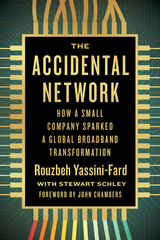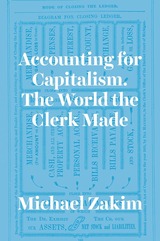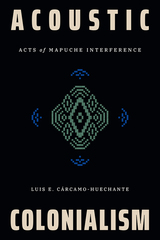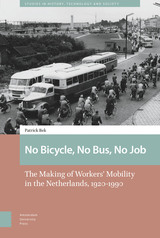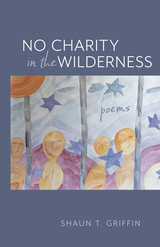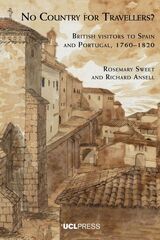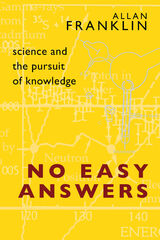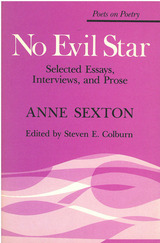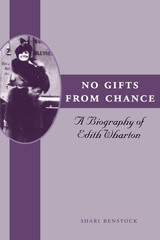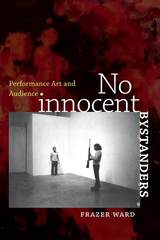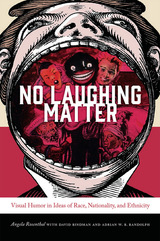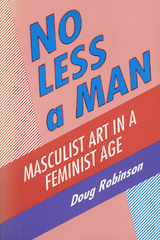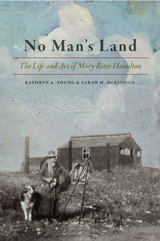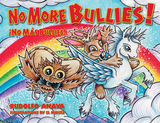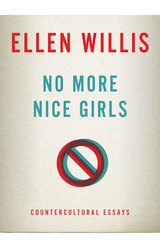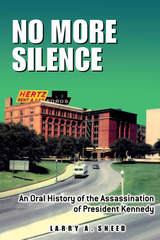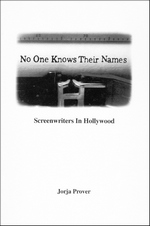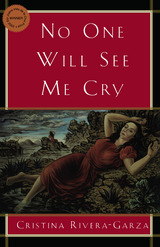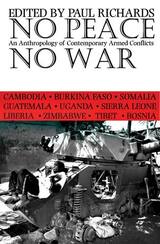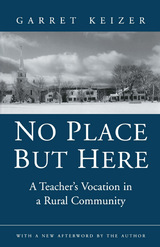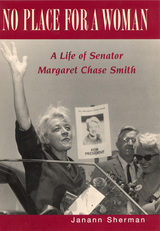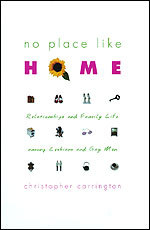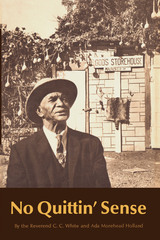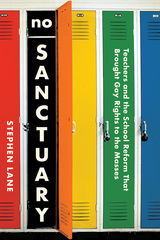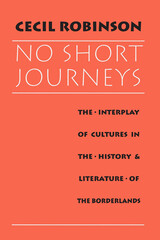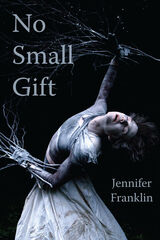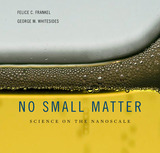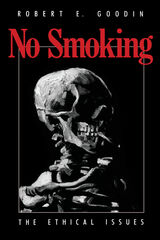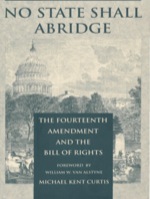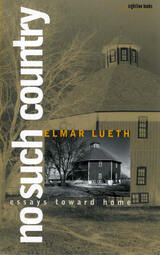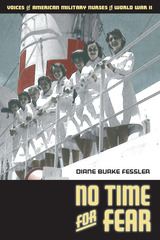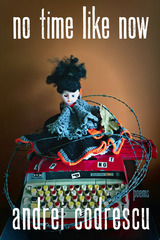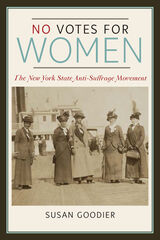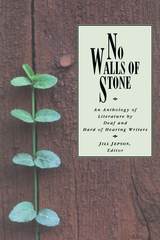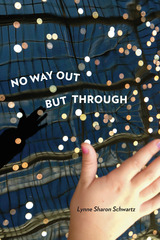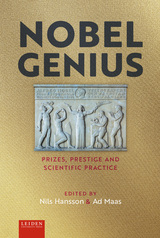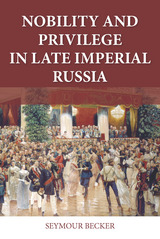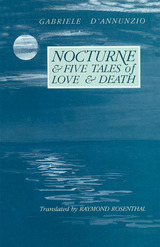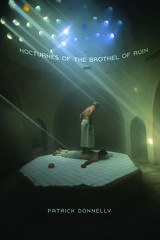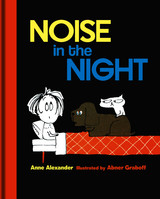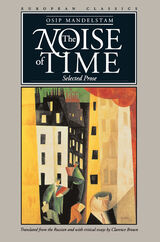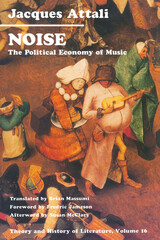 No Average Day: The 24 Hours of October 24, 1944
Rona Simmons
University of Missouri Press, 2024 On Tuesday, October 24, 1944, nearly three years after the United States entered World War II, over 2,600 Americans perished—more than on any other single day of the conflict—yet the day remains overshadowed by more widely remembered dates in WWII history. Drawing from the accounts of men from diverse backgrounds who served in the U.S. Army, Navy, Marines, and Air Corps, Rona Simmons offers a gripping retelling of the fateful day, hour by hour and incident by incident. The book begins with Army Private First Class Paul Miller’s demise in a prisoner of war camp and ends with the death of Navy Seaman Second Class Wanza E. Matthews after the Japanese submarine I-56 attacked his ship off New Guinea. The sinking of the Japanese “hellship” Arisan Maru—a lesser-known tragedy of the war—looms large, deftly interwoven through each part of the narrative.
Perhaps the most compelling aspect of No Average Day is its attention to the human side of conflict, telling the stories of ordinary individuals—clerks, radio operators, cooks, sailors, machinist mates, riflemen, and pilots and their air crews—as they grapple with the horrors of the war. Despite its narrow focus, or perhaps because of it, No Average Day reveals the vastness of World War II through a consideration of the largely overlooked events that unfolded on what, for members of the US Armed Forces, was its deadliest day.
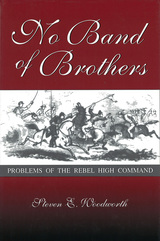 No Band of Brothers: Problems of the Rebel High Command
Steven E. Woodworth
University of Missouri Press, 1999 The Civil War was barely over before Southerners and other students of the war began to examine the Confederate high command in search of an explanation for the South's failure. Although years of research failed to show that the South's defeat was due to a single, overriding cause, the actions of the Southern leaders during the war were certainly among the reasons the South lost the war. In No Band of Brothers, Steven Woodworth explores, through a series of essays, various facets of the way the Confederacy waged its unsuccessful war for secession. He examines Jefferson Davis and some of his more important generals, including Pierre G. T. Beauregard, Leonidas Polk, Joseph E. Johnston, Robert E. Lee, James Longstreet, and Thomas J. "Stonewall" Jackson; the Confederacy's strategic plans; and the South's success in making competent officers out of men with very little military preparation. Woodworth particularly looks at the personalities and personal relationships that affected the course and outcome of the war. What made a good general? What could make an otherwise able man a failure as a general? What role did personal friendships or animosities play in the Confederacy's top command assignments and decisions? How successful was the Confederacy in making competent generals out of its civilian leaders? In what ways did Jefferson Davis succeed or fail in maximizing the chances for the success of his cause? In analyzing the Confederate leadership, Woodworth reveals some weaknesses, many strengths, and much new information. No Band of Brothers will be an important addition to Civil War scholarship and will be welcomed by professional historians, amateur historians, students, and the general reader alike.
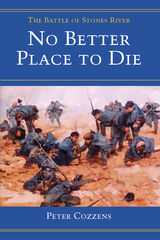 No Better Place to Die: THE BATTLE OF STONES RIVER
Peter Cozzens
University of Illinois Press, 1990 A mere handful of battlefields have come to epitomize the anguish and pain of America's Civil War: Gettysburg, Shiloh, Chancellorsville, Chickamauga. Yet another name belongs on that infamous list: Stones River, the setting for Peter Cozzens's No Better Place to Die.
It was here that both the Union and Confederate armies lost over one-quarter of their forces in battle casualties. The Confederacy's defeat at Stones River unleashed a wave of dissension that crippled the army's high command and ultimately closed Tennessee to the South for two years. The loss deterred the British and French from coming to the aid of the South in the Civil War, with tragic effects for the Southern cause.
In the 126 years since the guns fell silent at Stones River, few books have examined the bloody clash and its impact on the war's subsequent outcome. No Better Place to Die recounts the events and strategies that brought the two armies to the banks of this central Tennessee river on December 31, 1862. Cozzens re-creates the battle itself, following the movements and performance of individual regiments. A series of maps clarifies the combat activity.
Cozzens frequently lets the men who fought the battle speak for themselves, through letters, diaries, memoirs, and battlefield communications. Here we learn about such critical moments as General Philip Sheridan's gallant defense along the Wilkinson Pike, one of the war's most tenacious stands against overwhelming odds, and the bravery in battle exemplified by Brekenridge's attack on the Union left, a doomed assault with the poignancy of Pickett's charge.
Over twenty thousand Union and Confederate soldiers were killed, wounded, or captured in the bloody New Year's battle of Stone's River. The impact of their struggle extended far beyond the thousands of shattered human lives, ultimately imperiling the fortunes of the Confederacy. No Better Place to Die pays tribute to the heroes, the scoundrels, the mistakes, the bravery, and the grief at Stone's River.
No Bicycle, No Bus, No Job: The Making of Workers’ Mobility in the Netherlands, 1920-1990
Patrick Bek
Amsterdam University Press, 2022 For working people, the cost of getting to work, in terms of time and expense, is a crucial aspect of daily life. In the twentieth century, people’s opportunity to travel increased. This did not, however, apply to everyone. The absence of affordable housing near job locations combined with the lack of safe, efficient, and affordable mobility options aggravated social exclusion for some. No Bicycle, No Bus, No Job details how power relations have historically enabled or restricted workers’ mobility in twentieth century Netherlands. Blue-collar workers, industrial employers, and the state shaped workers’ everyday commute in a changing playing field of uneven power relations that shifted from paternalism to neo-liberalism.
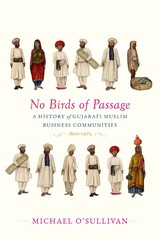 No Birds of Passage: A History of Gujarati Muslim Business Communities, 1800–1975
Michael O’Sullivan
Harvard University Press, 2023 A sweeping account of three Gujarati Muslim trading communities, whose commercial success over nearly two centuries sheds new light on the history of capitalism, Islam, and empire in South Asia.
During the nineteenth century, three Gujarati Muslim commercial castes—the Bohras, Khojas, and Memons—came to dominate Muslim business in South Asia. Although these communities constitute less than 1 percent of South Asia’s Muslim population, they are still disproportionately represented among the region’s leading Muslim-owned firms today. In No Birds of Passage, Michael O’Sullivan argues that the conditions enabling their success have never been understood, thanks to stereotypes—embraced equally by colonial administrators and Muslim commentators—that estrange them from their religious identity. Yet while long viewed as Hindus in all but name, or as “Westernized” Muslims who embraced colonial institutions, these groups in fact entwined economic prerogatives and religious belief in a distinctive form of Muslim capitalism.
Following entrepreneurial firms from Gujarat to the Hijaz, Hong Kong, Mombasa, Rangoon, and beyond, O’Sullivan reveals the importance of kinship networks, private property, and religious obligation to their business endeavors. This paradigm of Muslim capitalism found its highest expression in the jamaats, the central caste institutions of each community, which combined South Asian, Islamicate, and European traditions of corporate life. The jamaats also played an essential role in negotiating the position of all three groups in relation to British authorities and Indian Muslim nationalists, as well as the often-sharp divisions within the castes themselves.
O’Sullivan’s account sheds light on Gujarati Muslim economic life from the dawn of colonial hegemony in India to the crisis of the postcolonial state, and provides fascinating insights into the broader effects of capitalist enterprise on Muslim experience in modern South Asia.
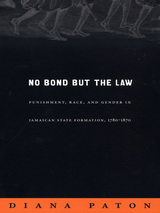 No Bond but the Law: Punishment, Race, and Gender in Jamaican State Formation, 1780–1870
Diana Paton
Duke University Press, 2004 Investigating the cultural, social, and political histories of punishment during ninety years surrounding the 1838 abolition of slavery in Jamaica, Diana Paton challenges standard historiographies of slavery and discipline. The abolition of slavery in Jamaica, as elsewhere, entailed the termination of slaveholders’ legal right to use violence—which they defined as “punishment”—against those they had held as slaves. Paton argues that, while slave emancipation involved major changes in the organization and representation of punishment, there was no straightforward transition from corporal punishment to the prison or from privately inflicted to state-controlled punishment. Contesting the dichotomous understanding of pre-modern and modern modes of power that currently dominates the historiography of punishment, she offers critical readings of influential theories of power and resistance, including those of Michel Foucault, Pierre Bourdieu, and Ranajit Guha. No Bond but the Law reveals the longstanding and intimate relationship between state formation and private punishment. The construction of a dense, state-organized system of prisons began not with emancipation but at the peak of slave-based wealth in Jamaica, in the 1780s. Jamaica provided the paradigmatic case for British observers imagining and evaluating the emancipation process. Paton’s analysis moves between imperial processes on the one hand and Jamaican specificities on the other, within a framework comparing developments regarding punishment in Jamaica with those in the U.S. South and elsewhere. Emphasizing the gendered nature of penal policy and practice throughout the emancipation period, Paton is attentive to the ways in which the actions of ordinary Jamaicans and, in particular, of women prisoners, shaped state decisions.
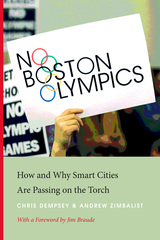 No Boston Olympics: How and Why Smart Cities Are Passing on the Torch
Chris Dempsey and Andrew Zimbalist
University Press of New England, 2017 In 2013 and 2014, some of Massachusetts’ wealthiest and most powerful individuals hatched an audacious plan to bring the 2024 Summer Olympics to Boston. Like their counterparts in cities around the world, Boston’s Olympic boosters promised political leaders, taxpayers, and the media that the Games would deliver incalculable benefits and require little financial support from the public. Yet these advocates refused to share the details of their bid and only grudgingly admitted, when pressed, that their plan called for billions of dollars in construction of unneeded venues. To win the bid, the public would have to guarantee taxpayer funds to cover cost overruns, which have plagued all modern Olympic Games. The United States Olympic Committee (USOC) chose Boston 2024’s bid over that of other American cities in January 2015—and for a time it seemed inevitable that the International Olympic Committee (IOC) would award the Games to Boston 2024. No Boston Olympics is the story of how an ad hoc, underfunded group of diverse and engaged citizens joined together to challenge and ultimately derail Boston’s boosters, the USOC, and the IOC. Chris Dempsey was cochair of No Boston Olympics, the group that first voiced skepticism, demanded accountability, and catalyzed dissent. Andrew Zimbalist is a world expert on the economics of sports, and the leading researcher on the hidden costs of hosting mega-events such as the Olympics and the World Cup. Together, they tell Boston’s story, while providing a blueprint for citizens who seek to challenge costly, wasteful, disruptive, and risky Olympic bids in their own cities.
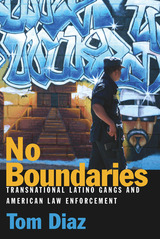 No Boundaries: Transnational Latino Gangs and American Law Enforcement
Tom Diaz
University of Michigan Press, 2011 "Tom Diaz has worn out some shoe leather, much like a good detective, in gathering facts, not myths or urban legends. As a result he has produced an accurate and comprehensive look at a grave and present danger to our society."
---From the foreword by Chris Swecker, former Assistant Director of the FBI and former head of the FBI's Criminal Investigative Division No Boundaries is a disturbing account of what many consider the "next Mafia"---Latino crime gangs. Like the Mafia, these gangs operate an international network, consider violence a routine matter, and defy U.S. law enforcement at every level. Also, the gangs spawn kingpins such as the notorious Nelson Martinez Varela Comandari, who nearly became the first "Latin godfather" in the United States. Focusing on the Los Angeles–based Mara Salvatrucha (MS-13) and the 18th Street Gang, and the Chicago-based Latin Kings, Tom Diaz describes how neighborhood gangs evolved into extremely brutal, sophisticated criminal enterprises and how local and federal authorities have struggled to suppress them. As he makes clear, the problem of transnational Latino gangs involves complex national and international issues, such as racial tensions, immigration policy, conflict in Latin America, and world economic pressures. Tom Diaz is a lawyer, author, and public speaker who conducts research on gun policy and violence for the Violence Policy Center, a Washington, D.C.–based think tank. He has covered national security affairs for the Washington Times and served as counsel to the U.S. House Subcommittee on Crime and Criminal Justice from 1993 to 1997. Cover photograph: Tegucigalpa, Honduras: A policeman passes by a graffiti of the Mara Salvatrucha "MS-13" (juvenile gang) at the entrance of the unit where members of the gang are kept imprisoned in the National Penitentiary in Tamara, 30 km north of Tegucigalpa, February 1, 2006. © Elmer Martinez/AFP/Getty Images
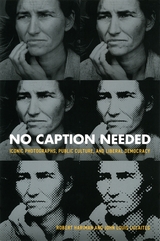 No Caption Needed: Iconic Photographs, Public Culture, and Liberal Democracy
Robert Hariman and John Louis Lucaites
University of Chicago Press, 2007 In No Caption Needed, Robert Hariman and John Louis Lucaites provide the definitive study of the iconic photograph as a dynamic form of public art. Their critical analyses of nine individual icons explore the photographs themselves and their subsequent circulation through an astonishing array of media, including stamps, posters, billboards, editorial cartoons, TV shows, Web pages, tattoos, and more. Iconic images are revealed as models of visual eloquence, signposts for collective memory, means of persuasion across the political spectrum, and a crucial resource for critical reflection.
Arguing against the conventional belief that visual images short-circuit rational deliberation and radical critique, Hariman and Lucaites make a bold case for the value of visual imagery in a liberal-democratic society. No Caption Needed is a compelling demonstration of photojournalism’s vital contribution to public life.
No Charity in the Wilderness: Poems
Shaun T. Griffin
University of Nevada Press, 2024 No Charity in the Wilderness is a long journey into the new American West. From the southern border to the isolating two-lane highways in the desert, this collection is a prayer of reconciliation with so much that troubles us—those who live without resources or voices—and their possible future in this ever-changing landscape of desire.
Griffin has spent many decades in the high desert trying to find the way forward—when what he knows has been challenged and still there is breath on the horizon. One day an ancient Chinese poet comes to visit: "Snow deepens/ to quiet what I once believed, and Wang Wei stoops from the spine:/ this is how you become silence." Even if you doubt the old poet's counsel, like Griffin, you want to journey with him into the wilderness.
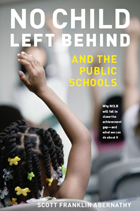 No Child Left Behind and the Public Schools
Scott Franklin Abernathy
University of Michigan Press, 2007 “A powerful, detailed, and exceptionally balanced critique of NCLB. It offers some hope for how we might overcome its faults. No legislator or educational expert should be allowed to get away with not reading it—whether to agree or disagree. It’s a must learning experience.” —Deborah Meier, Senior Scholar and Adjunct Professor, Steinhardt School of Education, New York University, and author of In Schools We Trust “A concise, highly readable, and balanced account of NCLB, with insightful and realistic suggestions for reform. Teachers, professors, policymakers, and parents—this is the one book about NCLB you ought to read.” —James E. Ryan, William L. Matheson and Robert M. Morgenthau Distinguished Professor, University of Virginia School of Law This far-reaching new study looks at the successes and failures of one of the most ambitious and controversial educational initiatives since desegregation—the No Child Left Behind Act of 2001. NCLB’s opponents criticize it as underfunded and unworkable, while supporters see it as a radical but necessary educational reform that evens the score between advantaged and disadvantaged students. Yet the most basic and important question remains unasked: “Can we ever really know if a child’s education is good?” Ultimately, Scott Franklin Abernathy argues, policymakers must begin from this question, rather than assuming that any test can accurately measure the elusive thing we call “good” education.
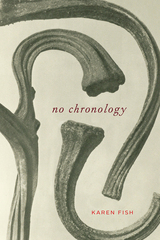 No Chronology
Karen Fish
University of Chicago Press, 2021 In No Chronology, Karen Fish’s third collection of poems, she investigates those moments when the boundary of everyday life merges with history, imagination, and art. Fish was trained as a visual artist, and this way of seeing is intrinsic to her approach to poetry. Fish’s reflections on art and life speak to our common experiences, and her power to illuminate the subtle complexities of the world around us lies in her keen and compassionate observations. These poems invite us to join her in looking both at and beyond ourselves. The outside world vanishes. No help comes.
Imagine, staring into the sun, then,
how the clouds spread out and open like wallets
over a few corrugated roofs.
Throughout this collection, Fish seeks truths about memory and loss, shame and redemption. She faces uncomfortable questions arising from our individual and collective actions, asking whether we are complicit in extinctions of species and how we reduce the humanity of prisoners by tying their identity to their crime. But these poems are also about naming life’s particular joys: driving in spring, walking through the woods with dogs, or hearing a child speak through the mail slot. They offer a space to encounter lyrical meditation as an experience in and of itself.
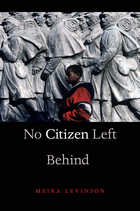 No Citizen Left Behind
Meira Levinson
Harvard University Press, 2012 While teaching at an all-Black middle school in Atlanta, Meira Levinson realized that students’ individual self-improvement would not necessarily enable them to overcome their profound marginalization within American society. This is because of a civic empowerment gap that is as shameful and antidemocratic as the academic achievement gap targeted by No Child Left Behind. No Citizen Left Behind argues that students must be taught how to upend and reshape power relationships directly, through political and civic action. Drawing on political theory, empirical research, and her own on-the-ground experience, Levinson shows how de facto segregated urban schools can and must be at the center of this struggle.
Recovering the civic purposes of public schools will take more than tweaking the curriculum. Levinson calls on schools to remake civic education. Schools should teach collective action, openly discuss the racialized dimensions of citizenship, and provoke students by engaging their passions against contemporary injustices. Students must also have frequent opportunities to take civic and political action, including within the school itself. To build a truly egalitarian society, we must reject myths of civic sameness and empower all young people to raise their diverse voices. Levinson’s account challenges not just educators but all who care about justice, diversity, or democracy.
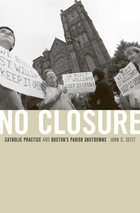 No Closure: Catholic Practice and Boston's Parish Shutdowns
John C. Seitz
Harvard University Press, 2011 In 2004 the Roman Catholic Archdiocese of Boston announced plans to close or merge more than eighty parish churches. Scores of Catholics—28,000, by the archdiocese’s count—would be asked to leave their parishes. The closures came just two years after the first major revelations of clergy sexual abuse and its cover up. Wounds from this profound betrayal of trust had not healed.
In the months that followed, distraught parishioners occupied several churches in opposition to the closure decrees. Why did these accidental activists resist the parish closures, and what do their actions and reactions tell us about modern American Catholicism? Drawing on extensive fieldwork and with careful attention to Boston’s Catholic history, Seitz tells the stories of resisting Catholics in their own words, and illuminates how they were drawn to reconsider the past and its meanings. We hear them reflect on their parishes and the sacred objects and memories they hold, on the way their personal histories connect with the history of their neighborhood churches, and on the structures of authority in Catholicism.
Resisters describe how they took their parishes and religious lives into their own hands, and how they struggled with everyday theological questions of respect and memory; with relationships among religion, community, place, and comfort; and with the meaning of the local church. No Closure is a story of local drama and pathos, but also a path of inquiry into broader questions of tradition and change as they shape Catholics’ ability to make sense of their lives in a secular world.
 No Collar: The Humane Workplace And Its Hidden Costs
Andrew Ross
Temple University Press, 2004 While the internet bubble has burst, the New Economy that the internet produced is still with us, along with the myth of a workplace built around more humane notions of how people work and spend their days in offices. No-Collar is the only close study of New Economy workplaces in their heyday. Andrew Ross, a renowned writer and scholar of American intellectual and social life, spent eighteen months deep inside Silicon Alley in residence at two prominent New Economy companies, Razorfish and 360hiphop, and interviewed a wide range of industry employees in other cities to write this remarkable book. Maverick in their organizations and permissive in their culture, these workplaces offered personal freedoms and rewards that were unheard of in corporate America. Employees feared they may never again enjoy such an irresistible work environment. Yet for every apparent benefit, there appeared to be a hidden cost: 70-hour workweeks, a lack of managerial protection, an oppressive shouldering of risk by employees, an illusory sense of power sharing, and no end of emotional churning. The industrialization of bohemia encouraged employees to think outside the box, but also allowed companies to claim their most free and creative thoughts and ideas. In these workplaces, Andrew Ross encountered a new kind of industrial personality, and emerged with a sobering lesson. Be careful what you wish for. When work becomes sufficiently humane, we tend to do far too much of it, and it usurps an unacceptable portion of our lives. He concludes that we should not have to choose between a personally gratifying and a just workplace, we should strive to enjoy both.
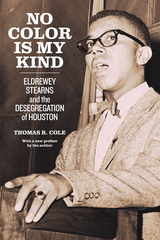 No Color Is My Kind: Eldrewey Stearns and the Desegregation of Houston
Thomas R. Cole
University of Texas Press, 2021 In 1959, a Black man named Eldrewey Stearns was beaten by Houston police after being stopped for a traffic violation. He was not the first to suffer such brutality, but the incident sparked Stearns’s conscience and six months later he was leading the first sit-in west of the Mississippi River. No Color Is My Kind, first published in 1997, introduced readers to Stearns, including his work as a civil rights leader and lawyer in Houston’s desegregation movement between 1959 and 1963. This remarkable and important history, however, was nearly lost to bipolar affective disorder. Stearns was a fifty-two-year-old patient in a Galveston psychiatric hospital when Thomas Cole first met him in 1984. Over the course of a decade, Cole and Stearns slowly recovered the details of Stearns’s life before his slide into mental illness, writing a story that is more relevant today than ever. In this new edition, Cole fills in the gaps between the late 1990s and now, providing an update on the progress of civil rights in Houston and Stearns himself. He also reflects on his tumultuous and often painful collaboration with Stearns, challenging readers to be part of his journey to understand the struggles of a Black man’s complex life. At once poignant, tragic, and emotionally charged, No Color Is My Kind is essential reading as the current movement for racial reconciliation gathers momentum.
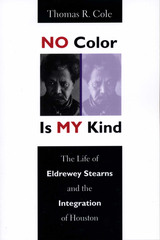 No Color Is My Kind: The Life of Eldrewey Stearns and the Integration of Houston
By Thomas R. Cole
University of Texas Press, 1997 No Color Is My Kind is an uncommon chronicle of identity, fate, and compassion as two men—one Jewish and one African American—set out to rediscover a life lost to manic depression and alcoholism. In 1984, Thomas Cole discovered Eldrewey Stearns in a Galveston psychiatric hospital. Stearns, a fifty-two-year-old black man, complained that although he felt very important, no one understood him. Over the course of the next decade, Cole and Stearns, in a tumultuous and often painful collaboration, recovered Stearns’ life before his slide into madness—as a young boy in Galveston and San Augustine and as a civil rights leader and lawyer who sparked Houston’s desegregation movement between 1959 and 1963. While other southern cities rocked with violence, Houston integrated its public accommodations peacefully. In these pages appear figures such as Thurgood Marshall, Martin Luther King, Jr., Leon Jaworski, and Dan Rather, all of whom—along with Stearns—maneuvered and conspired to integrate the city quickly and calmly. Weaving the tragic story of a charismatic and deeply troubled leader into the record of a major historic event, Cole also explores his emotionally charged collaboration with Stearns. Their poignant relationship sheds powerful and healing light on contemporary race relations in America, and especially on issues of power, authority, and mental illness.
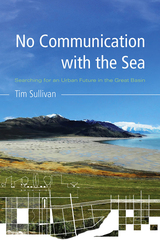 No Communication with the Sea: Searching for an Urban Future in the Great Basin
Tim Sullivan
University of Arizona Press, 2010 Few other places in the United States are as high, dry, sparsely inhabited—and urbanized—as the Great Basin of Utah and Nevada. The great majority of the population of this rapidly growing region lives in the two metropolitan areas at its edges, Salt Lake City and the Wasatch Front, and Reno and the Truckee Meadows. These cities embody the allure and the challenge of the contemporary American West, deemed by some “The New American Heartland.”
No Communication with the Sea is a journey through this urbanizing Great Basin landscape. Here, the land fosters illusions of limitless space and resources, but its space and resources are severely limited; its people live clustered in cities but are often reluctant to embrace urbanity. These tensions led journalist and urban planner Tim Sullivan to explore the developing centers and edges of the Great Basin cities and the ways some are trying to build livable and sustainable urban environments.
In this highly readable book of creative nonfiction, Sullivan employs a variety of methods—including interviews, research, travelogues, and narrative—to survey the harsh landscape for clues to the ways cities can adapt to their geography, topography, ecology, hydrography, history, and culture. No Communication with the Sea embarks on a quest for a livable future for the heart of the interior West. In the process, it both unearths the past and ponders the present and future Great Basin cities.
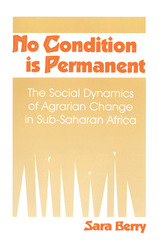 No Condition Is Permanent: The Social Dynamics of Agrarian Change in Sub-Saharan Africa
Sara S. Berry
University of Wisconsin Press, 1993 “No condition is permanent,” a popular West African slogan, expresses Sara S. Berry’s theme: the obstacles to African agrarian development never stay the same. Her book explores the complex way African economy and society are tied to issues of land and labor, offering a comparative study of agrarian change in four rural economies in sub-Saharan Africa, including two that experienced long periods of expanding peasant production for export (southern Ghana and southwestern Nigeria), a settler economy (central Kenya), and a rural labor reserve (northeastern Zambia).
The resources available to African farmers have changed dramatically over the course of the twentieth century. Berry asserts that the ways resources are acquired and used are shaped not only by the incorporation of a rural area into colonial (later national) and global political economies, but also by conflicts over culture, power, and property within and beyond rural communities. By tracing the various debates over rights to resources and their effects on agricultural production and farmers’ uses of income, Berry presents agrarian change as a series of on-going processes rather than a set of discrete “successes” and “failures.”
No Condition Is Permanent enriches the discussion of agrarian development by showing how multidisciplinary studies of local agrarian history can constructively contribute to development policy. The book is a contribution both to African agrarian history and to debates over the role of agriculture in Africa’s recent economic crises.
No Country for Travellers?: British Visitors to Spain and Portugal, 1760–1820
Rosemary Sweet and Richard Ansell
University College London, 2025 A reexamination of British engagement with Iberia in the eighteenth and nineteenth centuries.
Using extensive archival and printed sources left by contemporary travelers, No Country for Travellers? explores the rise and nature of British travel to Spain and Portugal in the late eighteenth and early nineteenth centuries. Not only is it the first book to address the trend of travelers to the Iberian Peninsula during this time, revealing the extent of British interest in Islamic Spain before the Romantic era, but it also brings to light the role of non-combatant travelers to Iberia during the Peninsular War. Beyond uncovering a previously overlooked dimension of the Peninsular War, this history contends with stereotypes of Iberia that were embedded in early modern confessional and civilizational hierarchies.
 No Coward Soldiers: Black Cultural Politics in Postwar America
Waldo E. Martin Jr.
Harvard University Press, 2005 In a vibrant and passionate exploration of the twentieth-century civil rights and black power eras in American history, Waldo Martin uses cultural politics as a lens through which to understand the African-American freedom struggle.
In black culture, argues Martin, we see the debate over the profound tension at the core of black identity: the duality of being at once both American and African. And in the transformative postwar period, the intersection between culture and politics became increasingly central to the African-American fight for equality. In freedom songs, in the exuberance of an Aretha Franklin concert, in Faith Ringgold’s exploration of race and sexuality, the personal and social became the political.
Martin explores the place of black culture in this vision and examines the multiple ways in which various forms of expressive culture and African-American cultural figures influenced consciousness and helped effect social action. From the music of John Coltrane and James Brown to the visual art of Jacob Lawrence and Betye Saar to the dance movements of Alvin Ailey and Arthur Mitchell, Martin discusses how, why, and with what consequences culture became a critical battle site in the freedom struggle. And in a fascinating epilogue, he draws the thread of black cultural politics into today’s hip-hop culture.
This engaging book brings a new perspective to the civil rights and black power eras, while illuminating the broader history of American and global freedom struggles.
No Day at the Beach
John Brehm
University of Wisconsin Press, 2020 With his trademark self-deprecating wit, unflinching honesty, and sparkling language, John Brehm’s latest collection invites readers along on his spiritual journey. No Day at the Beach traces a progression from loneliness and the magnetic pull of the past to the grace that is found through immersion in the present and the melancholy beauty of impermanence. Informed by Brehm’s Buddhist practice and enlivened by his comic insights, these poems take on a universal dimension, allowing the reader to both luxuriate in the moment and reflect on each poem’s spiritual depth.
By turns playfully philosophical and bracingly open hearted, Brehm’s engagement with the specters of memory, pride, yearning, gain, and loss illuminate the human condition with humor and empathy.
No Day without a Line: From Notebooks by Yury Olesha
Yury Olesha
Northwestern University Press, 1998 First published in 1965 and reprinted many times in the U.S.S.R. and Russia, No Day without a Line is a series of thematically assembled journal entries which together form an unusual and engaging personal memoir. Ranging from Olsesha's prerevolutionary childhood, to notable cultural figures, to Russian and Western literature, the entries are a fundamental piece of the legacy of a major Russian writer and an important contribution to the literature of autobiography and memoir.
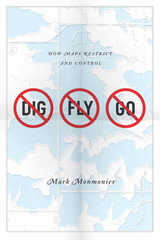 No Dig, No Fly, No Go: How Maps Restrict and Control
Mark Monmonier
University of Chicago Press, 2010 Some maps help us find our way; others restrict where we go and what we do. These maps control behavior, regulating activities from flying to fishing, prohibiting students from one part of town from being schooled on the other, and banishing certain individuals and industries to the periphery. This restrictive cartography has boomed in recent decades as governments seek regulate activities as diverse as hiking, building a residence, opening a store, locating a chemical plant, or painting your house anything but regulation colors. It is this aspect of mapping—its power to prohibit—that celebrated geographer Mark Monmonier tackles in No Dig, No Fly, No Go.
Rooted in ancient Egypt’s need to reestablish property boundaries following the annual retreat of the Nile’s floodwaters, restrictive mapping has been indispensable in settling the American West, claiming slices of Antarctica, protecting fragile ocean fisheries, and keeping sex offenders away from playgrounds. But it has also been used for opprobrium: during one of the darkest moments in American history, cartographic exclusion orders helped send thousands of Japanese Americans to remote detention camps. Tracing the power of prohibitive mapping at multiple levels—from regional to international—and multiple dimensions—from property to cyberspace—Monmonier demonstrates how much boundaries influence our experience—from homeownership and voting to taxation and airline travel. A worthy successor to his critically acclaimed How to Lie with Maps, the book is replete with all of the hallmarks of a Monmonier classic, including the wry observations and witty humor.
In the end, Monmonier looks far beyond the lines on the page to observe that mapped boundaries, however persuasive their appearance, are not always as permanent and impermeable as their cartographic lines might suggest. Written for anyone who votes, owns a home, or aspires to be an informed citizen, No Dig, No Fly. No Go will change the way we look at maps forever.
No Doubt the Nameless
Sydney Lea
Four Way Books, 2016 No Doubt the Nameless delves the depths of elegy, yet moves at last into a positive reading of the human situation. Here are familiar rural characters, whose sturdiness and joy figure as strongly into Lea’s narratives, both overt and implied, as do their trials and misfortunes.
No Easy Answers: Science and the Pursuit of Knowledge
Allan Franklin
University of Pittsburgh Press, 2007 In No Easy Answers, Allan Franklin offers an accurate picture of science to both a general reader and to scholars in the humanities and social sciences who may not have any background in physics. Through the examination of nontechnical case studies, he illustrates the various roles that experiment plays in science. He uses examples of unquestioned success, such as the discoveries of the electron and of three types of neutrino, as well as studies that were dead ends, wrong turns, or just plain mistakes, such as the “fifth force,” a proposed modification of Newton's law of gravity. Franklin argues that science is a reasonable enterprise that provides us with knowledge of the natural world based on valid experimental evidence and reasoned and critical discussion, and he makes clear that it behooves all of us to understand how it works.
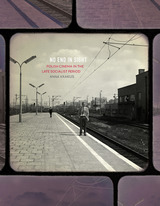 No End in Sight: Polish Cinema in the Late Socialist Period
Anna Krakus
University of Pittsburgh Press, 2018 No End in Sight offers a critical analysis of Polish cinema and literature during the transformative late Socialist period of the 1970s and 1980s. Anna Krakus details how conceptions of time, permanence, and endings shaped major Polish artistic works. She further demonstrates how film and literature played a major role in shaping political consciousness during this highly-charged era. Despite being controlled by an authoritarian state and the doctrine of socialism, artists were able to portray the unsettled nature of the political and psychological climate of the period, and an undetermined future.
In analyzing films by Andrzej Wajda, Krzysztof Kieslowsi, Krzysztof Zanussi, Wojciech Has, and Tadeusz Konwicki alongside Konwicki’s literary production, Anna Krakus identifies their shared penchant to defer or completely eschew narrative closure, whether in plot, theme, or style. Krakus calls this artistic tendency "aesthetic unfinalizability." As she reveals, aesthetic unfinalizability was far more than an occasional artistic preference or a passing trend; it was a radical counterpolitical act. The obsession with historical teleology saturated Polish public life during socialism to such a degree that instances of nonclosure or ambivalent endings emerged as polemical responses to official ideology.
 No Enemies, No Hatred: Selected Essays and Poems
Liu Xiaobo
Harvard University Press, 2012 When the Nobel Peace Prize was awarded on December 10, 2010, its recipient, Liu Xiaobo, was in Jinzhou Prison, serving an eleven-year sentence for what Beijing called “incitement to subvert state power.” In Oslo, actress Liv Ullmann read a long statement the activist had prepared for his 2009 trial. It read in part: “I stand by the convictions I expressed in my ‘June Second Hunger Strike Declaration’ twenty years ago—I have no enemies and no hatred. None of the police who monitored, arrested, and interrogated me, none of the prosecutors who indicted me, and none of the judges who judged me are my enemies.”
That statement is one of the pieces in this book, which includes writings spanning two decades, providing insight into all aspects of Chinese life. These works not only chronicle a leading dissident’s struggle against tyranny but enrich the record of universal longing for freedom and dignity. Liu speaks pragmatically, yet with deep-seated passion, about peasant land disputes, the Han Chinese in Tibet, child slavery, the CCP’s Olympic strategy, the Internet in China, the contemporary craze for Confucius, and the Tiananmen massacre. Also presented are poems written for his wife, Liu Xia, public documents, and a foreword by Václav Havel.
This collection is an aid to reflection for Western readers who might take for granted the values Liu has dedicated his life to achieving for his homeland.
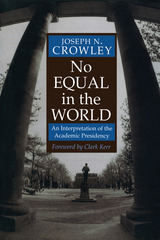 No Equal In The World: An Interpretation Of The Academic Presidency
Joseph N. Crowley
University of Nevada Press, 1994 No Equal in the World is a comprehensive study of the literature on the American academic presidency from the middle of the nineteenth century—when the first universities, as distinct from colleges, began to emerge—to the present. The book surveys widely divergent literature on the biographies of major presidents at crucial moments in the history of their institutions. The book affords an overview of the development of both the role of the university president and the public’s perception of that role, and indicates where perception and reality diverge. At a time when university presidents must find their way through a minefield of increasingly heated debates over issues such as free speech, curriculum, faculty diversity, and the specter of “political correctness,” Crowley’s book provides a sense of history to those striving to understand the demands of the position. It is an invaluable resource for scholars.
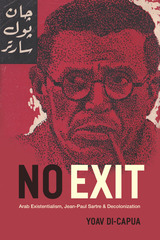 No Exit: Arab Existentialism, Jean-Paul Sartre, and Decolonization
Yoav Di-Capua
University of Chicago Press, 2018 It is a curious and relatively little-known fact that for two decades—from the end of World War II until the late 1960s—existentialism’s most fertile ground outside of Europe was in the Middle East, and Jean-Paul Sartre was the Arab intelligentsia’s uncontested champion. In the Arab world, neither before nor since has another Western intellectual been so widely translated, debated, and celebrated.
By closely following the remarkable career of Arab existentialism, Yoav Di-Capua reconstructs the cosmopolitan milieu of the generation that tried to articulate a political and philosophical vision for an egalitarian postcolonial world. He tells this story by touring a fascinating selection of Arabic and Hebrew archives, including unpublished diaries and interviews. Tragically, the warm and hopeful relationships forged between Arab intellectuals, Sartre, Simone de Beauvoir, and others ended when, on the eve of the 1967 war, Sartre failed to embrace the Palestinian cause. Today, when the prospect of global ethical engagement seems to be slipping ever farther out of reach, No Exit provides a timely, humanistic account of the intellectual hopes, struggles, and victories that shaped the Arab experience of decolonization and a delightfully wide-ranging excavation of existentialism’s non-Western history.
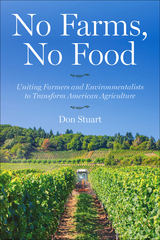 No Farms, No Food: Uniting Farmers and Environmentalists to Transform American Agriculture
Don Stuart
Island Press, 2022 America’s farms are key to the preservation of vital ecosystems and a stable climate. Yet farmers and environmentalists have not always seen eye-to-eye about the best ways to manage agricultural landscapes. Since 1980, American Farmland Trust (AFT) has been bringing people together to work for healthy land and a healthy food system.
No Farms, No Food traces the development of this powerful coalition responsible for landmark achievements in farmland preservation and conservation practices. It all began with Peggy Rockefeller’s determination to stop the inexorable urban sprawl that was threatening the nation’s agriculture. From this humble start grew a small but astute organization, and more importantly, a formidable constituency of farmers and environmentalists united around a common cause.
With leadership from AFT, that constituency drove through Congress the first “Conservation Title” in the history of the U.S. Farm Bill; oversaw the development of agriculture conservation easement programs throughout the country; and continues to develop innovative approaches to sustainable agriculture.
No Farms, No Food takes readers inside the political and policy battles that determine the fate of our nation’s farmland. And it illustrates the tactics needed to unify fractured interest groups for the common good. No Farms, No Food is both an inspiring history of agricultural conservation and a practical guide to creating an effective advocacy organization. This is an essential read for everyone who cares about the future of our food, farms, and environment.
 No Five Fingers Are Alike: Cognitive Amplifiers in Social Context
Joseph C. Berland
Harvard University Press, 1982 Snake charmers, bards, acrobats, magicians, trainers of performing animals, and other nomadic artisans and entertainers have been a colorful and enduring element in societies throughout the world. Their flexible social system, based on highly specialized individual skills and spatial mobility, contrasts sharply with the more rigid social system of sedentary peasants and traditional urban dwellers. Joseph Berland brings into focus the ethnographic and psychological differences between nomadic and sedentary groups by examining how the experiences of South Asian gypsies and their urban counterparts contribute to basic perceptual habits and skills.
No Five Fingers Are Alike, based on three years of participant research among rural Pakistani groups, provides the first detailed description in print of Asian gypsies. By applying methods of anthropological observation as well as psychological experimentation, Berland develops a theory about the relationship between social experience and mental growth. He suggests that there are certain social conditions under which mental growth can be accelerated. His work promises to stand as an important contribution to the cross-cultural literature on cognitive development.
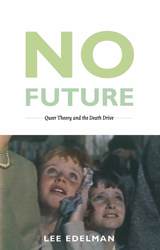 No Future: Queer Theory and the Death Drive
Lee Edelman
Duke University Press, 2004 In this searing polemic, Lee Edelman outlines a radically uncompromising new ethics of queer theory. His main target is the all-pervasive figure of the child, which he reads as the linchpin of our universal politics of “reproductive futurism.” Edelman argues that the child, understood as innocence in need of protection, represents the possibility of the future against which the queer is positioned as the embodiment of a relentlessly narcissistic, antisocial, and future-negating drive. He boldly insists that the efficacy of queerness lies in its very willingness to embrace this refusal of the social and political order. In No Future, Edelman urges queers to abandon the stance of accommodation and accede to their status as figures for the force of a negativity that he links with irony, jouissance, and, ultimately, the death drive itself. Closely engaging with literary texts, Edelman makes a compelling case for imagining Scrooge without Tiny Tim and Silas Marner without little Eppie. Looking to Alfred Hitchcock’s films, he embraces two of the director’s most notorious creations: the sadistic Leonard of North by Northwest, who steps on the hand that holds the couple precariously above the abyss, and the terrifying title figures of The Birds, with their predilection for children. Edelman enlarges the reach of contemporary psychoanalytic theory as he brings it to bear not only on works of literature and film but also on such current political flashpoints as gay marriage and gay parenting. Throwing down the theoretical gauntlet, No Future reimagines queerness with a passion certain to spark an equally impassioned debate among its readers.
 No Germs Allowed!: How to Avoid Infectious Diseases At Home and on the Road
Weinberg, Winkler G
Rutgers University Press, 1996 AIDS, tuberculosis, hepatitis, chickenpox, malaria, Lyme disease, salmonella, strep throat-no matter where you go or where you live, you are at risk from infectious disease. But there are ways you can protect yourself and your family! The revised and expanded edition of this classic guide explains what you need to know to keep the germs away. From the infections of daily life, like the common cold and traveler's diarrhea, to dangerous, rare diseases such as plague, hantavirus, and invasive strep bacteria, to recent threats of mad cow disease, West Nile virus, SARS, and bioterrorism, this unique guide tells you: - your chances of getting sick
- simple precautions you can take
- which vaccinations and shots are worthwhile
- how to avoid catching infections in the hospital
- special precautions to take if you are pregnant
- how to ward off infections even if you have chronic health problems or are HIV positive
- how to keep well while traveling
- what to eat-and not eat-on the road
- symptoms that signal trouble
- what illnesses you can get from bug bites and animals
- how to prevent sexually transmitted diseases
- who should get flu shots and why
- why you should see your doctor before you get sick
Dr. Winkler G. Weinberg lets you know what you need to worry about and what you don't.
No Gifts from Chance: A Biography of Edith Wharton
By Shari Benstock
University of Texas Press, 2004 The first new biography of America's foremost woman of letters in twenty years, No Gifts from Chance presents an Edith Wharton for our times. Far from the emotionally withdrawn and neurasthenic victim of earlier portraits, she is revealed here as an ambitious, disciplined, and self-determined woman who fashioned life to her own desires. Drawing on government records, legal and medical documents, and recently opened collections of Wharton's letters, Shari Benstock's biography offers new information on what have been called the key mysteries of her life: the question of her paternity, her troubled relations with her mother and older brothers, her marriage to manic-depressive Teddy Wharton, and her extramarital affair with Morton Fullerton.
 No God but Man: On Race, Knowledge, and Terrorism
Atiya Husain
Duke University Press, 2025 Reconceptualizing the relationship between race and Islam in the United States, No God but Man theorizes race as an epistemology using the FBI’s post-9/11 Most Wanted Terrorist list and its posters as its starting point. Atiya Husain traces the origins of the FBI wanted poster form to the work of nineteenth-century social scientist Adolphe Quetelet, specifically his overvalued type of human called “average man.” Husain argues that this notion of the human continues to structure wanted posters, as well as much contemporary social scientific thinking about race. Focusing on the curious representations on the Most Wanted Terrorist list that range from Muslims who lack a race category on their posters to the 2013 addition of Black revolutionary Assata Shakur, Husain demonstrates the ongoing influence of the average man and its relevance even today, proposing a counterweight to the category by engaging Shakur’s turn to Islam in the 1970s in the legal context. In doing so, Husain shows the limitations of race as an analytical category altogether.
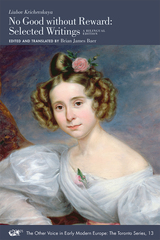 No Good without Reward: Selected Writings: A Bilingual Edition
Liubov Krichevskaya
Iter Press, 2011 A female contemporary of Alexander Pushkin, Liubov Krichevskaya makes her Anglophone debut in an excellent translation of her fiction, drama, and poetry, which deftly capture women’s estate in the early nineteenth century. Krichevskaya intriguingly combines Sentimentalist preoccupations—sensibility, virtue, and men’s moral reformation through confrontation with exemplary women’s passive piety—with the uncontrollable passions and volatile hero popularized by the Byronic strain of Romanticism. Her gynocentric texts poignantly convey the stringent limitations imposed upon women’s agency by a society that paradoxically credited them with the seemingly limitless capacity to exert a civilizing influence as icons of probity. Readers acquainted with Rousseau, Richardson, and Goethe will discover familiar feminized turf, but cultivated in a Russian vein.
—Helena Goscilo
Chair and Professor of Slavic, The Ohio State University
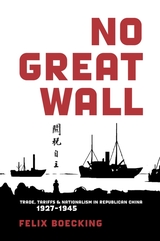 No Great Wall: Trade, Tariffs, and Nationalism in Republican China, 1927–1945
Felix Boecking
Harvard University Press, 2017 This book, an in-depth study of Nationalist tariff policy, fundamentally challenges the widely accepted idea that the key to the Communist seizure of power in China lay in the incompetence of Chiang Kai-shek’s Nationalist government. It argues instead that during the second Sino-Japanese War, China’s international trade, the Nationalist government’s tariff revenues, and hence its fiscal policy and state-making project all collapsed.
Because tariffs on China’s international trade produced the single greatest share of central government revenue during the Nanjing decade, the political existence of the Nationalist government depended on tariff revenue. Therefore, Chinese economic nationalism, both at the official and popular levels, had to be managed carefully so as not to jeopardize the Nationalist government’s income. Until the outbreak of war in 1937, the Nationalists’ management of international trade and China’s government finances was largely successful in terms of producing increasing and sustainable revenues. Within the first year of war, however, the Nationalists lost territories producing 80 percent of tariff revenue. Hence, government revenue declined just as war-related expenditure increased, and the Nationalist government had to resort to more rapacious forms of revenue extraction—a decision that had disastrous consequences for both its finances and its political viability.
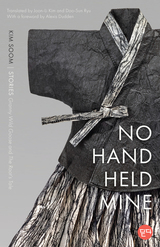 No Hand Held Mine: Stories — "Granny Wild Goose" and "The Root's Tale"
Kim Soom
Rutgers University Press, 2026 An elderly Korean woman talking about being forced into sexual slavery during World War II. A modern Korean woman extricating herself from a failing relationship with an artist. Award-winning South Korean writer Kim Soom presents us with portraits of two women who couldn’t be more different but who both show resilience and compassion. No Hand Held Mine: Stories, containing one non-fiction piece and one short story, demonstrates the power and breadth of Kim’s writing. “Granny Wild Goose” uses former Comfort Woman Gil Won-Ok’s own words, recorded during conversations with Kim, to tell her life story of brutality, betrayal, and survival. In “The Root’s Tale,” the female protagonist comes to understand the strength of solitary women. Both devastating and reaffirming, No Hand Held Mine shows why Kim Soom has received every major literary award in Korea. Joon-Li Kim and Doo-Sun Ryu’s sensitive translation maintains Kim’s lyricism and exquisite imagery.
This book is published with the support of The Daesan Foundation.
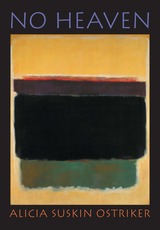 No Heaven
Alicia Ostriker
University of Pittsburgh Press, 2005
Alicia Suskin Ostriker's voice has long been acknowledged as a major force in American poetry. In No Heaven, her eleventh collection, she takes a hint from John Lennon's "Imagine" to wrestle with the world as it is: "no hell below us, / above us only sky."
It is a world of cities, including New York, London, Jerusalem, and Berlin, where the poet can celebrate pickup basketball, peace marches, and the energy of graffiti. It is also a world of families, generations coming and going, of love, love affairs, and friendship. Then it is a world full of art and music, of Rembrandt and Bonnard, Mozart and Brahms. Finally, it is a world haunted by violence and war. <I>No Heaven</I> rises to a climax with elegies for Yitzhak Rabin, assassinated by an Israeli zealot, and for the poet's mother, whose death is experienced in the context of a post-9/11 impulse to destroy that seems to seduce whole nations.
Yet Ostriker's ultimate stance is to "Try to praise the mutilated world," as the poet Adam Zagajewski has counseled. At times lyric, at times satiric, Ostriker steadfastly pursuesin No Heaven her poetics of ardor, a passion for the here and now that has chastened and consoled her many devoted readers.
No Innocent Bystanders: Performance Art and Audience
Frazer Ward
Dartmouth College Press, 2012 At a moment when performance art and performance generally are at the center of the international art world, Frazer Ward offers us insightful readings of major performance pieces by the likes of Acconci, Burden, Abramovic, and Hsieh, and confronts the twisting and troubled relationship that performance art has had with the spectator and the public sphere. Ward contends that the ethical challenges with which performance art confronts its viewers speak to the reimagining of the audience, in terms that suggest the collapse of notions like “public” and “community.” A thoughtful, even urgent discussion of the relationship between art and the audience that will appeal to a broad range of art historians, artists, and others interested in constructions of the public sphere.
No Laughing Matter: Visual Humor in Ideas of Race, Nationality, and Ethnicity
Edited by Angela Rosenthal, David Bindman, and Adrian W. B. Randolph
Dartmouth College Press, 2015 In the wake of the Charlie Hebdo attacks, this collection—which gathers scholars in the fields of race, ethnicity, and humor—seems especially urgent. Inspired by Denmark’s Muhammad cartoons controversy, the contributors inquire into the role that racial and ethnic stereotypes play in visual humor and the thin line that separates broad characterization as a source of humor from its power to shock or exploit. The authors investigate the ways in which humor is used to demean or give identity to racial, national, or ethnic groups and explore how humor works differently in different media, such as cartoons, photographs, film, video, television, and physical performance. This is a timely and necessary study that will appeal to scholars across disciplines.
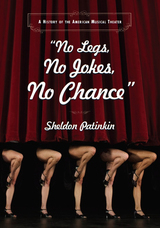 "No Legs, No Jokes, No Chance": A History of the American Musical Theater
Sheldon Patinkin
Northwestern University Press, 2008 Written by one of American theater's most avid and knowledgeable proponents, "No Legs, No Jokes, No Chance" traces the American musical from its rich and varied beginnings in European opera, American minstrel shows, and vaudeville through its many permutations to its current state--from, as Sheldon Patinkin puts it, La Boheme to Rent. Minstrelsy, burlesque, revue, dance, and choreographers, the "texts" of musical theater so often overlooked by its historians, finally receive due consideration in this thorough and thoroughly entertaining book about how American musical theater came to be and developed into what it is today.
Patinkin writes about the infancy of the musical--the revues, operettas, and early musical comedies, as well as the groundbreaking shows like Oklahoma!, and Show Boat that brought the form to its "golden age" during World War II. With insightful references to how history, literature, theater, fashion, popular music, and movies influenced musical theater generally and certain shows in particular, he traces a direct lineage from older forms to contemporary musicals. The result is a broad, clear, and detailed picture of American musicals within both an aesthetic and a historical context. Patinkin conveys the pleasure of the ever-changing forms of musical theater even as he gives readers the analytical tools and terms to understand and better appreciate this uniquely American art. The book features a selection of black and white photographs from historical musical productions, and each chapter includes suggestions for materials to watch and listen to at home or in the classroom.
No Less a Man: Masculist Art in a Feminist Age
Doug Robinson
University of Wisconsin Press, 1994 Robert B. Parker's detective Spenser. John Rambo, created by David Morrell and played on the silver screen by Sylvester Stallone. Bruce Springsteen. All three, Douglas Robinson claims, are central figures in a new form of popular men’s art: art that explores what it means to be a man in a feminist age. Robinson develops a three-stage transformation myth out of Joseph Campbell’s studies of hero mythology: the road of trials, on which repressive “normality” is tested and found lacking (Spenser); a symbolic death in which defensive rational ego-structures are surrendered (the Rambo of First Blood); and regeneration and return, the gradual rebirth of masculinity in a redemptive transformation (Springsteen).
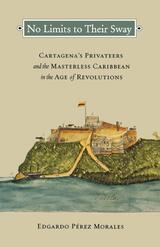 No Limits to Their Sway: Cartagena's Privateers and the Masterless Caribbean in the Age of Revolutions
Edgardo Pérez Morales
Vanderbilt University Press, 2018 Following the 1808 French invasion of the Iberian Peninsula, an unprecedented political crisis threw the Spanish Monarchy into turmoil. On the Caribbean coast of modern-day Colombia, the important port town of Cartagena rejected Spanish authority, finally declaring independence in 1811. With new leadership that included free people of color, Cartagena welcomed merchants, revolutionaries, and adventurers from Venezuela, the Antilles, the United States, and Europe. Most importantly, independent Cartagena opened its doors to privateers of color from the French Caribbean. Hired mercenaries of the sea, privateers defended Cartagena's claim to sovereignty, attacking Spanish ships and seizing Spanish property, especially near Cuba, and establishing vibrant maritime connections with Haiti.
Most of Cartagena's privateers were people of color and descendants of slaves who benefited from the relative freedom and flexibility of life at sea, but also faced kidnapping, enslavement, and brutality. Many came from Haiti and Guadeloupe; some had been directly involved in the Haitian Revolution. While their manpower proved crucial in the early Anti-Spanish struggles, Afro-Caribbean privateers were also perceived as a threat, suspected of holding questionable loyalties, disorderly tendencies, and too strong a commitment to political and social privileges for people of color. Based on handwritten and printed sources in Spanish, English, and French, this book tells the story of Cartagena's multinational and multicultural seafarers, revealing the Trans-Atlantic and maritime dimensions of South American independence.
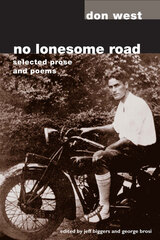 No Lonesome Road: SELECTED PROSE AND POEMS
Don West
University of Illinois Press, 2004 This is the first book to celebrate the life and writing of one of the most charismatic Southern leaders of the middle twentieth century, Don West (1906-1992). West was a poet, a pioneer advocate for civil rights, a preacher, a historian, a labor organizer, a folk-music revivalist, an essayist, and an organic farmer. He is perhaps best known as an educator, primarily as cofounder of the Highlander Folk School in Tennessee and founder of the Appalachian South Folklife Center in West Virginia. In his old age, West served as an elder statesman for his causes.
No Lonesome Road allows Don West to speak for himself. It provides the most comprehensive collection of his poetry ever published, spanning five decades of his literary career. It also includes the first comprehensive and annotated collection of West's nonfiction essays, articles, letters, speeches, and stories, covering his role at the forefront of Southern and Appalachian history, and as a pioneer researcher and writer on the South's little-known legacy of radical activism.
Drawing from both primary and secondary sources, including previously unknown documents, correspondence, interviews, FBI files, and newspaper clippings, the introduction by Jeff Biggers stands as the most thorough, insightful biographical sketch of Don West yet published in any form.
The afterword by George Brosi is a stirring personal tribute to the contributions of West and also serves as a thoughtful reflection on the interactions between the radicals of the 1930s and the 1960s.
The best possible introduction to his extraordinary life and work, this annotated selection of Don West's writings will be inspirational reading for anyone interested in Southern history, poetry, religion, or activism.
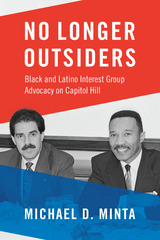 No Longer Outsiders: Black and Latino Interest Group Advocacy on Capitol Hill
Michael D. Minta
University of Chicago Press, 2021 With the rise of Black Lives Matter and immigrant rights protests, critics have questioned whether mainstream black and Latino civil rights organizations such as the NAACP and UnidosUS are in touch with the needs of minorities—especially from younger generations. Though these mainstream groups have relied on insider political tactics, such as lobbying and congressional testimony, to advocate for minority interests, Michael D. Minta argues that these strategies are still effective tools for advocating for progressive changes.
In No Longer Outsiders, Minta provides a comprehensive account of the effectiveness of minority civil rights organizations and their legislative allies. He finds that the organizations’ legislative priorities are consistent with black and Latino preferences for stronger enforcement of civil rights policy and immigration reform. Although these groups focus mainly on civil rights for blacks and immigration issues for Latinos, their policy agendas extend into other significant areas. Minta concludes with an examination of how diversity in Congress helps groups gain greater influence and policy success despite many limits placed upon them.
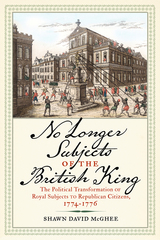 No Longer Subjects of the British King: The Political Transformation of Royal Subjects to Republican Citizens, 1774–1776
Shawn David McGhee
Westholme Publishing, 2024 When news reached Parliament of the Boston radicals’ destruction of the Royal East India Company’s tea, it passed the Coercive Acts, a collection of punitive measures designed to rein in that insubordinate seaport town. The Coercive Acts unleashed a political firestorm as communities from Massachusetts to Georgia drafted resistance resolutions condemning Parliament’s perceived encroachment upon American liberty. Local leaders also directed colonists to refrain from purchasing British merchandise and forego theater, horse racing, and other perceived debauched traditions. Local activists next convened the Continental Congress to coordinate a pancolonial resistance movement to pressure Parliament into repealing the Coercive Acts and settling American rights on a constitutional foundation. Once convened, Congress deftly drafted the Articles of Association. Traditionally understood as primarily an economic response by the colonies to Parliament’s actions, the Continental Association called for public demonstrations of commercial and cultural restraint, conduct delegates hoped would both heal the empire and restore colonial virtue.
Historian Shawn McGhee offers a fresh perspective on the origins of American political identity. No Longer Subjects of the British King: The Political Transformation of Royal Subjects to Republican Citizens, 1774-1776reveals the crucial process by which the Continental Association organized American towns and counties into a protonational community of suffering to protect political identities they felt under threat. This work further demonstrates how those sacrificing for the common cause severed their bonds of allegiance to the British king and separated from the broader imperial nation. In this crucible of austerity, they formed an American political community, completing the political transformation from subject to citizen.
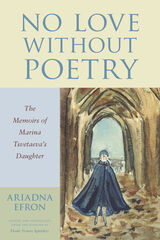 No Love Without Poetry: The Memoirs of Marina Tsvetaeva's Daughter
Ariadna Efron
Northwestern University Press, 2009 Winner of the American Association of Teachers of Slavic and East European Languages 2011 Book Prize for Best Scholarly Translation in English
The memoirs of Ariadna Efron provide an intimate and indispensable perspective on the poet Marina Tsvetaeva’s life and work, told from the point of view of her daughter. This wrenching story about the difficulty of living with genius charts Efron’s relationship with her parents as they navigate art and exile.
Efron’s rapport with her mother, already intense, became strained under the hardships imposed by early twentieth century Russian political upheaval. Efron recounts the family’s travels from Moscow to Germany, to Czechoslovakia, and finally to France, where, against her mother’s advice, Efron decided to return to Russia. Diane Nemec Ignashev draws on Efron’s short stories and her mother’s notebooks to supplement the original memoirs. Haunting and poignant, No Love without Poetry completes extant historical records on Tsvetaeva—and showcases Efron as a literary force in her own right.
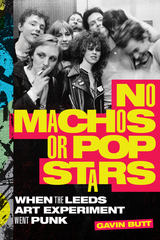 No Machos or Pop Stars: When the Leeds Art Experiment Went Punk
Gavin Butt
Duke University Press, 2022 After punk’s arrival in 1976, many art students in the northern English city of Leeds traded their paintbrushes for guitars and synthesizers. In bands ranging from Gang of Four, Soft Cell, and Delta 5 to the Mekons, Scritti Politti, and Fad Gadget, these artists-turned-musicians challenged the limits of what was deemed possible in rock and pop music. Taking avant-garde ideas to the record-buying public, they created Situationist antirock and art punk, penned deconstructed pop ditties about Jacques Derrida, and took the aesthetics of collage and shock to dark, brooding electro-dance music. In No Machos or Pop Stars Gavin Butt tells the fascinating story of the post-punk scene in Leeds, showing how England’s state-funded education policy brought together art students from different social classes to create a fertile ground for musical experimentation. Drawing on extensive interviews with band members, their associates, and teachers, Butt details the groups who wanted to dismantle both art world and music industry hierarchies by making it possible to dance to their art. Their stories reveal the subversive influence of art school in a regional music scene of lasting international significance.
 No Man Is An Island: Community and Commemoration on Norway's Utøya
Jørgen Watne Frydnes, translated by Wendy H. Gabrielsen
University of Massachusetts Press, 2025 On July 22, 2011, a white supremacist killed eight people at Oslo’s Government Center in Norway and then terrorized the idyllic island of Utøya, where he executed sixty-nine more people, mostly teenagers. The country had never suffered such a massacre, and in the aftermath, the entire population was reeling.
Utøya, the Norwegian Labor Party’s summer camp for youth, a beloved place where many Norwegians learned about democratic values and processes, made lifelong friendships, and developed a vision for a just society, became mired in grief and discord. When Jørgen Watne Frydnes took on the daunting task of rebuilding the island and charting its future, he had to figure out a compassionate and just way forward. He made a radical decision: he set out to talk with each family of a murdered person, seeking to understand their needs and their hopes so that the future of the island could include their wishes and concerns. This emotionally grueling work, which was never considered in the scholarly literature on commemoration, led to a true renewal of Utøya, resulting in a meaningful memorial to those who were lost as well as beautiful surroundings for campers who come there to study democracy and peace.
Frydnes’s narrative, originally published in Norwegian, is structured around the seasons of the year and the landscape of the island, and tracks one person’s account of learning how to remember, commemorate, and honor the dead, and acknowledge a mass tragedy, and yet also create a nurturing, aspirational space for hope.
 No Man's Garden: Thoreau And A New Vision For Civilization And Nature
Daniel B Botkin
Island Press, 2001 In No Man's Garden, ecologist Daniel Botkin takes a fresh look at the life and writings of Henry David Thoreau to discover a model for reconciling the conflict between nature and civilization that lies at the heart of our environmental problems. He offers an insightful reinterpretation of Thoreau, drawing a surprising picture of the “hermit of Walden” as a man who loved wildness, but who found it in the woods and swamps on the outskirts of town as easily as in the remote forests of Maine, and who firmly believed in the value and importance of human beings and civilization.Botkin integrates into the familiar image of Thoreau, the solitary seeker, other, equally important aspects of his personality and career -- as a first-rate ecologist whose close, long-term observation of his surroundings shows the value of using a scientific approach, as an engineer who was comfortable working out technical problems in his father's pencil factory, and as someone who was deeply concerned about the spiritual importance of nature to people.This new view of one of the founding fathers of American environmental thought lays the groundwork for an innovative approach to solving environmental problems. Botkin argues that the topics typically thought of as “environmental,” and the issues and concerns of “environmentalism,” are in fact rooted in some of humanity's deepest concerns -- our fundamental physical and spiritual connection with nature, and the mutually beneficial ways that society and nature can persist together. He makes the case that by understanding the true scientific, philosophical, and spiritual bases of environmental positions we will be able to develop a means of preserving the health of our biosphere that simultaneously allows for the further growth and development of civilization.No Man's Garden presents a vital challenge to the assumptions and conventional wisdom of environmentalism, and will be must reading for anyone interested in developing a deeper understanding of interactions between humans and nature.
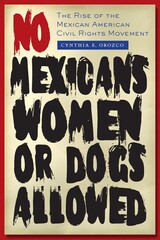 No Mexicans, Women, or Dogs Allowed: The Rise of the Mexican American Civil Rights Movement
By Cynthia E. Orozco
University of Texas Press, 2009 Founded by Mexican American men in 1929, the League of United Latin-American Citizens (LULAC) has usually been judged according to Chicano nationalist standards of the late 1960s and 1970s. Drawing on extensive archival research, including the personal papers of Alonso S. Perales and Adela Sloss-Vento, No Mexicans, Women, or Dogs Allowed presents the history of LULAC in a new light, restoring its early twentieth-century context. Cynthia Orozco also provides evidence that perceptions of LULAC as a petite bourgeoisie, assimilationist, conservative, anti-Mexican, anti-working class organization belie the realities of the group's early activism. Supplemented by oral history, this sweeping study probes LULAC's predecessors, such as the Order Sons of America, blending historiography and cultural studies. Against a backdrop of the Mexican Revolution, World War I, gender discrimination, and racial segregation, No Mexicans, Women, or Dogs Allowed recasts LULAC at the forefront of civil rights movements in America.
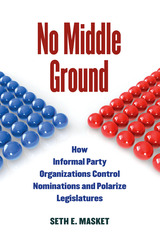 No Middle Ground: How Informal Party Organizations Control Nominations and Polarize Legislatures
Seth E. Masket
University of Michigan Press, 2011 "This is a fascinating book. It is one of the best studies of the ways that parties and politics get conducted in any American state. Masket shows that legislators can be perfectly content without parties that control agendas and does a terrific job of explaining the transition from free-wheeling legislators to rigidly partisan voting blocs."
---Sam Popkin, University of California at San Diego "No Middle Ground makes a significant contribution to the study of American parties and legislative politics."
---Matthew Green, Catholic University of America Despite concerns about the debilitating effects of partisanship on democratic government, in recent years political parties have gained strength in state governments as well as in Washington. Whereas political machines of the past manipulated votes, today's machines determine which candidates can credibly compete in a primary. Focusing on the history and politics of California, Seth E. Masket reveals how these machines evolved and how they stay in power by directing money, endorsements, and expertise to favored candidates, who often tend toward the ideological extreme. Masket argues that politicians are not inherently partisan. Instead, partisanship is thrust upon them by actors outside the government with the power to manipulate primary elections. Seth E. Masket is Associate Professor of Political Science at the University of Denver.
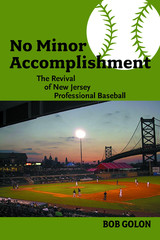 No Minor Accomplishment: The Revival of New Jersey Professional Baseball
Golon, Bob
Rutgers University Press, 2008 America's pastime has roots in New Jersey dating back to 1846 when the first baseball game using modern rules was played on Elysian Fields in Hoboken. The sport thrived throughout the state until the 1950s when fans began to turn away from local competition, preferring to watch games broadcast on television, to take a trip to see a major league team in New York, or to frequent newly air-conditioned movie theaters or bowling alleys. By the early 1990s, however, a growing disenchantment with the high ticket prices and corporate atmosphere of Major League Baseball led to the revival of a purer form of the sport in the Garden State.
In No Minor Accomplishment, sports historian and New Jersey native Bob Golon tells the story of the state's baseball scene since the Trenton Thunder arrived in 1994. Drawing on interviews with team owners and employees, industry executives and fans, Golon goes behind the scenes to show how maintaining a minor league ball club can be a risky business venture. Stadiums cost millions to build, and a team full of talented players does not immediately guarantee success. Instead, each of the eight minor league and independent professional teams in the state must tailor themselves to the communities in which they are situated. Shrewd marketing is necessary to attract fans, but Golon also explains how, unlike Major League Baseball, the business aspect of the minor and independent leagues is not something the average spectator notices. For the fans, baseball in New Jersey is wholesome, exciting family entertainment.
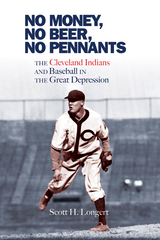 No Money, No Beer, No Pennants: The Cleveland Indians and Baseball in the Great Depression
Scott H. Longert
Ohio University Press, 2016 The Cleveland Indians of 1928 were a far cry from the championship team of 1920. They had begun the decade as the best team in all of baseball, but over the following eight years, their owner died, the great Tris Speaker retired in the face of a looming scandal, and the franchise was in terrible shape. Seeing opportunity in the upheaval, Cleveland real estate mogul Alva Bradley purchased the ball club in 1927, infused it with cash, and filled its roster with star players such as Bob Feller, Earl Averill, and Hal Trosky. He aligned himself with civic leaders to push for a gigantic new stadium that—along with the team that played in it—would be the talk of the baseball world. Then came the stock market crash of 1929. Municipal Stadium was built, despite the collapse of the industrial economy in Rust Belt cities, but the crowds did not follow. Always the shrewd businessman, Bradley had engineered a lease agreement with the city of Cleveland that included an out clause, and he exercised that option after the 1934 season, leaving the 80,000-seat, multimillion-dollar stadium without a tenant. In No Money, No Beer, No Pennants, Scott H. Longert gives us a lively history of the ups and downs of a legendary team and its iconic players as they persevered through internal unrest and the turmoil of the Great Depression, pursuing a pennant that didn’t come until 1948. Illustrated with period photographs and filled with anecdotes of the great players, this book will delight fans of baseball and fans of Cleveland.
 No Morality, No Self: Anscombe’s Radical Skepticism
James Doyle
Harvard University Press, 2017 Frequently cited and just as often disputed, Elizabeth Anscombe’s “Modern Moral Philosophy” (1958) and “The First Person” (1975) are touchstones of twentieth-century analytic philosophy. Though the arguments Anscombe advances in these papers are familiar to philosophers, their significance remains widely misunderstood, says James Doyle.
No Morality, No Self offers a fresh interpretation of Anscombe’s still-controversial theses about ethical reasoning and individual identity, specifically, her argument that the term “moral” (as it occurs in such contexts as “moral obligation”) is literally meaningless, and that “I” does not refer to some special entity called a “self”—a pair of claims that philosophers have responded to with deep skepticism. However unsettling Anscombe’s conclusions may be, Doyle shows the underlying seriousness of the British philosopher’s reasoning, exposing with clarity and concision how the counterarguments of Anscombe’s detractors are based on a flawed or incomplete understanding of her ideas.
Doyle zeroes in on the central conundrum Anscombe posed to the referentialist school: namely, that it is impossible to give a noncircular explanation of how “I” refers to the person who utters it. He shows where the refutations of philosophers including Lucy O’Brien, Gareth Evans, and Ian Rumfitt fall short, and throws light on why “I” developed features that make it look as if it functions as a referring expression. Reconciling seemingly incompatible points of view, Doyle argues that “I” does refer to a self, but not in a way anyone suspected—a surprising conclusion that is entirely à propos of Anscombe’s provocative thought.
No More Bullies!/¡No Más Bullies: Owl in a Straw Hat 2
Rudolfo Anaya
Museum of New Mexico Press, 2019 The adventures and lessons continue in this second book featuring “Owl in a Straw Hat” (Ollie Tecolote). This book tackles the subject of bullying of classmates for being different. Jackie Jackalope is missing from school and the teacher (Ollie’s grandmother) gets to the bottom of it. The kids have been teasing Jackie about her horns and she has run away to her parents in Pot of Gold Land. A contrite Ollie along with Uno the Unicorn (both guilty of teasing) volunteer to find and bring Jackie back to school. Their journey to Jackie’s home leads to encounters with three guardians of the Dark Forest (NM monsters/legends): La Llorona, El Kookoóee, and Skeleton Woman; and the Golden Carp who allows them to cross Rainbow Bridge. They reach Jackie and apologize and take her back to Wisdom School. Rudolfo Anaya’s magical characters are brought to life by illustrator El Moisés.
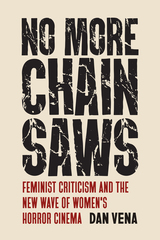 No More Chainsaws: Feminist Criticism and the New Wave of Women's Horror Cinema
Dan Vena
Rutgers University Press, 2026 “Welcome to the Golden Age of Women-Directed Horror.” Over the last fifteen years, there has been a sustained global influx of women artists working in mainstream and independent horror cinemas earning notable public and industry acclaim. As a result, now, for the first time in horror history, there is also a concentrated corpus of films that explicitly address topics of identity, sexuality, trauma, and monstrosity from women’s perspectives. No More Chainsaws offers an in-depth analysis of some of the earliest and underrated releases within this New Wave of Women’s Horror cinema: Catherine Hardwicke’sTwilight (2008), Karyn Kusama’s Jennifer’s Body (2009), Jennifer and Sylvia Soska’s American Mary (2012), and Kimberly Peirce’s Carrie (2013). No More Chainsaws articulates the ways in which these contemporary films attempt to liberate horror from an over-determining gendered lexicon of violence and terror.
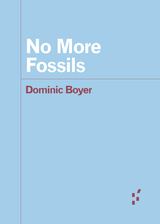 No More Fossils
Dominic Boyer
University of Minnesota Press, 2023 Explores ecological impasses and opportunities of our fossil-fueled civilization
It is more and more obvious that our fossilized civilization has no sustainable future. It is an ecological Ponzi scheme stealing away the lives of countless species and the wellbeing of future generations in exchange for contemporary conveniences and the luxuries of a small subset of the human population. Yet a civilization wholly beyond fossils still seems difficult to grasp. In No More Fossils, Dominic Boyer tells the story of the rise of fossil civilization through successive phases of sucropolitics (plantation sugar), carbopolitics (industrial coal), and petropolitics (oily automobility and plasticity), showing what tethers us to the ecocidal trajectory of petroculture today and what it will take to overcome the forces that mire us in place. He also looks ahead toward the world that the rapid electrification of vehicles, buildings, and power is creating. What can we do to make electroculture more just and sustainable than the petroculture we are leaving behind?
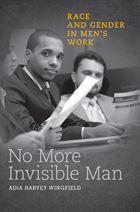 No More Invisible Man: Race and Gender in Men's Work
Adia Harvey Wingfield
Temple University Press, 2012 The “invisible men” of sociologist Adia Harvey Wingfield’s urgent and timely No More Invisible Man are African American professionals who fall between extremely high status, high-profile black men and the urban underclass. Her compelling interview study considers middle-class, professional black men and the challenges, obstacles, and opportunities they encounter in white male–dominated occupations. No More Invisible Man chronicles these men’s experiences as a tokenized minority in the workplace to show how issues of power and inequality exist—especially as they relate to promotion, mobility, and developing occupational networks. Wingfield’s intersectional analysis deftly charts the ways that gender, race, and class collectively shape black professional men’s work experiences. In its examination of men’s interactions with women and other men, as well as men’s performances of masculinity and their emotional demeanors in these jobs, No More Invisible Man extends our understanding of racial- and gender-based dynamics in professional work.
No More Nice Girls: Countercultural Essays
Ellen Willis
University of Minnesota Press, 2012 With characteristic intelligence, wit, and feminist insight, Ellen Willis addresses democracy as she sees it: “a commitment to individual freedom and egalitarian self-government in every area of social, economic, and cultural life.” Moving between scholarly and down-to-earth activist writing styles, Willis confronts the conservative backlash that has slowly eroded democratic ideals and advances of the 1960s as well as the internal debates that have frequently splintered the left.
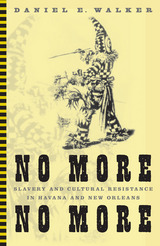 No More, No More: Slavery And Cultural Resistance In Havana And New Orleans
Daniel E. Walker
University of Minnesota Press, 2004 An illuminating look at the festival performances of slaves in Havana and New Orleans However urban slave societies might have differed from their rural counterparts, they still relied on a concerted assault on the psychological, social, and cultural identity of their African-descended inhabitants to maintain power and control. This ambitious book looks at how people of African descent in two such societies—Havana and New Orleans in the nineteenth century—created and maintained their own forms of cultural resistance to the slave regime’s assault and, in the process, put forth autonomous views of self and the social landscape. In Havana’s annual Día de Reyes festival and in the weekly activities that took place at New Orleans’s Congo Square, author Daniel Walker identifies specific cultural beliefs and activities that Africans brought to the New World and modified in order to withstand and contest the dehumanizing effects of oppression. No More, No More crosses disciplinary boundaries as well, elucidating the economic, social, cultural, and demographic operations at work in two cities and the wide-scale efforts at cultural resistance embodied in public performances.
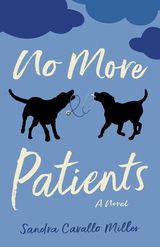 No More Patients: A Novel
Sandra Cavallo Miller
University of Nevada Press, 2026 Dr. Norah Waters is approaching sixty-five and eager to retire, but complications keep disrupting her plans. New physicians in her practice aren’t acclimating well. Patients are going off the rails. Unwelcome exes and toxic former students reappear. And her ninety-one-year-old mother, Vivian Waters, has grown emotionally needy.
Once a free spirit, Vivian celebrated at Woodstock in her thirties and Burning Man in her eighties. Now she spends her time feuding with Marianne Dunwitty, her new rival from the Scrabble Klub. To help resolve her identity crisis, Vivian begins recording reflections on her life, revealing a deep despair that drives her to take on the Klub members, scorn the new cloud-watching man next door, and snoop into a suspected neighborhood homicide.
Norah and Vivian must find ways to deal with their out-of-balance lives, and—most importantly—each other. Picking up where Out of Patients left off, No More Patients is a heartfelt, humorous sequel that stands on its own, about the struggles of healing both patients and relationships alike.
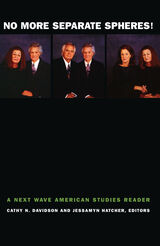 No More Separate Spheres!: A Next Wave American Studies Reader
Cathy N. Davidson and Jessamyn Hatcher, eds.
Duke University Press, 2002 No More Separate Spheres! challenges the limitations of thinking about American literature and culture within the narrow rubric of “male public” and “female private” spheres from the founders to the present. With provocative essays by an array of cutting-edge critics with diverse viewpoints, this collection examines the ways that the separate spheres binary has malingered unexamined in feminist criticism, American literary studies, and debates on the public sphere. It exemplifies new ways of analyzing gender, breaks through old paradigms, and offers a primer on feminist thinking for the twenty-first century. Using American literary studies as a way to talk about changing categories of analysis, these essays discuss the work of such major authors as Catharine Sedgwick, Herman Melville, Pauline E. Hopkins, Frederick Douglass, Catharine Beecher, Ralph Waldo Emerson, W. E. B. Du Bois, Sarah Orne Jewett, Nathaniel Hawthorne, María Ampara Ruiz de Burton, Ann Petry, Gwendolyn Brooks, Cynthia Kadohata, Chang Rae-Lee, and Samuel Delany. No More Separate Spheres! shows scholars and students different ways that gender can be approached and incorporated into literary interpretations. Feisty and provocative, it provides a forceful analysis of the limititations of any theory of gender that applies only to women, and urges suspicion of any argument that posits “woman” as a universal or uniform category. By bringing together essays from the influential special issue of American Literature of the same name, a number of classic essays, and several new pieces commissioned for this volume, No More Separate Spheres! will be an ideal teaching tool, providing a key supplementary text in the American literature classroom. Contributors. José F. Aranda, Lauren Berlant, Cathy N. Davidson, Judith Fetterley, Jessamyn Hatcher, Amy Kaplan, Dana D. Nelson, Christopher Newfield, You-me Park, Marjorie Pryse, Elizabeth Renker, Ryan Schneider, Melissa Solomon, Siobhan Somerville, Gayle Wald , Maurice Wallace
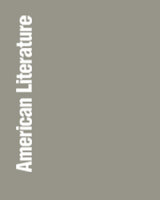 No More Separate Spheres, Volume 70
Cathy N. Davidson
Duke University Press Much criticism of nineteenth-century American literature written during the last quarter century has been structured by the concept of “separate spheres,” a construction that often is recreated in contemporary critical practice. The contributors to this special issue examine and contest the way the category of gender—male versus female, extending to include, for example, the oppositions between public and private, worldly and domestic—has organized critical discussion regarding the formulation of American literature. Challenging the separate spheres model, these essays ask how other categories complicate this paradigm, especially with regard to issues of race, sexuality, class, region, religion, and occupation. In No More Separate Spheres! both established and new scholars look at the changing categories of analysis—from seventies feminism to nineties postcolonialism—that have shaped this discussion. In her introduction, Cathy N. Davidson assesses the state of criticism with regard to the separate spheres debate, and sets a constructive and often provocative tone for the rest of the volume. While one essay provides an overview of the multiple fronts on which the post-separate spheres model of criticism has been engaged, others offer perspectives that either support of directly confront and critique this model. Rather than seeking to establish yet another critical formula based on the opposition of binary terms, this special issue of American Literature will help move the debate to the next level. Contributors. José F. Aranda, Lauren Berlant, Lawrence Buell, Judith Fetterley, Amy Kaplan, You-me Park, Marjorie Pryse, Gail Wald
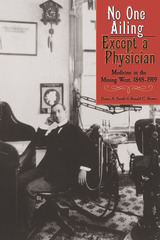 No One Ailing Except a Physician: Medicine in the Mining West, 1848-1919
Duane A. Smith
University Press of Colorado, 2001 Co-Winner of the 2004 Colorado Endowment for the Humanities Publication Prize From burying scurvy victims up to their necks in the earth to drinking kerosene mixed with sugar to treat influenza, mid-nineteenth century medicine in the mining communities of the West usually consisted of home remedies that were often remarkable for their inventiveness but tragically random in their effectiveness. Only as a desperate last resort would people turn to the medical community, which had developed a deplorable reputation for quackery and charlatanism because of its lack of licensing regulations and uniform educational standards. No One Ailing Except a Physician takes readers back to those free-wheeling days in the mining towns and the dark recesses of the mines themselves, a time when illness or injury was usually survived more due to sheer luck than the interventions of medicine. In this important new contribution to both mining and medical history, historians Duane A. Smith and Ronald C. Brown present a detailed analysis of the ailments that confronted the miners and the methods with which they and their doctors attempted to "cure" them. The occupational hazards of mining, with its strenuous labor and exposure to the elements, contributed to the miners' vulnerability to disease and injury, which was further worsened by the typical miner's refusal to heed prevailing medical wisdom and common sense, often leading to easily preventable diseases such as scurvy. And because medical science of the era had not progressed much beyond that of the ancient Greeks, such debilitating diseases such as cholera, influenza, dysentery, and malaria proved to be virtual death sentences, to say nothing of occupational accidents with fires and explosions, mine collapses, and safety cage mishaps.
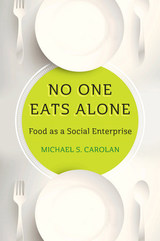 No One Eats Alone: Food as a Social Enterprise
Michael S. Carolan
Island Press, 2017 In today’s fast-paced, fast food world, everyone seems to be eating alone, all the time—whether it’s at their desks or in the car. Even those who find time for a family meal are cut off from the people who grew, harvested, distributed, marketed, and sold the foods on their table. Few ever break bread with anyone outside their own socioeconomic group. So why does Michael Carolan say that that no one eats alone? Because all of us are affected by the other people in our vast foodscape. We can no longer afford to ignore these human connections as we struggle with dire problems like hunger, obesity, toxic pesticides, antibiotic resistance, depressed rural economies, and low-wage labor.
Carolan argues that building community is the key to healthy, equitable, and sustainable food. While researching No One Eats Alone, he interviewed more than 250 individuals, from flavorists to Fortune 500 executives, politicians to feedlot managers, low-income families to crop scientists, who play a role in the life of food. Advertising consultants told him of efforts to distance eaters and producers—most food firms don’t want their customers thinking about farm laborers or the people living downstream of processing plants. But he also found stories of people getting together to change their relationship to food and to each other.
There are community farms where suburban moms and immigrant families work side by side, reducing social distance as much as food miles. There are entrepreneurs with little capital or credit who are setting up online exchanges to share kitchen space, upending conventional notions of the economy of scale. There are parents and school board members who are working together to improve cafeteria food rather than relying on soda taxes to combat childhood obesity.
Carolan contends that real change only happens when we start acting like citizens first and consumers second. No One Eats Alone is a book about becoming better food citizens.
 No One Ever Asked: The Untold Story of a Civil Rights Worker
Arnold Rochvarg
University of Missouri Press, 2025 This engaging work by legal scholar Arnold Rochvarg presents a narrative history of the mid-1960s civil rights movement centered around the experiences of a white woman from Philadelphia, Pennsylvania, who quit college to join the movement and became involved with many of the important events and persons of the day.
Rochvarg, the cousin of the woman around whom the narrative revolves, had for over fifty years been intrigued by the mystery surrounding the seven-year disappearance of his cousin Iris during the 1960s. Once he finally approached her about her rumored involvement in the civil rights movement, she generously shared her experiences with him and arranged for him to meet others with whom she had worked. His book corroborates and enhances the stories he was told through traditional research based on primary and secondary sources.
More than a review of significant events of the mid-1960s, No One Ever Asked is also the story of the challenges and sacrifices of young civil rights workers both Black and white, young persons who not only faced violence and personal harm, but in many cases became estranged from their families because of their involvement in the movement. Rochvarg approaches history from the “bottom-up,” focusing on persons whose stories have never been told but have something to add to an understanding of the history of the movement. Many of them, even sixty years later, have never shared their stories because, as in the case of the central character of this book, no one ever asked them.
No One Knows Their Names: Screenwriters in Hollywood
Jorja Prover
University of Wisconsin Press, 1994 This is the first study of Hollywood by an anthropologist. Jorja Prover examines how different groups of individuals, separated from one another superficially by ethnicity, race, and sex, function as writers in Hollywood. She describes the white “majority” Hollywood writers and explores their concerns and creative processes, and then discusses other writers who, until recently, have been virtually invisible in the entertainment industry—women, the physically challenged, gays, African Americans, Latinos, and Asians. In detailing their efforts at gaining professional acceptance, these writers introduce new, previously unmentioned issues involving access, advancement, talent, sexual harassment, and discrimination.
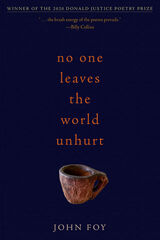 No One Leaves the World Unhurt
John Foy
Autumn House Press, 2021 John Foy’s newest collection is a tour de force of formal poetry, offering a blend of wit, cleverness, and deftness. Working in the lineage of poets like Billy Collins, Robert Frost, Frank O’Hara, W. H. Auden, and Elizabeth Bishop, Foy probes everyday experiences to generate compassionate, clever, and deeply knowing verse. While moments in No One Leaves the World Unhurt may appear absurd or even funny on the surface—such as a psychological exploration of the Lord of the Rings character Gollum—beneath this lightheartedness lies a tone that is grim and foreboding. Foy satirizes various elements of contemporary society, reflecting on war, wandering through the Museum of Sex in New York with his wife, and plucking apart idiomatic speech, which he breaks down, saying “It is what it is. / It’s not what it might have been.” Influenced by pop art and fine art and his New York home, which forms the backdrop of many of these poems, Foy’s vibrant collection is simultaneously philosophical, whimsical, serious, and searching.
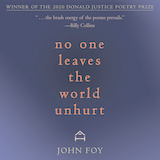 No One Leaves the World Unhurt
John Foy
Autumn House Press, 2021 John Foy’s newest collection is a tour de force of formal poetry, offering a blend of wit, cleverness, and deftness. Working in the lineage of poets like Billy Collins, Robert Frost, Frank O’Hara, W. H. Auden, and Elizabeth Bishop, Foy probes everyday experiences to generate compassionate, clever, and deeply knowing verse. While moments in No One Leaves the World Unhurt may appear absurd or even funny on the surface—such as a psychological exploration of the Lord of the Rings character Gollum—beneath this lightheartedness lies a tone that is grim and foreboding. Foy satirizes various elements of contemporary society, reflecting on war, wandering through the Museum of Sex in New York with his wife, and plucking apart idiomatic speech, which he breaks down, saying “It is what it is. / It’s not what it might have been.” Influenced by pop art and fine art and his New York home, which forms the backdrop of many of these poems, Foy’s vibrant collection is simultaneously philosophical, whimsical, serious, and searching.
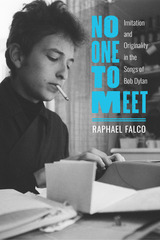 No One to Meet: Imitation and Originality in the Songs of Bob Dylan
Raphael Falco
University of Alabama Press, 2022 A groundbreaking appreciation of Dylan as a literary practitioner
WINNER OF THE ELIZABETH AGEE PRIZE IN AMERICAN LITERATURE
The literary establishment tends to regard Bob Dylan as an intriguing, if baffling, outsider. That changed overnight when Dylan was awarded the 2016 Nobel Prize in Literature, challenging us to think of him as an integral part of our national and international literary heritage. No One to Meet: Imitation and Originality in the Songs of Bob Dylan places Dylan the artist within a long tradition of literary production and offers an innovative way to understand his unique and often controversial methods of composition.
Dylan expert Raphael Falco traces the similarities between the way Dylan borrows, digests, and transforms traditional songs and what Renaissance writers called imitatio. Although Dylan’s lyrical postures may suggest an avant-garde consciousness, No One to Meet shows that Dylan’s creative process creatively expands methods used by classical and Renaissance authors.
Drawing on numerous examples, including Dylan’s previously unseen manuscript excerpts and archival materials, Raphael Falco illuminates how the ancient process of poetic imitation, handed down from Greco-Roman antiquity, allows us to make sense of Dylan’s musical and lyrical technique. By placing Dylan firmly in the context of an age-old poetic practice, No One to Meet deepens our appreciation of Dylan’s songs and allows us to celebrate him as what he truly is: a great writer.
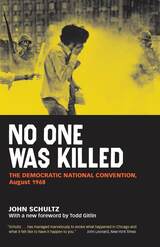 No One Was Killed: The Democratic National Convention, August 1968
John Schultz
University of Chicago Press, 2009 While other writers contemplated the events of the 1968 Chicago riots from the safety of their hotel rooms, John Schultz was in the city streets, being threatened by police, choking on tear gas, and listening to all the rage, fear, and confusion around him. The result, No One Was Killed, is his account of the contradictions and chaos of convention week, the adrenalin, the sense of drama and history, and how the mainstream press was getting it all wrong. "A more valuable factual record of events than the city’s white paper, the Walker Report, and Theodore B. White’s Making of a President combined."—Book Week "As a reporter making distinctions between Yippie, hippie, New Leftist, McCarthyite, police, and National Guard, Schultz is perceptive; he excels in describing such diverse personalities as Julian Bond and Eugene McCarthy."—Library Journal "High on my short list of true, lasting, inspired evocations of those whacked-out days when the country was fighting a phantasmagorical war (with real corpses), and police under orders were beating up demonstrators who looked at them funny."—Todd Gitlin, from the foreword
No One Will See Me Cry
Cristina Rivera-Garza
Northwestern University Press, 2003
Winner of the Mexico National Novel Prize, Sor Juana Inés de la Cruz Prize, and IMPACT Prize
Joaquín Buitrago, a photographer in the Castaneda Insane Asylum, believes a patient is a prostitute he knew years earlier. His obsession in confirming Matilde's identity leads him to explore the clinics records, and her tragic history. Joaquín and Matilda begin to tell each other fragmented stories about a past they almost shared, and a future in which they do not believe. Set in 1920s Mexico, this novel is at once an overview of one of the most turbulent times in Mexican history, a love story, and a meditation on the ways in which medical and popular language define insanity. No One Will See Me Cry is a lyrical and startling visitation with the so-called losers of an era as they try to plumb the meaning of their lives.
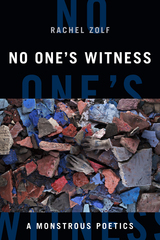 No One's Witness: A Monstrous Poetics
Syd Zolf
Duke University Press, 2021 In No One's Witness Syd Zolf activates the last three lines of a poem by Jewish Nazi holocaust survivor Paul Celan—“No one / bears witness for the / witness”—to theorize the poetics and im/possibility of witnessing. Drawing on black studies, continental philosophy, queer theory, experimental poetics, and work by several writers and artists, Zolf asks what it means to witness from the excessive, incalculable position of No One. In a fragmentary and recursive style that enacts the monstrous speech it pursues, No One's Witness demonstrates the necessity of confronting the Nazi holocaust in relation to transatlantic slavery and its afterlives. Thinking along with black feminist theory's notions of entangled swarm, field, plenum, chorus, No One's Witness interrogates the limits and thresholds of witnessing, its dangerous perhaps. No One operates outside the bounds of the sovereign individual, hauntologically informed by the fleshly no-thingness that has been historically ascribed to blackness and that blackness enacts within, apposite to, and beyond the No One. No One bears witness to becomings beyond comprehension, making and unmaking monstrous forms of entangled future anterior life.
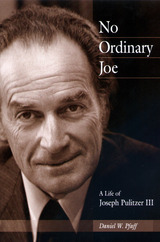 No Ordinary Joe: A Life of Joseph Pulitzer III
Daniel W. Pfaff
University of Missouri Press, 2005 The widely known Pulitzer name is considered by many to be synonymous with the Pulitzer Prizes and the St. Louis Post-Dispatch. Joseph Pulitzer III (1913–1993) was editor and publisher of the Post-Dispatch, as were his father and grandfather before him. In No Ordinary Joe, Daniel W. Pfaff provides an insightful look at the life and career of Joseph Pulitzer III, using correspondence and records that were made available exclusively to the author. Pfaff also includes interviews with more than seventy individuals who knew and/or worked with Pulitzer. Trained for succession to the Pulitzer media empire by his father, Joseph Pulitzer III strove above all to maintain the paper’s liberal/reformist philosophy profitably practiced since 1878 by his predecessors. When other newspapers began blurring the boundary between news and entertainment as a way of keeping and attracting readers and advertisers, Pulitzer resisted letting the Post-Dispatch put profit motives ahead of journalistic independence. When Pulitzer died in 1993, he had managed to sustain the Post-Dispatch’s distinguished tradition of editorial independence, and he left behind a company that was substantially larger and more competitive than when he took charge thirty-eight years before. In addition to his work with the Post-Dispatch, Pulitzer was the head of the Pulitzer Publishing Company from 1955 to 1993. He also served as chairman of the Pulitzer Prize Board at Columbia University for thirty-one years. The board, which had been established by his grandfather, was responsible for awarding the coveted annual prizes in journalism, letters, and music. As much as Pulitzer was known for his affiliation with the Post-Dispatch, he was also known for his collection of contemporary art, regarded as one of the largest and finest in the world. He was known, too, for the stately way in which he carried himself, for his elegant attire, and for his impeccable taste and manners. This remarkable biography will be of interest to scholars of journalism and media history and American history generally, as well as those interested in the tribulations of family businesses. It will also appeal to cultural historians and general readers, who will be interested in how this bearer of a widely known name handled the power, responsibility, and privilege of the position into which he was born.
No Peace, No War: An Anthropology of Contemporary Armed Conflicts
Paul Richards
Ohio University Press, 2004 A rash of small wars erupted after the Cold War ended in Africa, the Balkans, and other parts of the former communist world. The wars were in “inter-zones,” the spaces left where weak states had withdrawn or collapsed. Consequently the debate over what constitutes war has returned to basics. No Peace, No War departs from the usual analysis that considers the new wars mindless mass actions to offer the paradoxical idea that to understand war one must deny war special status. Rather than leave war to the security specialists, these writers attempt to grasp its character as one among many aspects of social reality.
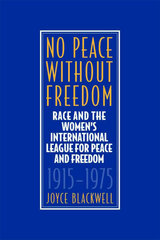 No Peace Without Freedom: Race and The Women's International League For Peace and Freedom 1915-1975
Joyce Blackwell
Southern Illinois University Press, 2004 Just as women changed the direction and agenda of the peace movement when they became progressively more involved in an all-male club, black women altered a cause that had previously lacked racial diversity when they were first granted admission to the Women’s International League for Peace and Freedom in 1915. As Joyce Blackwell illustrates in this first study of collective black peace activism, the increased presence of black women in the WILPF over the next sixty years brought to the movement historical experiences shaped by societal racism. No Peace Without Freedom: Race and the Women’s International League for Peace and Freedom, 1915–1975 explores how black women, fueled by the desire to eradicate racial injustice, compelled the white leadership of the WILPF to revisit its own conceptions of peace and freedom. Blackwell offers a renewed examination of peace movements in American history, one that points out the implications of black women’s participation for the study of social activism, African American history, and women’s history. This new perspective on interracial and black female global activism helps redefine the often-covert systemic violence necessary to maintain systems of social and economic hierarchy, moving peace and war discourse away from its narrow focus on European and European-American issues. Blackwell looks closely at the reasons why white women organized their own peace group at the start of World War I and assesses several bold steps taken by these groups in their first ten years. Addressing white peace activists’ continuous search for the “perfect” African American woman, Blackwell considers when and why black women joined the WILPF, why so few of them were interested in the organization, and what the small number who did join had in common with their white counterparts. She also shows how the WILPF, frustrated at its inability to successfully appeal to black women, established a controversial interracial committee to deal with the dilemma of recruiting black women while attempting to maintain all of its white members. Tracing the black activists’ peace reform activities on an international level from World War I to the end of the Vietnam War, No Peace Without Freedom examines the links black activists established within the African American community as well as the connections they made with peoples of the black Diaspora and later with colonized people irrespective of race. The volume is complemented by eighteen illustrations.
 No Peer Rivals: American Grand Strategy in the Era of Great Power Competition
Ionut Popescu
University of Michigan Press, 2025 With military maneuvers in Taiwan and the South China Sea and the eruption of war in Ukraine, the past few years have brought deteriorating diplomatic relations and increasing military and economic tensions between the United States, China, and Russia. After benefiting from the geopolitical and financial advantages conferred by a privileged status as a global superpower for three decades, the United States needs to adapt to a geopolitical shift toward competition and confrontation in order to contain China’s quest for global superpower status.
No Peer Rivals takes a major staple of International Relations scholarship—the offensive realist paradigm—and develops a comprehensive and practical grand strategy for the United States in this new era of Great Power Competition. The No Peer Rival framework is grounded in a realistic assessment of the most likely courses of action adopted by China, Russia, and other important regional powers. It prioritizes great power rivalry over other strategic goals, and identifies China as the biggest threat to America’s unique position in the international system. This grand strategic approach carefully aligns the domestic sources of national power (economic strength, energy security, and technological prowess) to America’s foreign policy and national security objectives. In addition to recommending necessary changes to America’s military and diplomatic strategies, No Peer Rivals also demonstrates that a realistic approach to industrial policy, international trade, energy production, and technological superiority offers the best chance for developing the sinews of power needed to outcompete Beijing in the long run.
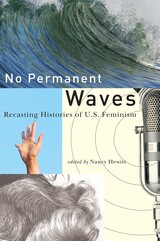 No Permanent Waves: Recasting Histories of U.S. Feminism
Hewitt, Nancy A
Rutgers University Press, 2010 No Permanent Waves boldly enters the ongoing debates over the utility of the "wave" metaphor for capturing the complex history of women's rights by offering fresh perspectives on the diverse movements that comprise U.S. feminism, past and present. Seventeen essays--both original and reprinted--address continuities, conflicts, and transformations among women's movements in the United States from the early nineteenth century through today.
A respected group of contributors from diverse generations and backgrounds argue for new chronologies, more inclusive conceptualizations of feminist agendas and participants, and fuller engagements with contestations around particular issues and practices. Race, class, and sexuality are explored within histories of women's rights and feminism as well as the cultural and intellectual currents and social and political priorities that marked movements for women's advancement and liberation. These essays question whether the concept of waves surging and receding can fully capture the complexities of U.S. feminisms and suggest models for reimagining these histories from radio waves to hip-hop.
No Place But Here: A Teacher’s Vocation in a Rural Community
Garret Keizer
University Press of New England, 1996 Weaving anecdotal narrative with trenchant reflections on his profession, Garret Keizer offers one teacher's answer to the hue and cry over the crisis in education. An English teacher in rural Vermont, he writes of the opposing realities he faces every day: the promise and energy of the young and the oppressive effect of their economic disadvantages; the beauty of the countryside and its people and the harsh, sometimes ugly edge of life there; the need for discipline and the importance of rebellion. In exploring the demands peculiar to his own community, Keizer movingly depicts the difficulties-some triumphantly overcome, some overwhelming-that form the heart of teaching anywhere.
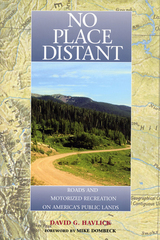 No Place Distant: Roads And Motorized Recreation On America's Public Lands
David G. Havlick; Foreword by Michael P. Dombeck
Island Press, 2002 While many of the roads on public lands provide a great service with relatively little harm, others create significant problems -- from habitat fragmentation to noise pollution to increased animal mortality -- with little or no benefit. In No Place Distant, author David Havlick presents for the first time a comprehensive and in-depth examination of the more than 550,000 miles of roads that crisscross our national parks, national forests, Bureau of Land Management lands, and wildlife refuges, considering how they came to be; their ecological, financial, and societal costs; and what can be done to ensure that those roads are as environmentally benign and cost-effective as possible, while remaining functional and accessible. The book: - places the profusion of roads on our public lands in historical context
- offers an overview of the ecological effects of roads
- explores the policies, politics, and economics that have fostered road-building on public lands
- considers the contentious topic of motorized recreation
- examines efforts to remove roads and restore degraded lands to health
Bringing together an impressive range and depth of information along with a thoughtful analysis of the issues, No Place Distant offers a definitive look at the debate over roads on public lands. With its well-crafted prose and extensive documentation, it is an unparalleled resource for anyone concerned with the health or management of public lands in the United States.
 No Place Else: Explorations in Utopian and Dystopian Fiction
Eric S Rabkin
Southern Illinois University Press, 1983
Writers have created fictions of social perfection at least since Plato’s Republic. Sir Thomas More gave this thread of intellectual history a name when he called his contribution to it Utopia, Greek for noplace.
With each subsequent author cognizant of his predecessors and subject to altered real-world conditions which suggest ever-new causes for hope and alarm, “no place” changed. The fourteen essays presented in this book critically assess man’s fascination with and seeking for “no place.”
“In discussing these central fictions, the contributors see ‘no place’ from diverse perspectives: the sociological, the psychological, the political, the aesthetic. In revealing the roots of these works, the contributors cast back along the whole length of utopian thought. Each essay stands alone; together, the essays make clear what ‘no place’ means today. While it may be true that ‘no place’ has always seemed elsewhere or elsewhen, in fact all utopian fiction whirls contemporary actors through a costume dance no place else but here.”—from the Preface
The contributors are Eric S. Rabkin, B. G. Knepper, Thomas J.Remington, Gorman Beauchamp, William Matter, Ken Davis, Kenneth M. Roemer, William Steinhoff, Howard Segal, Jack Zipes, Kathleen Woodward, Merritt Abrash, and James W. Bittner.
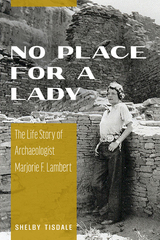 No Place for a Lady: The Life Story of Archaeologist Marjorie F. Lambert
Shelby Tisdale
University of Arizona Press, 2023 In the first half of the twentieth century, the canyons and mesas of the Southwest beckoned and the burgeoning field of archaeology thrived. Among those who heeded the call, Marjorie Ferguson Lambert became one of only a handful of women who left their imprint on the study of southwestern archaeology and anthropology.
In this delightful biography, we gain insight into a time when there were few women establishing full-time careers in anthropology, archaeology, or museums. Shelby Tisdale successfully combines Lambert’s voice from extensive interviews with her own to take us on a thought-provoking journey into how Lambert created a successful and satisfying professional career and personal life in a place she loved (the American Southwest) while doing what she loved.
Through Lambert’s life story we gain new insight into the intricacies and politics involved in the development of archaeology and museums in New Mexico and the greater Southwest. We also learn about the obstacles that young women had to maneuver around in the early years of the development of southwestern archaeology as a profession. Tisdale brings into focus one of the long-neglected voices of women in the intellectual history of anthropology and archaeology and highlights how gender roles played out in the past in determining the career paths of young women. She also highlights what has changed and what has not in the twenty-first century.
Women’s voices have long been absent throughout history, and Marjorie Lambert’s story adds to the growing literature on feminist archaeology.
No Place for a Woman: A Life of Senator Margaret Chase Smith
Sherman, Janann
Rutgers University Press, 1999 No Place for a Woman is the first biography to analyze Margaret Chase Smith’s life and times by using politics and gender as the lens through which we can understand this Maine senator’s impact on American politics and American women. Sherman’s research is based upon more than one hundred hours of personal interviews with Senator Smith, and extensive research in primary and government documents, including those from the holdings of the Margaret Chase Smith Library.
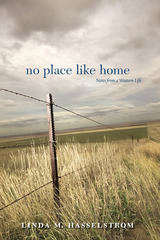 No Place Like Home: Notes from a Western Life
Linda M. Hasselstrom
University of Nevada Press, 2010 In No Place Like Home, Linda Hasselstrom ponders the changing nature of community in the modern West, where old family ranches are being turned into subdivisions and historic towns are evolving into mean, congested cities. Her scrutiny, like her life, moves back and forth between her ranch on the South Dakota prairie and her house in an old neighborhood at the edge of downtown Cheyenne, Wyoming. The vignettes that form the foundation of her consideration are drawn from the communities she has known during her life in the West, reflecting on how they have grown, thrived, failed, and changed, and highlighting the people and decisions that shaped them. Hasselstrom’s ruminations are both intensely personal and universal. She laments the disappearance of the old prairie ranches and the rural sense of community and mutual responsibility that sustained them, but she also discovers that a spirit of community can be found in unlikely places and among unlikely people. The book defines her idea of how a true community should work, and the kind of place she wants to live in. Her voice is unique and honest, both compassionate and cranky, full of love for the harsh, hauntingly beautiful short-grass prairie that is her home, and rich in understanding of the intricacies of the natural world around her and the infinite potentials of human commitment, hope, and greed. For anyone curious about the state of the contemporary West, Hasselstrom offers a report from the front, where nature and human aspirations are often at odds, and where the concepts of community and mutual responsibility are being redefined.
No Place Like Home: Relationships and Family Life among Lesbians and Gay Men
Christopher Carrington
University of Chicago Press, 1999 In this rich, surprising portrait of the world of lesbian and gay relationships, Christopher Carrington unveils the complex and artful ways that gay people create and maintain both homes and "chosen" families for themselves.
"Carefully separating stereotype from reality, Carrington investigates family in the gay and lesbian community. Relying upon interviews and observation, the author analyzes the loves and routings of 52 diverse lesbian, gay, and bisexual couples in the Bay area. . . . [He] closes the work with a discussion of the raging same-sex marriage debate and posits an enlightened solution to this dilemma." —Library Journal
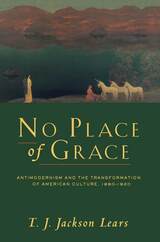 No Place of Grace: Antimodernism and the Transformation of American Culture, 1880–1920
T. J. Jackson Lears
University of Chicago Press, 1994 T. J. Jackson Lears draws on a wealth of primary sources — sermons, diaries, letters — as well as novels, poems, and essays to explore the origins of turn-of-the-century American antimodernism. He examines the retreat to the exotic, the pursuit of intense physical or spiritual experiences, and the search for cultural self-sufficiency through the Arts and Crafts movement. Lears argues that their antimodern impulse, more pervasive than historians have supposed, was not "simple escapism," but reveals some enduring and recurring tensions in American culture.
"It's an understatement to call No Place of Grace a brilliant book. . . . It's the first clear sign I've seen that my generation, after marching through the '60s and jogging through the '70s might be pausing to examine what we've learned, and to teach it."—Walter Kendrick, Village Voice
"One can justly make the claim that No Place of Grace restores and reinterprets a crucial part of American history. Lears's method is impeccable."—Ann Douglas, The Nation
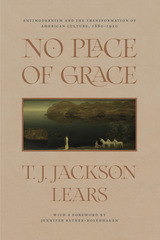 No Place of Grace: Antimodernism and the Transformation of American Culture, 1880-1920
T. J. Jackson Lears
University of Chicago Press, 2021 A new edition of a classic work of American history that eloquently examines the rise of antimodernism at the turn of the twentieth century.
First published in 1981, T. J. Jackson Lears’s No Place of Grace is a landmark book in American studies and American history, acclaimed for both its rigorous research and the deft fluidity of its prose. A study of responses to the emergent culture of corporate capitalism at the turn of the twentieth century, No Place of Grace charts the development of contemporary consumer society through the embrace of antimodernism—the effort among middle- and upper-class Americans to recapture feelings of authentic experience. Rather than offer true resistance to the increasingly corporatized bureaucracy of the time, however, antimodernism helped accommodate Americans to the new order—it was therapeutic rather than oppositional, a striking forerunner to today’s self-help culture. And yet antimodernism contributed a new dynamic as well, “an eloquent edge of protest,” as Lears puts it, which is evident even today in anticonsumerism, sustainable living, and other practices. This new edition, with a lively and discerning foreword by Jennifer Ratner-Rosenhagen, celebrates the fortieth anniversary of this singular work of history.
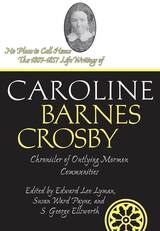 No Place To Call Home: The 1807-1857 Life Writings of Caroline Barnes Crosby, Chronicler of Outlying Mormon Communities
Edward Leo Lyman, Susan Ward Payne, and S. George Ellsworth
Utah State University Press, 2020 Caroline Crosby's life took a wandering course between her 1834 marriage to Jonathan Crosby and conversion to the infant Mormon Church and her departure for her final home, Utah, on New Year's Day, 1858. In the intervening years, she lived in many places but never long enough to set firm roots. Her adherence to a frontier religion on the move kept her moving, even after the church began to settle down in Utah. Despite the impermanence of her situation—perhaps even because of it—Caroline Crosby left a remarkably rich record of her life and travels, thereby telling us not only much about herself and her family but also about times and places of which her documentary record provides a virtually unparalleled view. A notable aspect of her memoirs and journals is what they convey of the character of their author, who, despite the many challenges of transience and poverty she faced, appears to have remained curious, dedicated, observant, and optimistic. From Caroline's home in Canada, she and Jonathan Crosby first went to the headquarters of Joseph Smith's new church in Kirtland, Ohio. She recounts, in a memoir, the early struggles of his followers there. As the church moved west, the Crosbys did as well, but, as became characteristic, they did not move immediately with the main body to the center of the religion. For a while they settled in Indiana, finally reaching the new Mormon center of Nauvoo in 1842. Fleeing Nauvoo with the last of the Mormons in 1846, they spent two years in Iowa and set out for Utah in 1848, the account of which is the first of Caroline Crosby's vivid trail journals. The Crosbys were able to rest in Salt Lake City for less than two years before Brigham Young sent them on a church mission to the Society and Austral Islands in the South Pacific. She recorded, in detail, their overland travel to San Francisco and then by sea to French Polynesia and their service on the islands. In late 1852 the Crosbys returned to California, beginning what is probably the most historically significant time recorded in her writings, her diaries of life. First, in immediately post-Gold-Rush San Francisco and, second, in the new Mormon village of San Bernardino in southern California. There is no comparable record by a woman of 1850s life in these growing communities. The Crosbys responded in 1857 to Brigham Young's call for church members to gather in Utah and again abandoned a new home—the nicest one they had built and one of the finest houses in San Bernardino—again displaying their unquestioning loyalty to the Mormon church.
No Place to Hide: Gang, State, and Clandestine Violence in El Salvador
Laura Pedraza Fariña, Spring Miller, and James L. Cavallaro
Harvard University Press, 2010 Seventeen years after the civil war in El Salvador came to an end, violence and insecurity continue to shape the daily lives of many Salvadorans. This book examines the phenomenon of youth gangs, as well as related police abuse, clandestine violence, and their collective impact on the rule of law. Beginning with an evaluation of the historical legacy of violence in El Salvador and the limitations of postwar efforts to construct functioning democratic and judicial institutions, No Place to Hide analyzes the dynamic evolution of violent street gangs and the Salvadoran state’s responses to gang-related and other forms of violence. The book’s findings are based on primary research conducted in El Salvador between 2006 and 2008.
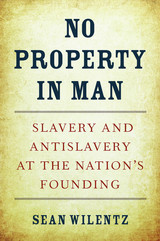 No Property in Man: Slavery and Antislavery at the Nation’s Founding
Sean Wilentz
Harvard University Press, 2018 A radical reconstruction of the founders’ debate over slavery and the Constitution.
Americans revere the Constitution even as they argue fiercely over its original toleration of slavery. Some historians have charged that slaveholders actually enshrined human bondage at the nation’s founding. The acclaimed political historian Sean Wilentz shares the dismay but sees the Constitution and slavery differently. Although the proslavery side won important concessions, he asserts, antislavery impulses also influenced the framers’ work. Far from covering up a crime against humanity, the Constitution restricted slavery’s legitimacy under the new national government. In time, that limitation would open the way for the creation of an antislavery politics that led to Southern secession, the Civil War, and Emancipation.
Wilentz’s controversial and timely reconsideration upends orthodox views of the Constitution. He describes the document as a tortured paradox that abided slavery without legitimizing it. This paradox lay behind the great political battles that fractured the nation over the next seventy years. As Southern Fire-eaters invented a proslavery version of the Constitution, antislavery advocates, including Abraham Lincoln and Frederick Douglass, proclaimed antislavery versions based on the framers’ refusal to validate what they called “property in man.”
No Property in Man invites fresh debate about the political and legal struggles over slavery that began during the Revolution and concluded with the Confederacy’s defeat. It drives straight to the heart of the most contentious and enduring issue in all of American history.
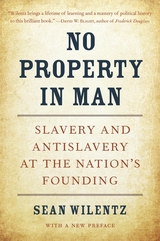 No Property in Man: Slavery and Antislavery at the Nation’s Founding, With a New Preface
Sean Wilentz
Harvard University Press, 2019 “Wilentz brings a lifetime of learning and a mastery of political history to this brilliant book.”
—David W. Blight, author of Frederick Douglass
A New York Times Book Review Editors’ Choice
A Foreign Affairs Best Book of the Year
Americans revere the Constitution even as they argue fiercely over its original toleration of slavery. In this essential reconsideration of the creation and legacy of our nation’s founding document, Sean Wilentz reveals the tortured compromises that led the Founders to abide slavery without legitimizing it, a deliberate ambiguity that fractured the nation seventy years later. Contesting the Southern proslavery version of the Constitution, Abraham Lincoln and Frederick Douglass pointed to the framers’ refusal to validate what they called “property in man.” No Property in Man has opened a fresh debate about the political and legal struggles over slavery that began during the Revolution and concluded with the Civil War. It drives straight to the heart of the single most contentious issue in all of American history.
“Revealing and passionately argued…[Wilentz] insists that because the framers did not sanction slavery as a matter of principle, the antislavery legacy of the Constitution has been…‘misconstrued’ for over 200 years.”
—Khalil Gibran Muhammad, New York Times
“Wilentz’s careful and insightful analysis helps us understand how Americans who hated slavery, such as Abraham Lincoln and Frederick Douglass, could come to see the Constitution as an ally in their struggle.”
—Eric Foner
No Quittin' Sense
By the Reverend C. C. White and Ada Morehead Holland
University of Texas Press, 1994 This story, set in the Piney Woods country of East Texas, spans most of a century, from shortly after the close of the Civil War to the 1960's. It is the story of Charley White, who was born in the middle of those woods—in a decaying windowless log cabin a few years after his mother and father were freed from slavery. His childhood, lived in almost unbelievable poverty, was followed by financial stability achieved in middle age through years of struggle. And then, in order to obey God's will, he abandoned this secure life, and for forty years he waged a one-man war on poverty and intolerance. Winner of the Carr P. Collins Award (best nonfiction book) of the Texas Institute of Letters, No Quittin' Sense presents the story of Rev. C. C. "Charley" White, whose life has inspired thousands of readers since the book was first published in 1969.
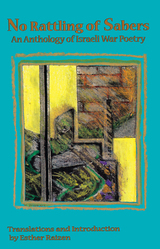 No Rattling of Sabers: An Anthology of Israeli War Poetry
Translation and introduction by Esther Raizen
University of Texas Press, 1995 <p>In this collection, Esther Raizen explores the significance and value of Hebrew poetry written in response to the wars in which Israel was involved during the last fifty years. The anthology includes the works of many poets, some as well known as Nathan Altherman and Yehudah Amichai and others less known. The poems, presented in both English and Hebrew, depict war as viewed by the soldier, as reflected upon by civilians, and as a force giving rise to the creation of poetry.</p>
<p>Raizen explores in an introductory essay the issue of whether poetry written with a defined political message and in the context of certain historical events can function adequately on the aesthetic level. She also tracks the changes in the characteristics of Israeli war poetry from 1948 to 1991, beginning with the glorified patriotism expected in the 1930s-1940s and progressing to the critical ideas in the later years, during which poetry is characterized by understatement and cynicism.</p>
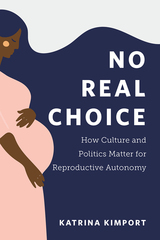 No Real Choice: How Culture and Politics Matter for Reproductive Autonomy
Katrina Kimport
Rutgers University Press, 2022 In the United States, the “right to choose” an abortion is the law of the land. But what if a woman continues her pregnancy because she didn’t really have a choice? What if state laws, federal policies, stigma, and a host of other obstacles push that choice out of her reach?
Based on candid, in-depth interviews with women who considered but did not obtain an abortion, No Real Choice punctures the myth that American women have full autonomy over their reproductive choices. Focusing on the experiences of a predominantly Black and low-income group of women, sociologist Katrina Kimport finds that structural, cultural, and experiential factors can make choosing abortion impossible–especially for those who experience racism and class discrimination. From these conversations, we see the obstacles to “choice” these women face, such as bans on public insurance coverage of abortion and rampant antiabortion claims that abortion is harmful. Kimport's interviews reveal that even as activists fight to preserve Roe v. Wade, class and racial disparities have already curtailed many women’s freedom of choice.
No Real Choice analyzes both the structural obstacles to abortion and the cultural ideologies that try to persuade women not to choose abortion. Told with care and sensitivity, No Real Choice gives voice to women whose experiences are often overlooked in debates on abortion, illustrating how real reproductive choice is denied, for whom, and at what cost.
 No Religion without Idolatry: Mendelssohn's Jewish Enlightenment
Gideon Freudenthal
University of Notre Dame Press, 2012
Moses Mendelssohn (1725–1786) is considered the foremost representative of Jewish Enlightenment. In No Religion without Idolatry, Gideon Freudenthal offers a novel interpretation of Mendelssohn’s general philosophy and discusses for the first time Mendelssohn’s semiotic interpretation of idolatry in his Jerusalem and in his Hebrew biblical commentary. Mendelssohn emerges from this study as an original philosopher, not a shallow popularizer of rationalist metaphysics, as he is sometimes portrayed. Of special and lasting value is his semiotic theory of idolatry.
From a semiotic perspective, both idolatry and enlightenment are necessary constituents of religion. Idolatry ascribes to religious symbols an intrinsic value: enlightenment maintains that symbols are conventional and merely signify religious content but do not share its properties and value. Without enlightenment, religion degenerates to fetishism; without idolatry it turns into philosophy and frustrates religious experience. Freudenthal demonstrates that in Mendelssohn’s view, Judaism is the optimal religious synthesis. It consists of transient ceremonies of a “living script.” Its ceremonies are symbols, but they are not permanent objects that could be venerated. Jewish ceremonies thus provide a religious experience but frustrate fetishism. Throughout the book, Freudenthal fruitfully contrasts Mendelssohn's views on religion and philosophy with those of his contemporary critic and opponent, Salomon Maimon. No Religion without Idolatry breaks new ground in Mendelssohn studies. It will interest students and scholars in philosophy of religion, Judaism, and semiotics.
"In this lucid and provocative study, Gideon Freudenthal offers an original and compelling reading of Mendelssohn as well as a defense of the possibility of religious rationalism more generally. This book is not only an excellent contribution to a growing body of scholarship on Mendelssohn and early modern philosophy, but it also significantly sharpens and advances contemporary conversations about the relations between religion and reason." —Leora Batnitzky, Princeton University
"In this masterful study, Gideon Freudenthal demonstrates how Mendelssohn’s philosophy, including his philosophy of religion, is grounded in semiotics. The result is a landmark work that not only successfully challenges standard interpretations of Mendelssohn’s 'enlightened Judaism' and its alleged inconsistency but also effectively invites reconsideration of the very possibility of 'religion without idolatry.'" —Daniel O. Dahlstrom, Boston University
"In focusing on Mendelssohn's 'semiotics of idolatry,' Gideon Freudenthal writes as a philosopher fully at home in multiple traditions: contemporary philosophy, eighteenth-century philosophy, Jewish biblical exegesis, and comparative religion. The result is a systematic and penetrating study, based on the Hebrew as well as the German texts, that engages Mendelssohn on perhaps the most critical issue of his understanding of religion with unprecedented philosophical rigor and imagination." —David Sorkin, City University of New York Graduate Center
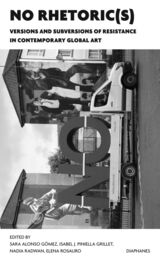 NO Rhetoric(s): Versions and Subversions of Resistance in Contemporary Global Art
Edited by Sara Alonso Gómez, Isabel J. Piniella Grillet, Nadia Radwan, and Elena Rosauro
Diaphanes, 2021 An incisive examination of the intersection of global art and political resistance.
NO Rhetoric(s) examines a subject intensely debated during the last three decades but rarely a topic of its own: art as an agent of resistance, whether as a rhetorical stance or critical strategy. In the face of today’s discourse on revolt and insurrection, it is necessary to ask whether the gesture of “negation” still has an emancipatory potential. NO Rhetoric(s) contributes a deeper understanding of the different logics of resistance at play between art and politics. Showcasing a diverse array of voices, this volume presents contributions on topics as varied as sexual dissidence, ecology, and geopolitics in the digital age. Through this interdisciplinary show of force, the collected authors, artists, and scholars shed light on how art approaches the most urgent issues facing today’s society.
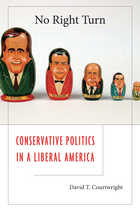 No Right Turn: Conservative Politics in a Liberal America
David T. Courtwright
Harvard University Press, 2010 Few question the “right turn” America took after 1966, when liberal political power began to wane. But if they did, No Right Turn suggests, they might discover that all was not really “right” with the conservative golden age. A provocative overview of a half century of American politics, the book takes a hard look at the counterrevolutionary dreams of liberalism’s enemies—to overturn people’s reliance on expanding government, reverse the moral and sexual revolutions, and win the Culture War—and finds them largely unfulfilled.
David Courtwright deftly profiles celebrated and controversial figures, from Clare Boothe Luce, Barry Goldwater, and the Kennedy brothers to Jerry Falwell, David Stockman, and Lee Atwater. He shows us Richard Nixon’s keen talent for turning popular anxieties about morality and federal meddling to Republican advantage—and his inability to translate this advantage into reactionary policies. Corporate interests, boomer lifestyles, and the media weighed heavily against Nixon and his successors, who placated their base with high-profile attacks on crime, drugs, and welfare dependency. Meanwhile, religious conservatives floundered on abortion and school prayer, obscenity, gay rights, and legalized vices like gambling, and fiscal conservatives watched in dismay as the bills mounted.
We see how President Reagan’s mélange of big government, strong defense, lower taxes, higher deficits, mass imprisonment, and patriotic symbolism proved an illusory form of conservatism. Ultimately, conservatives themselves rebelled against George W. Bush’s profligate brand of Reaganism. Courtwright’s account is both surprising and compelling, a bracing argument against some of our most cherished clichés about recent American history.
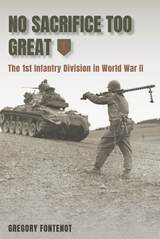 No Sacrifice Too Great: The 1st Infantry Division in World War II
Gregory Fontenot
University of Missouri Press, 2023 Winner of the 2023 Army Historical Foundation Distinguished Writing Award for Unit History
The U.S. 1st Infantry Division (1st ID), familiarly known as the Big Red One, adapted to dynamic battlefield conditions throughout the course of its deployment during World War II by innovating and altering behavior, including tactics, techniques, and procedures. Both the Division’s leaders and soldiers accomplished this by thinking critically about their experiences in combat and wasting little time in putting lessons learned to good use. Simply put, they learned on the job—in battle and after battle—and did so quickly.
In telling the Division’s WWII story, which includes an extensive photographic essay featuring many previously unpublished images, Gregory Fontenot includes the stories of individual members of the Big Red One, from high-ranking officers to enlisted men fresh off the streets of Brooklyn, both during and after the conflict. Colonel Fontenot’s rare ability to combine expert analysis with compelling narrative history makes No Sacrifice Too Great an absorbing read for anyone interested in the military history of the United States.
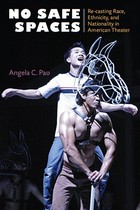 No Safe Spaces: Re-casting Race, Ethnicity, and Nationality in American Theater
Angela C. Pao
University of Michigan Press, 2010 "No Safe Spaces opens up a conversation beyond narrow polemics . . . Although cross-racial casting has been the topic of heated discussion, little sustained scholarship addresses both the historical precedents and theoretical dimensions. Pao illustrates the tensions and contradictions inherent not only in stage representations, but also in the performance of race in everyday life. A wonderful book whose potential readership goes well beyond theater and performance scholars."
---Josephine Lee, University of Minnesota "Non-traditional casting, increasingly practiced in American theater, is both deeply connected to our country's racial self-image(s) and woefully under-theorized. Pao takes on the practice in its entirety to disentangle the various strands of this vitally important issue."
---Karen Shimakawa, New York University No Safe Spaces looks at one of the most radical and enduring changes introduced during the Civil Rights era---multiracial and cross-racial casting practices in American theater. The move to cast Latino/a, African American, and Asian American actors in classic stage works by and about white Europeans and Americans is viewed as both social and political gesture and artistic innovation. Nontraditionally cast productions are shown to have participated in the national dialogue about race relations and ethnic identity and served as a source of renewed creativity for the staging of the canonical repertory. Multiracial casting is explored first through its history, then through its artistic, political, and pragmatic dimensions. Next, the book focuses on case studies from the dominant genres of contemporary American theater: classical tragedy and comedy, modern domestic drama, antirealist drama, and the Broadway musical, using a broad array of archival source materials to enhance and illuminate its arguments. Angela C. Pao is Associate Professor of Comparative Literature at Indiana University. A volume in the series Theater: Theory/Text/Performance
No Sanctuary: Teachers and the School Reform That Brought Gay Rights to the Masses
Stephen Lane
University Press of New England, 2018 School can be a special sort of nightmare for LGBTQ youth, who are sometimes targets of verbal or physical harassment with nowhere to turn for support. No Sanctuary tells the inspiring story of a mostly unseen rescue attempt by a small group of teachers who led the push to make schools safer for these at-risk students. Their efforts became the blueprint for Massachusetts’s education policy and a nationwide movement, resulting in one of the most successful and far-reaching school reform efforts in recent times. Stephen Lane sheds light on this largely overlooked but critical series of reforms, placing the Safe Schools movement within the context of the larger gay rights movement and highlighting its key role in fostering greater acceptance of LGBTQ individuals throughout society.
 No Second Eden: Poems
Turner Cassity
Ohio University Press, 2002 If you think that Turner Cassity has mellowed or slowed down since the 1998 release of his selected poems, The Destructive Element, think again. In No Second Eden Cassity is back more Swiftian than ever. Among the targets reduced to ruin are countertenors, parole boards, the French Symbolists, calendar reformers, the Yale Divinity School, and the cult of Elvis. Without turning a blind eye, he even extends a toast to Wernher von Braun. Surprisingly, there is a poem about the Mississippi in which Cassity grew up. Unsurprisingly, it is a vision quite unlike others of that state. Its chilly and amusing precision is about as far from Southern Gothic as you can get, although elsewhere there are faint hints of a failed Good Ole Boy. Indeed, the final poems in the collection are a bit more personal than one expects of this writer. As rigorous in form as they are in feeling, the poems of No Second Eden are not for those with preconceived ideas of poetry or its purpose. Early in Cassity’s career, James Merrill described Cassity’s work as “an opera house in the jungle.” True so far as it goes, but he might also have called it the jungle in the opera house: a glimpse at the savagery behind every façade.
 No Shelf Required 3: The New Era for E-Books and Digital Content
Mirela Roncevic
American Library Association, 2022 Many claim that the presence and importance of e-books in the library world have reached a saturation point, but the truth is that experimentation with new models, as well as refinement of existing ones, continues apace. Delving into the latest developments among the varied players in the e-book marketplace, including publishers, libraries, and vendors, the latest volume in the best-selling No Shelf Required series is written from a strong international perspective. Such cutting-edge contributors as Michael Blackwell, Mary Minow, Neil Butcher, and Tonya McQuade discuss a range of groundbreaking initiatives that tap into the potential of digital content to be omnipresent. Positive, uplifting, instructive, and goal-oriented, this volume’s coverage includes - the DPLA national e-book platform;
- ReadersFirst, a movement to improve e-book access from libraries;
- the AudiobookSYNC project, a free summer audiobook program for teens;
- using e-books to teach poetry and publishing processes;
- the Multnomah County Library Library Writers project;
- the Internet Archive and e-books; and
- e-books and sustainable literacy in Africa.
No Short Journeys: The Interplay of Cultures in the History and Literature of the Borderlands
Cecil Robinson
University of Arizona Press, 1992 "These thirteen essays comprise a richly patterned 'quilt,' expertly addressing the influence of Mexico and Latin and South America upon the North American imagination. . . . Cecil Robinson's impressive breadth of expertise, his fascinating interpretations, make this collection of essays invaluable regional reading. The bibliography alone is a treasure—a gift from a man whose life's work was to form a bridge of humanistic understanding between the two primary cultures of the New World."—El Palacio
"In graceful prose, the longtime English professor leads readers on a leisurely stroll through the literary landscape of the Southwest."—Journal of Arizona History
"Does more for reconstructing American literature than any of the contemporary American literature anthologies that are on the market today. . . . Strongly recommended."—Choice
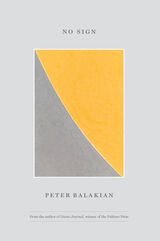 No Sign
Peter Balakian
University of Chicago Press, 2022 New poetry collection from Peter Balakian, author of Ozone Journal, winner of the Pulitzer Prize.
In these poems, Peter Balakian wrestles with national and global cultural and political realities, including challenges for the human species amid planetary transmutation and the impact of mass violence on the self and culture. At the collection’s heart is “No Sign,” another in Balakian’s series of long-form poems, following “A-Train/Ziggurat/Elegy” and “Ozone Journal,” which appeared in his previous two collections. In this dialogical multi-sectioned poem, an estranged couple encounters each other, after years, on the cliffs of the New Jersey Palisades. The dialogue that ensues reveals the evolution of a kaleidoscopic memory spanning decades, reflecting on the geological history of Earth and the climate crisis, the film Hiroshima Mon Amour, the Vietnam War, a visionary encounter with the George Washington Bridge, and the enduring power of love..
Whether meditating on the sensuality of fruits and vegetables, the COVID-19 pandemic, the trauma and memory of the Armenian genocide, James Baldwin in France, or Arshile Gorky in New York City, Balakian’s layered, elliptical language, wired phrases, and shifting tempos engage both life’s harshness and beauty and define his inventive and distinctive style.
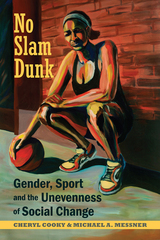 No Slam Dunk: Gender, Sport and the Unevenness of Social Change
Cooky, Cheryl
Rutgers University Press, 2018 In just a few decades, sport has undergone a radical gender transformation. However, Cheryl Cooky and Michael A. Messner suggest that the progress toward gender equity in sports is far from complete. The continuing barriers to full and equal participation for young people, the far lower pay for most elite-level women athletes, and the continuing dearth of fair and equal media coverage all underline how much still has yet to change before we see gender equality in sports.
The chapters in No Slam Dunk show that is this not simply a story of an “unfinished revolution.” Rather, they contend, it is simplistic optimism to assume that we are currently nearing the conclusion of a story of linear progress that ends with a certain future of equality and justice. This book provides important theoretical and empirical insights into the contemporary world of sports to help explain the unevenness of social change and how, despite significant progress, gender equality in sports has been “No Slam Dunk.”
No Small Gift
Jennifer Franklin
Four Way Books, 2018 Populated with ghosts from the past and contemporary victims of cruelty, these poems focus on the stories of a woman diagnosed with cancer during a divorce and a mother struggling with her daughter’s autism and epilepsy.
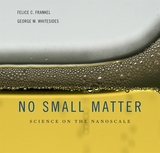 No Small Matter: Science on the Nanoscale
Felice C. Frankel and George M. Whitesides
Harvard University Press, 2009 A small revolution is remaking the world. The only problem is, we can’t see it. This book uses dazzling images and evocative descriptions to reveal the virtually invisible realities and possibilities of nanoscience. An introduction to the science and technology of small things, No Small Matter explains science on the nanoscale.
Authors Felice C. Frankel and George M. Whitesides offer an overview of recent scientific advances that have given us our ever-shrinking microtechnology—for instance, an information processor connected by wires only 1,000 atoms wide. They describe the new methods used to study nanostructures, suggest ways of understanding their often bizarre behavior, and outline their uses in technology. This book explains the various means of making nanostructures and speculates about their importance for critical developments in information processing, computation, biomedicine, and other areas.
No Small Matter considers both the benefits and the risks of nano/microtechnology—from the potential of quantum computers and single-molecule genomic sequencers to the concerns about self-replicating nanosystems. By making the practical and probable realities of nanoscience as comprehensible and clear as possible, the book provides a unique vision of work at the very boundaries of modern science.
 No Small Thing
Gabriel Fried
Four Way Books, 2025 Like an itinerant evangelist, poet Gabriel Fried transforms every space he enters with a sacred kind of attention. If “the big-top makes a chapel of the fetid / lot between the ballpark and the river, / where the air sticks like a rancid jam,” Fried erects poetry in each humid landscape of our feverish lives. And the roaming world of childhood to which No Small Thing returns us is one where shapes and selves may shift in one blessed blink. Defter than nostalgia, slyer than sentiment, the voices of these poems cast just so many spells of indeterminacy. Behind their looking glass, Gabriel Fried guides us down the corridors where sociality and gender, religion and ethnicity, language and identity negotiate their forms. The richly saturated subjects of No Small Thing range from pastoral youth, ancestral tenements, and remembered ghettos to the revival tent, child preachers, and the word-encrusted performances of the grown but still enchanted poet. Fried’s work captures the earthy and illusory magic of poetry, as if performing a “negative-numbered, phantasmagoric” self-portraiture with only “a fogged-up looking glass.”
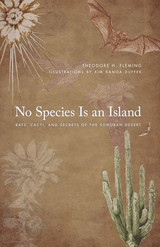 No Species Is an Island: Bats, Cacti, and Secrets of the Sonoran Desert
Theodore H. Fleming; Illustrations by Kim Kanoa Duffek
University of Arizona Press, 2017 In the darkness of the star-studded desert, bats and moths feed on the nectar of night-blooming cactus flowers. By day, birds and bees do the same, taking to blooms for their sweet sustenance. In return these special creatures pollinate the equally intriguing plants in an ecological circle of sustainability.
The Sonoran Desert is the most biologically diverse desert in the world. Four species of columnar cacti, including the iconic saguaro and organ pipe, are among its most conspicuous plants. No Species Is an Island describes Theodore H. Fleming’s eleven-year study of the pollination biology of these species at a site he named Tortilla Flats in Sonora, Mexico, near Kino Bay.
Now Fleming shares the surprising results of his intriguing work. Among the novel findings are one of the world’s rarest plant-breeding systems in a giant cactus; the ability of the organ pipe cactus to produce fruit with another species’ pollen; the highly specialized moth-cactus pollination system of the senita cactus; and the amazing lifestyle of the lesser long-nosed bat, the major nocturnal pollinator of three of these species.
These discoveries serve as a primer on how to conduct ecological research, and they offer important conservation lessons for us all. Fleming highlights the preciousness of the ecological web of our planet—Tortilla Flats is a place where cacti and migratory bats and birds connect such far-flung habitats as Mexico’s tropical dry forest, the Sonoran Desert, and the temperate rain forests of southeastern Alaska. Fleming offers an insightful look at how field ecologists work and at the often big surprises that come from looking carefully at a natural world where no species stands alone.
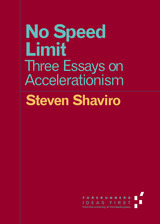 No Speed Limit: Three Essays on Accelerationism
Steven Shaviro
University of Minnesota Press, 2015 Accelerationism is the bastard offspring of a furtive liaison between Marxism and science fiction. Its basic premise is that the only way out is the way through: to get beyond capitalism, we need to push its technologies to the point where they explode. This may be dubious as a political strategy, but it works as a powerful artistic program. Other authors have debated the pros and cons of accelerationist politics; No Speed Limit makes the case for an accelerationist aesthetics. Our present moment is illuminated, both for good and for ill, in the cracked mirror of science-fictional futurity.
Forerunners: Ideas First is a thought-in-process series of breakthrough digital publications. Written between fresh ideas and finished books, Forerunners draws on scholarly work initiated in notable blogs, social media, conference plenaries, journal articles, and the synergy of academic exchange. This is gray literature publishing: where intense thinking, change, and speculation take place in scholarship.
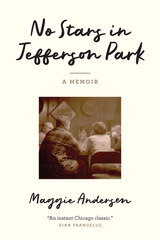 No Stars in Jefferson Park: A Memoir
Maggie Andersen
Northwestern University Press, 2026 A Chicagoan’s coming-of-age memoir finds courage in the face of immense loss In her early twenties, Maggie Andersen was a founding ensemble member of Chicago’s storied Gift Theatre with her then-boyfriend, Michael Patrick Thornton. But after a series of spinal strokes left Thornton paralyzed, Andersen made the heart-wrenching decision to leave him, along with their growing company and, later, her beloved city. No Stars in Jefferson Park alternates between two narratives: the energy and excitement of making art in Chicago’s thriving storefront theater scene and the devastating day-to-day realities of rehabilitation and rebuilding—and somewhere in the middle finding the courage to choose yourself. Over the past twenty-plus years, the Gift—now performing in the working-class neighborhood of Portage Park—has become one of the most vital storefront theaters in Chicago, with Thornton’s career taking him to Hollywood and Broadway. But Andersen’s story has brought her back home. No Stars in Jefferson Park is a testament to lifelong friendship, a love letter to Chicago, and a profound coming-of-age story about the pain and necessity of putting yourself first.
No State Shall Abridge: The Fourteenth Amendment and the Bill of Rights
Michael Kent Curtis
Duke University Press, 1990 “The book is carefully organized and well written, and it deals with a question that is still of great importance—what is the relationship of the Bill of Rights to the states.”— Journal of American History“Curtis effectively settles a serious legal debate: whether the framers of the 14th Amendment intended to incorporate the Bill of Rights guarantees and thereby inhibit state action. Taking on a formidable array of constitutional scholars, . . . he rebuts their argument with vigor and effectiveness, conclusively demonstrating the legitimacy of the incorporation thesis. . . . A bold, forcefully argued, important study.”—Library Journal
 No Storm, Just Weather
Judith Kuckart
Seagull Books, 2023 An engaging exploration of romance focusing on disparate ages of lovers.
Sunday evening, Tegel Airport, Berlin: A woman strikes up a conversation with a man, Robert Sturm, who is thirty-six years old and eighteen years her junior. He is on his way to Siberia and will return the following Saturday. She cannot wait . . .
In 1981 she came to West Berlin as an eighteen-year-old to study medicine and met Viktor, who was twice her age. Though he opened the world up to her, he remained closed himself. At the turn of the millennium and thirty-six, she meets Johann. He is thirty-six too. They try to make a life together, but their jobs aren’t the only things that are precarious. Saturday morning, Tegel Airport again: For six days, her everyday life and her memories have become entwined. Why are the men in her life always thirty-six? Is she still the person she remembers? Or, being someone who knows their way around the mind, is she in fact what she has forgotten?
 (no subject)
Peter Burghardt
Omnidawn, 2022 Poems derived from momentary reflections saved in the poet’s subjectless emails.
The poems of (no subject) are an investigation of the personal and the everyday. This collection draws inspiration from the idea of the quickly written subjectless email, as the poet would clear small periods of time to write and record observations and thoughts, then send it to himself in untitled emails. The book takes the shape of an impressionistic twenty-first-century diary, reflecting on themes of anxiety about the future and the situation of the present. As these moments compound, the line between the present, past, and future is blurred in the conflation of self and memory. Driven by a speaker who is hermetically sealed in their private world, these ostensibly subjectless poems derive their meaning through the tension between narrative and emotional resonances. Through moment-to-moment reflections, (no subject) digs deep in search of the big little feelings transmitted by fatherhood, the fusion of time and space, loneliness, resilience, and wonder.
No Such Country: Essays toward Home
Elmar Lueth
University of Iowa Press, 2002 Matthew Mark Trumbull was a Londoner who immigrated at the age of twenty. Within ten years of his arrival in America, he had become a lawyer in Butler County, Iowa; two years later a member of the state legislature; and two years after that a captain in the Union Army. By the end of the Civil War, he was a brevet brigadier general, and in his later years he was an author and lecturer. Kenneth Lyftogt’s biography details the amazing life of this remarkable man, also shedding light on the histories of the Third Iowa Volunteer Infantry and the Ninth Iowa Volunteer Cavalry.
no swaddle
Mackenzie Kozak
University of Iowa Press, 2025 Mackenzie Kozak examines the complex question of whether or not to bear children. Through a series of untitled American sonnets, the poems speak to themes of origin and desire, noting the shame that can accompany such a decision. Many poetry collections speak to the varied griefs of becoming a mother, losing a child, or being unable to have a child, but this collection gives specific voice to another grief that feels unspeakable: the possible conclusion of not wanting to be a mother.
no swaddle reads as a sort of meditation on theme, its repeated form mirroring the spiraling nature of indecision and reconsideration of the same major question alongside its continuous struggle to name. In the end, this grappling with elements of grief and shame becomes a way of moving toward greater agency and fulfillment.
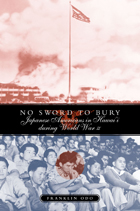 No Sword To Bury: Japanese Americans In Hawaii
Franklin S. Odo
Temple University Press, 2004 When bombs rained down on Pearl Harbor in 1941, Japanese American college students were among the many young men enrolled in ROTC and immediately called upon to defend the Hawaiian islands against invasion. In a few weeks, however, the military government questioned their loyalty and disarmed them. In No Sword to Bury, Franklin Odo places the largely untold story of the wartime experience of these young men in the context of the community created by their immigrant families and its relationship to the larger, white-dominated society. At the heart of the book are vivid oral histories that recall their service on the home front in the Varsity Victory Volunteers, a non-military group dedicated to public works, as well as in the segregated 442nd Regimental Combat Team. Illuminating a critical moment in ethnic identity formation among this first generation of Americans of Japanese descent (the nisei), Odo shows how the war-time service and the post-war success of these men contributed to the simplistic view of Japanese Americans as a model minority in Hawai`i.
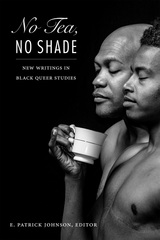 No Tea, No Shade: New Writings in Black Queer Studies
E. Patrick Johnson, editor
Duke University Press, 2016 The follow-up to the groundbreaking Black Queer Studies, the edited collection No Tea, No Shade brings together nineteen essays from the next generation of scholars, activists, and community leaders doing work on black gender and sexuality. Building on the foundations laid by the earlier volume, this collection's contributors speak new truths about the black queer experience while exemplifying the codification of black queer studies as a rigorous and important field of study. Topics include "raw" sex, pornography, the carceral state, gentrification, gender nonconformity, social media, the relationship between black feminist studies and black trans studies, the black queer experience throughout the black diaspora, and queer music, film, dance, and theater. The contributors both disprove naysayers who believed black queer studies to be a passing trend and respond to critiques of the field's early U.S. bias. Deferring to the past while pointing to the future, No Tea, No Shade pushes black queer studies in new and exciting directions. Contributors. Jafari S. Allen, Marlon M. Bailey, Zachary Shane Kalish Blair, La Marr Jurelle Bruce, Cathy J. Cohen, Jennifer DeClue, Treva Ellison, Lyndon K. Gill, Kai M. Green, Alexis Pauline Gumbs, Kwame Holmes, E. Patrick Johnson, Shaka McGlotten, Amber Jamilla Musser, Alison Reed, Ramón H. Rivera-Servera, Tanya Saunders, C. Riley Snorton, Kaila Story, Omise'eke Natasha Tinsley, Julia Roxanne Wallace, Kortney Ziegler
No Time for Fear: Voices of American Military Nurses in World War II
Diane Burke Fessler
Michigan State University Press, 1996 No Time for Fear summons the voices of more than 100 women who served as nurses overseas during World War II, letting them tell their story as no one else can. Fessler has meticulously compiled and transcribed more than 200 interviews with American military nurses of the Army, Army Air Force, and Navy who were present in all theaters of WWII. Their stories bring to life horrific tales of illness and hardship, blinding blizzards, and near starvation—all faced with courage, tenacity, and even good humor. This unique oral-history collection makes available to readers an important counterpoint to the seemingly endless discussions of strategy, planning, and troop movement that often characterize discussions of the Second World War.
no time like now: Poems
Andrei Codrescu
University of Pittsburgh Press, 2019 In Codrescu’s own words: “I wrote my first book of poems, License to Carry a Gun (Big Table, 1970), when I first lived in New York City, 1967–1970. Those were troubled times and I was 21 years-old. Decades later the city has changed and the times are still troubled. These poems, 2016–2018, try to find out just how changed my dear city and how troubled my days.”
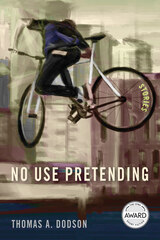 No Use Pretending
Thomas A. Dodson
University of Iowa Press, 2023 Colorado Independent Publishers Association EVVY Award winner, Anthologies
The characters in these stories have been forced into conditions of life that they find unbearable, and the stories chart their often tragically misguided attempts to relieve their suffering via connections with other people or through the pursuit of addictive attachments (to opiates in one story, to sleep in another).
This collection encompasses diverse genres, from ecologically informed realism to a Kafkaesque fairy tale, from fabulist “weird fiction” to an episode from The Odyssey that becomes a meditation on what distinguishes human beings from animals. These stories invite the reader to reconsider moral and ideological certainties, to take a fresh look at such issues as fracking and drone warfare. In one story, a petroleum engineer discovers that one of his wastewater wells may be causing earthquakes, and in another the pilot of an Air Force drone seeks to reconcile his conflicting roles as protector and executioner, husband and soldier. The scientist and the serviceman are both presented with problems that have no easy or obvious solutions, situations that force them to confront the messy, compromising complexity of being human.
No Votes for Women: The New York State Anti-Suffrage Movement
Susan Goodier
University of Illinois Press, 2013 No Votes for Women explores the complicated history of the suffrage movement in New York State by delving into the stories of women who opposed the expansion of voting rights to women. Susan Goodier finds that conservative women who fought against suffrage encouraged women to retain their distinctive feminine identities as protectors of their homes and families, a role they felt was threatened by the imposition of masculine political responsibilities. She details the victories and defeats on both sides of the movement from its start in the 1890s to its end in the 1930s, acknowledging the powerful activism of this often overlooked and misunderstood political force in the history of women's equality.
No Walls of Stone: An Anthology of Literature by Deaf and Hard of Hearing Writers
Jill Jepson
Gallaudet University Press, 1992 No Walls of Stone is a unique collection of short fiction, essays, verse, and drama entirely by deaf and hard of hearing writers. This volume presents a rich variety of superb work by such well-known authors as Robert Panara, Anne McDonald, David Wright, and Jack Clemo, and exciting contributions by other previously unpublished, gifted writers.
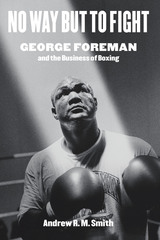 No Way but to Fight: George Foreman and the Business of Boxing
By Andrew R. M. Smith
University of Texas Press, 2020 Olympic gold medalist. Two-time world heavyweight champion. Hall of Famer. Infomercial and reality TV star. George Foreman’s fighting ability is matched only by his acumen for selling. Yet the complete story of Foreman’s rise from urban poverty to global celebrity has never been told until now. Raised in Houston’s “Bloody Fifth” Ward, battling against scarcity in housing and food, young Foreman fought sometimes for survival and other times just for fun. But when a government program rescued him from poverty and introduced him to the sport of boxing, his life changed forever. In No Way but to Fight, Andrew R. M. Smith traces Foreman’s life and career from the Great Migration to the Great Society, through the Cold War and culture wars, out of urban Houston and onto the world stage where he discovered that fame brought new challenges. Drawing on new interviews with George Foreman and declassified government documents, as well as more than fifty domestic and international newspapers and magazines, Smith brings to life the exhilarating story of a true American icon. No Way but to Fight is an epic worthy of a champion.
 No Way Home: The Decline of the World's Great Animal Migrations
David S. Wilcove
Island Press, 2010 Animal migration is a magnificent sight: a mile-long blanket of cranes rising from a Nebraska river and filling the sky; hundreds of thousands of wildebeests marching across the Serengeti; a blaze of orange as millions of monarch butterflies spread their wings to take flight. Nature’s great migrations have captivated countless spectators, none more so than premier ecologist David S. Wilcove. In No Way Home, his awe is palpable—as are the growing threats to migratory animals.
We may be witnessing a dying phenomenon among many species. Migration has always been arduous, but today’s travelers face unprecedented dangers. Skyscrapers and cell towers lure birds and bats to untimely deaths, fences and farms block herds of antelope, salmon are caught en route between ocean and river, breeding and wintering grounds are paved over or plowed, and global warming disrupts the synchronized schedules of predators and prey. The result is a dramatic decline in the number of migrants.
Wilcove guides us on their treacherous journeys, describing the barriers to migration and exploring what compels animals to keep on trekking. He also brings to life the adventures of scientists who study migrants. Often as bold as their subjects, researchers speed wildly along deserted roads to track birds soaring overhead, explore glaciers in search of frozen locusts, and outfit dragonflies with transmitters weighing less than one one-hundredth of an ounce.
Scientific discoveries and advanced technologies are helping us to understand migrations better, but alone, they won’t stop sea turtles and songbirds from going the way of the bison or passenger pigeon. What’s required is the commitment and cooperation of the far-flung countries migrants cross—long before extinction is a threat. As Wilcove writes, “protecting the abundance of migration is key to protecting the glory of migration.” No Way Home offers powerful inspiration to preserve those glorious journeys.
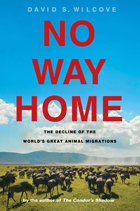 No Way Home: The Decline of the World's Great Animal Migrations
David S. Wilcove
Island Press, 2008 Animal migration is a magnificent sight: a mile-long blanket of cranes rising from a Nebraska river and filling the sky; hundreds of thousands of wildebeests marching across the Serengeti; a blaze of orange as millions of monarch butterflies spread their wings to take flight. Nature’s great migrations have captivated countless spectators, none more so than premier ecologist David S. Wilcove. In No Way Home, his awe is palpable—as are the growing threats to migratory animals.
We may be witnessing a dying phenomenon among many species. Migration has always been arduous, but today’s travelers face unprecedented dangers. Skyscrapers and cell towers lure birds and bats to untimely deaths, fences and farms block herds of antelope, salmon are caught en route between ocean and river, breeding and wintering grounds are paved over or plowed, and global warming disrupts the synchronized schedules of predators and prey. The result is a dramatic decline in the number of migrants.
Wilcove guides us on their treacherous journeys, describing the barriers to migration and exploring what compels animals to keep on trekking. He also brings to life the adventures of scientists who study migrants. Often as bold as their subjects, researchers speed wildly along deserted roads to track birds soaring overhead, explore glaciers in search of frozen locusts, and outfit dragonflies with transmitters weighing less than one one-hundredth of an ounce.
Scientific discoveries and advanced technologies are helping us to understand migrations better, but alone, they won’t stop sea turtles and songbirds from going the way of the bison or passenger pigeon. What’s required is the commitment and cooperation of the far-flung countries migrants cross—long before extinction is a threat. As Wilcove writes, “protecting the abundance of migration is key to protecting the glory of migration.” No Way Home offers powerful inspiration to preserve those glorious journeys.
No Way Out but Through
Lynne Sharon Schwartz
University of Pittsburgh Press, 2017 “One marvels at the force of seeing in Schwartz’s No Way Out But Through and cannot help but feel a particular gratitude for her abundant humor. Go all in with these poems; you'll reap unknown rewards. She possesses a quick-witted imagination that sanctifies memories and makes room for the wondrous nature of our cosmopolitan lights.”
—Major Jackson
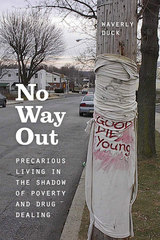 No Way Out: Precarious Living in the Shadow of Poverty and Drug Dealing
Waverly Duck
University of Chicago Press, 2015 In 2005 Waverly Duck was called to a town he calls Bristol Hill to serve as an expert witness in the sentencing of drug dealer Jonathan Wilson. Convicted as an accessory to the murder of a federal witness and that of a fellow drug dealer, Jonathan faced the death penalty, and Duck was there to provide evidence that the environment in which Jonathan had grown up mitigated the seriousness of his alleged crimes. Duck’s exploration led him to Jonathan’s church, his elementary, middle, and high schools, the juvenile facility where he had previously been incarcerated, his family and friends, other drug dealers, and residents who knew him or knew of him. After extensive ethnographic observations, Duck found himself seriously troubled and uncertain: Are Jonathan and others like him a danger to society? Or is it the converse—is society a danger to them?
Duck’s short stay in Bristol Hill quickly transformed into a long-term study—one that forms the core of No Way Out. This landmark book challenges the common misconception of urban ghettoes as chaotic places where drug dealing, street crime, and random violence make daily life dangerous for their residents. Through close observations of daily life in these neighborhoods, Duck shows how the prevailing social order ensures that residents can go about their lives in relative safety, despite the risks that are embedded in living amid the drug trade. In a neighborhood plagued by failing schools, chronic unemployment, punitive law enforcement, and high rates of incarceration, residents are knit together by long-term ties of kinship and friendship, and they base their actions on a profound sense of community fairness and accountability. Duck presents powerful case studies of individuals whose difficulties flow not from their values, or a lack thereof, but rather from the multiple obstacles they encounter on a daily basis.
No Way Out explores how ordinary people make sense of their lives within severe constraints and how they choose among unrewarding prospects, rather than freely acting upon their own values. What emerges is an important and revelatory new perspective on the culture of the urban poor.
No Way to Run an Economy: Why the System Failed and How to Put It Right
Graham Turner
Pluto Press, 2009 In The Credit Crunch, Graham Turner predicted that banks would be nationalised and interest rates would be reduced too slowly to halt the crisis. His predictions were correct. His new book, No Way to Run an Economy, is the essential guide to the turbulent times ahead.
Turner recommended radical measures, such as quantitative easing, in early 2008 but argues that action has been taken too late and been too timid to make a real difference. He dissects the policy mistakes of the last 12 months including Obama's doomed market-led response to the crisis and the obsession of central banks with the red herring of inflation.
There is no doubt the economy is still in serious trouble, but Turner shows that learning from the mistakes made so far can prevent a situation worse than that of the 1930s crisis.
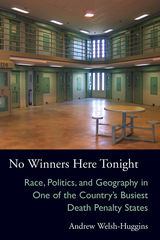 No Winners Here Tonight: Race, Politics, and Geography in One of the Country’s Busiest Death Penalty States
Andrew Welsh-Huggins
Ohio University Press, 2009 Few subjects are as intensely debated in the United States as the death penalty. Some form of capital punishment has existed in America for hundreds of years, yet the justification for carrying out the ultimate sentence is a continuing source of controversy. No Winners Here Tonight explores the history of the death penalty and the question of its fairness through the experience of a single state, Ohio, which, despite its moderate midwestern values, has long had one of the country’s most active death chambers. In 1958, just four states accounted for half of the forty-eight executions carried out nationwide, each with six: California, Georgia, Ohio, and Texas. By the first decade of the new century, Ohio was second only to Texas in the number of people put to death each year. No Winners Here Tonight looks at this trend and determines that capital punishment has been carried out in an uneven fashion from its earliest days, with outcomes based not on blind justice but on the color of a person’s skin, the whim of a local prosecutor, or the biases of the jury pool in the county in which a crime was committed. Andrew Welsh-Huggins’s work is the only comprehensive study of the history of the death penalty in Ohio. His analysis concludes that the current law, crafted by lawmakers to punish the worst of the state’s killers, doesn’t come close to its intended purpose and instead varies widely in its implementation. Welsh-Huggins takes on this controversial topic evenhandedly and with respect for the humanity of the accused and the victim alike. This exploration of the law of capital punishment and its application will appeal to students of criminal justice as well as those with an interest in law and public policy.
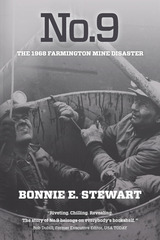 No.9: The 1968 Farmington Mine Disaster
Bonnie E. Stewart
West Virginia University Press, 2011 Ninety-nine men entered the cold, dark tunnels of the Consolidation Coal Company’s No.9 Mine in Farmington, West Virginia, on November 20, 1968. Some were worried about the condition of the mine. It had too much coal dust, too much methane gas. They knew that either one could cause an explosion. What they did not know was that someone had intentionally disabled a safety alarm on one of the mine’s ventilation fans. That was a death sentence for most of the crew. The fan failed that morning, but the alarm did not sound. The lack of fresh air allowed methane gas to build up in the tunnels. A few moments before 5:30 a.m., the No.9 blew up. Some men died where they stood. Others lived but suffocated in the toxic fumes that filled the mine. Only 21 men escaped from the mountain. No.9: The 1968 Farmington Mine Disaster explains how such a thing could happen—how the coal company and federal and state officials failed to protect the 78 men who died in the mountain. Based on public records and interviews with those who worked in the mine, No.9 describes the conditions underground before and after the disaster and the legal struggles of the miners’ widows to gain justice and transform coal mine safety legislation.
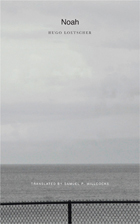 Noah: A Novel of the Boom Times
Hugo Loetscher
Seagull Books, 2012 As the current global recession stubbornly persists and financial experts around the world struggle to prevent further financial collapse, everyone has a theory about how to save the economy. But perhaps no idea that has been proffered is as radical or as unique as what Hugo Loetscher imagines in his novel Noah. In this book, first published in German in 1967, the eponymous Old Testament hero fuels his local economy with a prescient plan to build the Ark. Though no one around him seriously believes in the coming flood, everyone is more than willing to do business with him: “The people of Mesopotamia had never had it so good. There had been an economic miracle.” It is boom time in Mesopotamia, and the economy is flourishing; but as with many financial bubbles, scandal and demise are not far out of sight. An ancient legend retold in light of capitalist reality, Noah is a witty, delightful and thought-provoking parable of our times. Hugo Loetscher (1929–2009), widely known as the most cosmopolitan of Swiss writers due to his travels and journalistic work in Latin America and Asia, has until now been known mainly by readers in his home country, where he has been the recipient of its most prestigious literary prize. This attentive and engaging translation makes available to a new audience an incredibly timely and entertaining work.
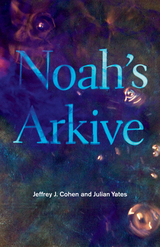 Noah's Arkive
Jeffrey J. Cohen
University of Minnesota Press, 2023 A timely rethinking of the archetypal story of Noah, the great flood, and who was left behind as the waters rose
Most people know the story of Noah from a children’s bible or a play set with a colorful ship, bearded Noah, pairs of animals, and an uncomplicated vision of survival. Noah’s ark, however, will forever be haunted by what it leaves to the rising waters so that the world can begin again. In Noah’s Arkive, Jeffrey J. Cohen and Julian Yates examine the long history of imagining endurance against climate catastrophe—as well as alternative ways of creating refuge. They trace how the elements of the flood narrative were elaborated in medieval and early modern art, text, and music, and now shape writing and thinking during the current age of anthropogenic climate change. Arguing that the biblical ark may well be the worst possible exemplar of human behavior, the chapters draw on a range of sources, from the Epic of Gilgamesh and Ovid’s tale of Deucalion and Pyrrah, to speculative fiction, climate fiction, and stories and art dwelling with environmental catastrophe. Noah’s Arkive uncovers the startling afterlife of the Genesis narrative written from the perspective of Noah’s wife and family, the animals on the ark, and those excluded and so left behind to die. This book of recovered stories speaks eloquently to the ethical and political burdens of living through the Anthropocene. Following a climate change narrative across the millennia, Noah’s Arkive surveys the long history of dwelling with the consequences of choosing only a few to survive in order to start the world over. It is an intriguing meditation on how the story of the ark can frame how we think about environmental catastrophe and refuge, conservation and exclusion, offering hope for a better future by heeding what we know from the past.
Nobel Genius: Prizes, Prestige and Scientific Practice
Nils Hansson
Leiden University Press, 2024 Awards shape careers, make research visible, and create role models. They provide evidence of prestige and credit and play a key role in evaluating individual scientists. Nevertheless, the understanding of prize cultures in science has remained surprisingly superficial. This book explores the prize cultures of the most famous scientific award worldwide: the Nobel Prize. It contributes to modern approaches in history and sociology of science that focus on the social context of scientific practices and gives new insights into the role of status and impact in academia.
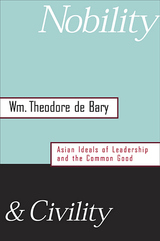 Nobility and Civility: Asian Ideals of Leadership and the Common Good
Wm. Theodore de Bary
Harvard University Press, 2004 Globalization has become an inescapable fact of contemporary life. Some leaders, in both the East and the West, believe that human rights are culture-bound and that liberal democracy is essentially Western, inapplicable to the non-Western world. How can civilized life be preserved and issues of human rights and civil society be addressed if the material forces dominating world affairs are allowed to run blindly, uncontrolled by any cross-cultural consensus on how human values can be given effective expression and direction?
In a thoughtful meditation ranging widely over several civilizations and historical eras, Wm. Theodore de Bary argues that the concepts of leadership and public morality in the major Asian traditions offer a valuable perspective on humanizing the globalization process. Turning to the classic ideals of the Buddhist, Hindu, Confucian, and Japanese traditions, he investigates the nature of true leadership and its relation to learning, virtue, and education in human governance; the role in society of the public intellectual; and the responsibilities of those in power in creating and maintaining civil society.
De Bary recognizes that throughout history ideals have always come up against messy human complications. Still, he finds in the exploration and affirmation of common values a worthy attempt to grapple with persistent human dilemmas across the globe.
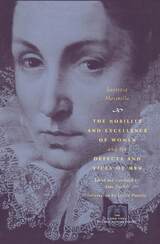 The Nobility and Excellence of Women and the Defects and Vices of Men
Lucrezia Marinella
University of Chicago Press, 1999 A gifted poet, a women's rights activist, and an expert on moral and natural philosophy, Lucrezia Marinella (1571-1653) was known throughout Italy as the leading female intellectual of her age. Born into a family of Venetian physicians, she was encouraged to study, and, fortunately, she did not share the fate of many of her female contemporaries, who were forced to join convents or were pressured to marry early. Marinella enjoyed a long literary career, writing mainly religious, epic, and pastoral poetry, and biographies of famous women in both verse and prose.
Marinella's masterpiece, The Nobility and Excellence of Women, and the Defects and Vices of Men was first published in 1600, composed at a furious pace in answer to Giusepe Passi's diatribe about women's alleged defects. This polemic displays Marinella's vast knowledge of the Italian poetic tradition and demonstrates her ability to argue against authors of the misogynist tradition from Boccaccio to Torquato Tasso. Trying to effect real social change, Marinella argued that morally, intellectually, and in many other ways, women are superior to men.
Nobility and Privilege in Late Imperial Russia
Seymour Becker
Northern Illinois University Press, 1985
The transformation of the Russian nobility between 1861 and 1914 has often been attributed to the anachronistic attitudes of its members and their failure to adapt to social change. Becker challenges this idea of "the decline of the nobility." He argues that the privileged estate responded positively to change and greatly influenced their nation's political and economic destiny.
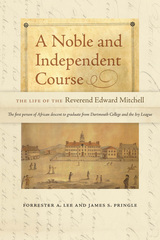 A Noble and Independent Course: The Life of the Reverend Edward Mitchell
Forrester A. Lee and James S. Pringle
Dartmouth College Press, 2018 In 1828 Edward Mitchell was the first student of African descent to graduate from Dartmouth College, more than thirty-five years before any other Ivy League school admitted a black student. This book tells Mitchell’s life story with the help of a recently rediscovered trove of his college essays, notes on his religious conversion, and hand-copied versions of his sermons. Born and raised in the French slave colony of Martinique, Mitchell immigrated to the United States and came of age in Philadelphia, where he broke bread with the city’s African American clerics and civic leaders. The Dartmouth trustees initially denied Mitchell admission but yielded to unified student protest. After his graduation, Mitchell continued his northward journey to serve as a Baptist preacher and evangelist in the pulpits of northern New England. His religious odyssey concluded in Lower Canada, where he was remembered as “the most profound theologian ever settled.” During his travels throughout the Atlantic world in an age of revolution and religious revival, Mitchell encountered the dominant social, economic, and political realities of his time. Although long celebrated as the inspiration for Dartmouth’s legacy of educating men and women of African ancestry, Mitchell’s life story remained unknown for almost two centuries. This book, which embodies history as recovery, is a testament to the authors’ desire to know the man behind the story.
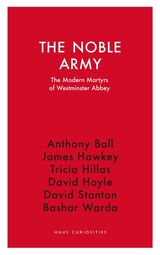 The Noble Army: The Modern Martyrs of Westminster Abbey
Edited by James Hawkey
Haus Publishing, 2024 The narratives of the figures behind the ten statues of martyrs at the Westminster Abbey.
In July 1998, ten statues of martyrs of the twentieth century were unveiled surmounting the Great West Door of Westminster Abbey. Ten figures were identified from different continents and different churches: victims of Nazi and Bolshevik oppression, state-sponsored violence, and religious hatred, these images stand as a testimony to the bloodshed of the twentieth century. Some, such as Oscar Romero and Martin Luther King, are famed across the world. Others are less known.
The Noble Army offers reflections on each of these ten lives, explores the questions surrounding their choices, and tells us the stories behind them. These statues were intended to represent those millions of individuals who suffered for their faith in Christ in the twentieth century. These reflections culminate in a chapter on the contemporary reality of Christian marginalization and persecution, written by Archbishop Bashar Warda of Erbil, Iraq.
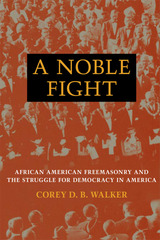 A Noble Fight: African American Freemasonry and the Struggle for Democracy in America
Corey D. B. Walker
University of Illinois Press, 2008 A Noble Fight examines the metaphors and meanings behind the African American appropriation of the culture, ritual, and institution of freemasonry in navigating the contested terrain of American democracy. Combining cultural and political theory with extensive archival research--including the discovery of a rare collection of nineteenth-century records of an African American Freemason Lodge--Corey D. B. Walker provides an innovative perspective on American politics and society during the long transition from slavery to freedom. With great care and detail, Walker argues that African American freemasonry provides a critical theoretical lens for understanding the distinctive ways African Americans have constructed a radically democratic political imaginary through racial solidarity and political nationalism, forcing us to reconsider much more circumspectly the complex relationship between voluntary associations and democratic politics. Mapping the discursive logics of the language of freemasonry as a metaphoric rendering of American democracy, this study interrogates the concrete forms of an associational culture, revealing how paradoxical aspects of freemasonry such as secrecy and public association inform the production of particular ideas and expressions of democracy in America.
 Noble Nationalists: The Transformation of the Bohemian Aristocracy
Eagle Glassheim
Harvard University Press, 2005 This illuminating study examines the dramatic transformation of Bohemian noble identity from the rise of mass politics in the late nineteenth century to the descent of the Iron Curtain after World War II.
At the turn of the twentieth century, some 300 noble families owned over a third of the Habsburg Bohemian Crownlands. With the Empire's demise in 1918, the once powerful Bohemian nobility quickly became a target of the nationalist revolution sweeping the new Czechoslovak state. Eagle Glassheim traces the evolving efforts of the nobles to define their place in this revolutionary new order.
Nobles saw little choice but to ally with Czech and German national parties, initially in the hopes of assuaging radical land reform. Yet they retained aristocratic political and social traditions that continued to shape their national identities after 1918. Some moved toward a hybrid national identification, embracing a form of German internationalism and a vision of pan-European unity that led many to support Hitler's expansionist efforts in the late 1930s. Others trumpeted their new-found Czech nationalism in resisting the Nazi occupation.
Noble Nationalists offers valuable insights on the nationalization of a conservative political elite, as well as on the national and social revolutions that recast Central Europe in the first half of the twentieth century.
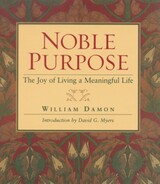 Noble Purpose: Joy Of Living A Meaningful Life
William Bill Damon
Templeton Press, 2003 This book describes the personal and spiritual benefits of living life in a way that matters, with an awareness that one's life can reflect a sense of higher purpose no matter what the circumstances. The book draws upon religious, philosophical, and literary writings to show how humans in many cultures and historical epochs have pursued noble purposes by answering God's call as each hears it. Noble purpose can be pursued both in heroic acts and in everyday behavior. The book shows how ordinary people—teachers, business professionals, parents, citizens—can ennoble what they do by being mindful of its deepest meaning. It also points out that humility is a necessary virtue for those who pursue a noble purpose. Great heroes are bold, courageous, and sometimes audacious in their determination to succeed; but they are also humble in their awareness of their own limitations. Moreover, a person must never violate basic moral laws while pursuing a noble purpose—the means must be as moral as the ends. Purpose brings coherence and satisfaction to people's lives, producing joy in good times and resilience in hard times. It also presents a paradox: hard work in service of noble purpose that transcends personal gain is a surer path to happiness than the self-indulgent pursuit of happiness for its own sake. The closer we come to God's purpose for us, the more satisfied our lives become. From the inspiration and examples conveyed in this book, we learn that all individuals have the capacity to discover their own God-given abilities, to learn the world's need for the services they can provide, and to experience joy in serving society and God in their special ways. As theologian Frederick Buechner writes, "The place God calls you to is the place where your deep gladness and the world's deep hunger meet."
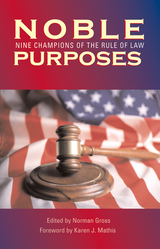 Noble Purposes: Nine Champions of the Rule of Law
Norman Gross
Ohio University Press, 2007 Throughout the history of the United States, the acts of a few have proved to be turning points in the way our legal system has treated the least of us. The nine individuals whose deeds are recounted here have compelling stories, and though they remain unknown to the general public, their commitment to the rule of law has had a lasting impact on our nation. Noble Purposes brings their stories to life. It describes the contributions of such individuals as James Alexander, the guiding and central force in the colonial-era trial of John Peter Zenger, which sowed the seeds for the American Revolution and the constitutional guarantee of a free press. In the 1870s, Hugh Lennox Bond stared down threats as judge in the trials of the South Carolina Ku Klux Klan, while Clara Shortridge Foltz overcame tremendous resistance during her fifty-year law practice, which included advocacy of public defender offices. Early last century, Louis Marshall paved the way for the rights of minorities in America and abroad, while Francis Biddle, FDR’s attorney general, sought to maintain civil liberties during World War II, arguing against the internment of Japanese Americans and later serving as the American judge in the Nuremberg trials. Edited by legal scholar Norman Gross and written by leading legal historians from around the country, the profiles presented in Noble Purposes tell the stories of these and other individuals who stood firmly in support of the rule of law, often against great odds.
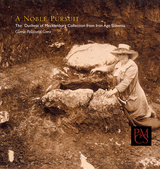 A Noble Pursuit: The Duchess of Mecklenburg Collection from Iron Age Slovenia
Gloria Polizzotti Greis
Harvard University Press, 2006 In 1905, to the consternation of her family and in defiance of convention, the 48-year-old Duchess Paul Friedrich of Mecklenburg took up the practice of archaeology. In the nine years leading up to the First World War, she successfully excavated twenty-one sites in her home province of Carniola (modern Slovenia), acquiring the patronage of Austro-Hungarian Emperor Franz Josef I and German Kaiser Wilhelm II. Mentored by the most important archaeologists of her time—Oscar Montelius and Josef Dechellette—the Duchess became an accomplished fieldworker and an important figure in the archaeology of Central Europe. Gloria Greis incorporates previously unpublished correspondence and other archival documents in this colorful account of the Duchess of Mecklenburg and her work.
The Mecklenburg Collection, the largest systematically excavated collection of European antiquities outside of Europe, resides in Harvard’s Peabody Museum of Archaeology and Ethnology. The sites excavated by the Duchess, which encompass the scope of Iron Age cultures in Slovenia, form an important resource for studying the cultural history of the region. A Noble Pursuit presents a selection of beautifully photographed artifacts that provide an overview of the scope and importance of the collection as a whole and attest to the enduring quality of the Duchess’s pioneering work.
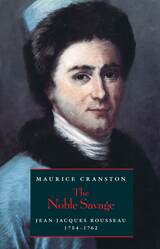 The Noble Savage: Jean-Jacques Rousseau, 1754-1762
Maurice Cranston
University of Chicago Press, 1991 In this second volume of the unparalleled exposition of Rousseau's life and works, Cranston completes and corrects the story told in Rousseau's Confessions, and offers a vivid, entirely new history of his most eventful and productive years.
"Luckily for us, Maurice Cranston's The Noble Savage: Jean-Jacques Rousseau, 1754-1762 has managed to craft a highly detailed account of eight key years of Rousseau's life in such a way that we can both understand and even, on occasion, sympathize."—Olivier Bernier, Wall Street Journal
Maurice Cranston (1920-1993), a distinguished scholar and recipient of the James Tait Black Memorial Prize for his biography of John Locke, was professor of political science at the London School of Economics. His numerous books include The Romantic Movement and Philosophers and Pamphleteers, and translations of Rousseau's The Social Contract and Discourse on the Origins of Inequality.
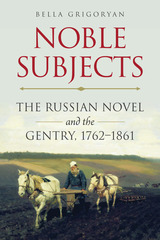 Noble Subjects: The Russian Novel and the Gentry, 1762–1861
Bella Grigoryan
Northern Illinois University Press, 2018 Relations between the Russian nobility and the state underwent a dynamic transformation during the roughly one hundred-year period encompassing the reign of Catherine II (1762–1796) and ending with the Great Reforms initiated by Alexander II. This period also saw the gradual appearance, by the early decades of the nineteenth century, of a novelistic tradition that depicted the Russian society of its day. In Noble Subjects, Bella Grigoryan examines the rise of the Russian novel in relation to the political, legal, and social definitions that accrued to the nobility as an estate, urging readers to rethink the cultural and political origins of the genre.
By examining works by Novikov, Karamzin, Pushkin, Bulgarin, Gogol, Goncharov, Aksakov, and Tolstoy alongside a selection of extra-literary sources (including mainstream periodicals, farming treatises, and domestic and conduct manuals), Grigoryan establishes links between the rise of the Russian novel and a broad-ranging interest in the figure of the male landowner in Russian public discourse. Noble Subjects traces the routes by which the rhetorical construction of the male landowner as an imperial subject and citizen produced a contested site of political, socio-cultural, and affective investment in the Russian cultural imagination. This interdisciplinary study reveals how the Russian novel developed, in part, as a carrier of a masculine domestic ideology. It will appeal to scholars and students of Russian history and literature.
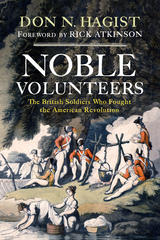 Noble Volunteers: The British Soldiers Who Fought the American Revolution
Don N. Hagist
Westholme Publishing, 2025 Advisor for Ken Burns The American Revolution on PBS®
Winner of the 2020 American Revolution Roundtable of Philadelphia Book of the Year
Redcoats. For Americans, the word brings to mind the occupying army that attempted to crush the Revolutionary War. There was more to these soldiers than their red uniforms, but the individuals who formed the ranks are seldom described in any detail in historical literature, leaving unanswered questions. Who were these men? Why did they join the army? Where did they go when the war was over?
In Noble Volunteers: The British Soldiers Who Fought the American Revolution, Don N. Hagist brings life to these soldiers, describing the training, experiences, and outcomes of British soldiers who fought during the Revolution. Drawing on thousands of military records and other primary sources in British, American, and Canadian archives, and the writings of dozens of officers and soldiers, Noble Volunteers shows how a peacetime army responded to the onset of war, how professional soldiers adapted quickly and effectively to become tactically dominant, and what became of the thousands of career soldiers once the war was over.
In this historical tour de force, introduced by Pulitzer Prize winner Rick Atkinson, Hagist dispels long-held myths, revealing how remarkably diverse British soldiers were. They represented a variety of ages, nationalities, and socioeconomic backgrounds, and many had joined the army as a peacetime career, only to find themselves fighting a war on another continent in often brutal conditions. Against the sweeping backdrop of the war, Hagist directs his focus on the small picture, illuminating the moments in an individual soldier’s life—those hours spent nursing a fever while standing sentry in the bitter cold, or writing a letter to a wife back home. What emerges from these vignettes is the understanding that while these were “common” soldiers, each soldier was completely unique, for, as Hagist writes, “There was no ‘typical’ British soldier.”
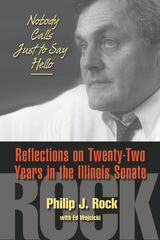 Nobody Calls Just to Say Hello: Reflections on Twenty-Two Years in the Illinois Senate
Philip J. Rock, with Ed Wojcicki
Southern Illinois University Press, 2011 A loyal partisan and highly principled public official whose career overlapped with those of many legends of Illinois politics-including Mayor Richard J. Daley, Governor James Thompson, and Illinois House Speaker Michael Madigan-Democrat Philip J. Rock served twenty-two years in the Illinois Senate. Fourteen of those years were spent as senate president, the longest tenure anyone has served in that position. This nuanced political biography, which draws on dozens of interviews conducted by Ed Wojcicki to present the longtime senate president's story in his own words, is also a rare insider's perspective on Illinois politics in the last three decades of the twentieth century.
A native of Chicago's West Side, Rock became one of the most influential politicians in Illinois during the 1970s and 1980s. As a senator in the 1970s and senate president from 1979 to 1993, he sponsored historic legislation to assist abused and neglected children and victims of domestic violence, ushered the state through difficult income tax increases and economic development decisions, shepherded an unruly and fragmented Democratic senate caucus, and always was fair to his Republican counterparts. Covering in great detail a critical period in Illinois political history for the first time, Rock explains how making life better for others drove his decisions in office, while also espousing the seven principles he advocates for effective leadership and providing context for how he applied those principles to the legislative battles of the era.
Unlike many Illinois politicians, Rock, a former seminarian, was known for having a greater interest in issues than in partisan politics. Considered a true statesman, he also was known as a skilled orator who could silence a busy floor of legislators with his commentary on important issues and as a devoted public servant who handled tens of thousands of bills and sponsored nearly five hundred of them himself.
Nobody Calls Just to Say Hello, which takes its title from the volume of calls and visits to elected officials from constituents in need of help, perfectly captures Rock's profound reverence for the institutions of government, his respect for other government offices, and his reputation as a problem solver who, despite his ardent Democratic beliefs, disavowed political self-preservation to cross party lines and make government work for the people. Taking readers through his legislative successes, bipartisan efforts, and political defeats-including a heartbreaking loss in the U.S. Senate primary to Paul Simon in 1984-Rock passionately articulates his belief that government's primary role is to help people, offering an antidote to the current political climate with the simple legislative advice, "Just try to be fair, give everyone a chance, and everything else comes after that."
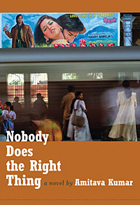 Nobody Does the Right Thing: A Novel
Amitava Kumar
Duke University Press, 2010 A young poet is killed by her lover, a politician, in the eastern Indian state of Bihar. Soon afterward, across India in Bombay, an idealistic journalist is hired by a movie director to write a Bollywood screenplay about the murdered poet. Research for the script takes the writer, Binod, back to Bihar, where he and his cousin Rabinder were raised. While the high-minded Binod struggles to turn the poet’s murder into a steamy tale about small towns, desire, and intrigue, Rabinder sits in a Bihari jail cell, having been arrested for distributing pornography through a cybercafé. Rabinder dreams of a career in Bollywood filmmaking, and, unlike his cousin, he is not burdened by ethical scruples. Nobody Does the Right Thing is the story of these two cousins and the ways that their lives unexpectedly intertwine. Set in the rural villages of Bihar and the metropolises of Bombay and Delhi, the novel is packed with telling details and anecdotes about life in contemporary India. At the same time, it is a fictional investigation into how narratives circulate and vie for supremacy through gossip, cinema, popular fiction, sensational journalism, and the global media.
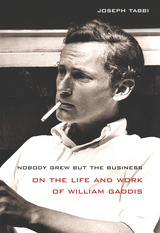 Nobody Grew but the Business: On the Life and Work of William Gaddis
Joseph Tabbi
Northwestern University Press, 2015 Finalist, 2016 Society for Midland Authors Award for Biography & Memoir During his lifetime, William Gaddis (1922–1998) evaded biographical questions, never read from his work publicly, and didn’t allow his photograph to appear on his books. Before his novel J R (1975) won Gaddis the National Book Award and some measure of renown, he had given up the bohemian world of 1950s Greenwich Village for a series of corporate jobs that both paid the bills and provided an inside view of the encroachment of market values into every corner of American culture. By illustrating the interconnectedness of Gaddis’s life and work, Tabbi, among his foremost interpreters, demystifies the “difficult author” and shows a writer who was as attuned as any to the way Americans talk, and who sensitively chronicled the gradual commodification of artistic endeavor. Illuminating, heartbreaking, and masterful, Tabbi’s book gives us the most subtly drawn portrait to date of one of the twentieth century’s seminal novelists.
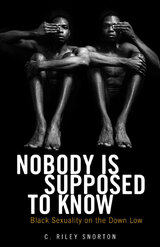 Nobody Is Supposed to Know: Black Sexuality on the Down Low
C. Riley Snorton
University of Minnesota Press, 2014
Since the early 2000s, the phenomenon of the “down low”—black men who have sex with men as well as women and do not identify as gay, queer, or bisexual—has exploded in news media and popular culture, from the Oprah Winfrey Show to R & B singer R. Kelly’s hip hopera Trapped in the Closet. Most down-low stories are morality tales in which black men are either predators who risk infecting their unsuspecting female partners with HIV or victims of a pathological black culture that repudiates openly gay identities. In both cases, down-low narratives depict black men as sexually dangerous, duplicitous, promiscuous, and contaminated.
In Nobody Is Supposed to Know, C. Riley Snorton traces the emergence and circulation of the down low in contemporary media and popular culture to show how these portrayals reinforce troubling perceptions of black sexuality. Reworking Eve Sedgwick’s notion of the “glass closet,” Snorton advances a new theory of such representations in which black sexuality is marked by hypervisibility and confinement, spectacle and speculation. Through close readings of news, music, movies, television, and gossip blogs, Nobody Is Supposed to Know explores the contemporary genealogy, meaning, and functions of the down low. Snorton examines how the down low links blackness and queerness in the popular imagination and how the down low is just one example of how media and popular culture surveil and police black sexuality. Looking at figures such as Ma Rainey, Bishop Eddie L. Long, J. L. King, and Will Smith, he ultimately contends that down-low narratives reveal the limits of current understandings of black sexuality.
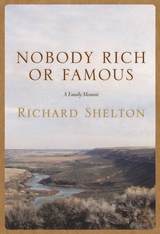 Nobody Rich or Famous: A Family Memoir
Richard Shelton
University of Arizona Press, 2016 Once in a while, a book comes along that redefines the concept of family. Frank McCourt did it with Angela’s Ashes; Annie Dillard did it with An American Childhood. In Nobody Rich or Famous, author Richard Shelton (b. 1933) immerses us in the hardscrabble lives of his Boise, Idaho, clan during the 1930s and ’40s. Using a framework of journals, road trips, and artful storytelling, Shelton traces three generations of women. We meet his mother, Hazel, a model of western respectability, who carefully dresses in her finest clothes before walking into a bar and emptying a loaded handgun in the general direction of her husband. We meet his great-grandmother, Josephine, who homesteads a sod shanty and dies too young on the Kansas prairie. We follow his grandmother, Charlotte, as she grows from a live-in servant girl to a fiddle-playing schoolteacher who burns through two marriages before taking up with the iceman.
Known for his storytelling, Shelton crafts a tale of poverty and its attendant sorrows: alcoholism, neglect, and abuse. But the tenacity of the human spirit shines through. This is an epic tale of Steinbeckian proportions, but it is not fiction. This is memoir in its finest tradition, illuminating today’s cultural chasm between the haves and have-nots. In the author’s words, Nobody Rich or Famous is “the story of a family and how it got that way.”
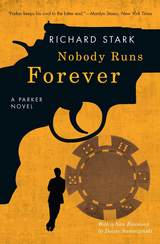 Nobody Runs Forever: A Parker Novel
Richard Stark
University of Chicago Press, 2017 An action-packed crime novel starring Parker, the heister starring in the forthcoming Shane Black film Play Dirty!
Richard Stark's Parker novels are the hardest of hard-boiled, classic crime novels where the heists are huge, the body counts are high, and the bad guys usually win.
The Parker novels have been a huge influence on countless writers and filmmakers, including Quentin Tarantino, Stephen King, George Pelecanos, Colson Whitehead, Lucy Sante, John Banville, and many more. Their stripped-down language and hard-as-nails amorality create an unforgettable world where the next score could be the big one, but your next mistake could also be your last. There's nothing else like them.
Nobody Runs Forever opens with a job at a poker game that sours into a necktie party. When Parker goes in on a messy scam—stealing an armored car—with someone he barely knows, as usual the amateurs get in the way of the job. From a nervous ex-con and his well-intentioned sister to a bank manager's two-timing wife and a beautiful, relentless cop, too many people have their hands too close to Parker's pie. Even when he sees the job turning bad, he can’t let go of the score—and there just might be nowhere left to run . . .
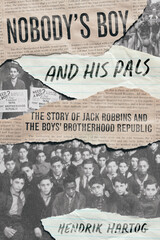 Nobody's Boy and His Pals: The Story of Jack Robbins and the Boys’ Brotherhood Republic
Hendrik Hartog
University of Chicago Press, 2024 An engaging account of social reformer Jack Robbins, the Boys’ Brotherhood Republic, and their legacy.
In 1914, social reformer Jack Robbins and a group of adolescent boys in Chicago founded the Boys’ Brotherhood Republic, an unconventional and unusual institution. During a moral panic about delinquent boys, Robbins did not seek to rehabilitate and/or punish wayward youths. Instead, the boys governed themselves, democratically and with compassion for one another, and lived by their mantra “So long as there are boys in trouble, we too are in trouble.” For nearly thirty years, Robbins was their “supervisor,” and the will he drafted in the late 1950s suggests that he continued to care about forgotten boys, even as the political and legal contexts that shaped children’s lives changed dramatically.
Nobody’s Boy and His Pals is a lively investigation that challenges our ideas about the history of American childhood and the law. Scouring the archives for traces of the elusive Jack Robbins, Hendrik Hartog examines the legal histories of Progressive reform, childhood, criminality, repression, and free speech. The curiosity of Robbins’s story is compounded by the legal challenges to his will, which wound up establishing the extent to which last wishes must conform to dominant social values. Filled with persistent mysteries and surprising connections, Nobody’s Boy and His Pals illuminates themes of childhood and adolescence, race and ethnicity, sexuality, wealth and poverty, and civil liberties, across the American Century.
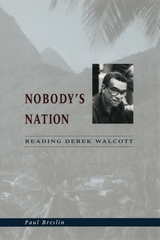 Nobody's Nation: Reading Derek Walcott
Paul Breslin
University of Chicago Press, 2001 Nobody's Nation offers an illuminating look at the St. Lucian, Nobel-Prize-winning writer, Derek Walcott, and grounds his work firmly in the context of West Indian history. Paul Breslin argues that Walcott's poems and plays are bound up with an effort to re-imagine West Indian society since its emergence from colonial rule, its ill-fated attempt at political unity, and its subsequent dispersal into tiny nation-states.
According to Breslin, Walcott's work is centrally concerned with the West Indies' imputed absence from history and lack of cohesive national identity or cultural tradition. Walcott sees this lack not as impoverishment but as an open space for creation. In his poems and plays, West Indian history becomes a realm of necessity, something to be confronted, contested, and remade through literature. What is most vexed and inspired in Walcott's work can be traced to this quixotic struggle.
Linking extensive archival research and new interviews with Walcott himself to detailed critical readings of major works, Nobody's Nation will take its place as the definitive study of the poet.
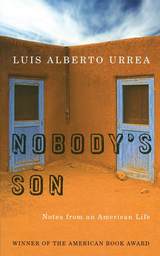 Nobody's Son: Notes from an American Life
Luis Alberto Urrea
University of Arizona Press, 1998 Here's a story about a family that comes from Tijuana and settles into the 'hood, hoping for the American Dream.
. . . I'm not saying it's our story. I'm not saying it isn't. It might be yours. "How do you tell a story that cannot be told?" writes Luis Alberto Urrea in this potent memoir of a childhood divided. Born in Tijuana to a Mexican father and an Anglo mother from Staten Island, Urrea moved to San Diego when he was three. His childhood was a mix of opposites, a clash of cultures and languages. In prose that seethes with energy and crackles with dark humor, Urrea tells a story that is both troubling and wildly entertaining. Urrea endured violence and fear in the black and Mexican barrio of his youth. But the true battlefield was inside his home, where his parents waged daily war over their son's ethnicity. "You are not a Mexican!" his mother once screamed at him. "Why can't you be called Louis instead of Luis?" He suffers disease and abuse and he learns brutal lessons about machismo. But there are gentler moments as well: a simple interlude with his father, sitting on the back of a bakery truck; witnessing the ultimate gesture of tenderness between the godparents who taught him the magical power of love. "I am nobody's son. I am everybody's brother," writes Urrea. His story is unique, but it is not unlike thousands of other stories being played out across the United States, stories of other Americans who have waged war—both in the political arena and in their own homes—to claim their own personal and cultural identity. It is a story of what it means to belong to a nation that is sometimes painfully multicultural, where even the language both separates and unites us. Brutally honest and deeply moving, Nobody's Son is a testament to the borders that divide us all.
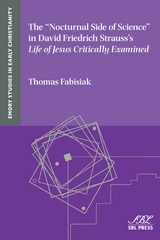 The Nocturnal Side of Science in David Friedrich Strauss's Life of Jesus Critically Examined
Thomas Fabisiak
SBL Press, 2015 A close look at how Strauss's engagement with popular and scholarly controversies influenced his study of the Gospels
David Friedrich Strauss's Life of Jesus Critically Examined is known as a monumental contribution to the critical, scientific study of religion and Christian origins. It was widely read and influenced literary and historical research on the Bible as well as critical philosophy between Hegel and Nietzsche. Less well-known are Strauss's writings from the same period on "the nocturnal side of nature," paranormal phenomena such as demon possession, animal magnetism, and the ghost-seeing of Frederike Hauffe, the famous "Seeress of Prevorst."
Features:
- Illuminates unfamiliar features of early nineteenth-century theology, philosophy, and medicine showing how spirituality and science blended together in these fields
- Demonstrates the importance of Western esotericism and popular religion in the history of modern biblical studies
- Sheds new light on Strauss’s study of the Gospels as myths, his critique of miracles and his account of the historical Jesus
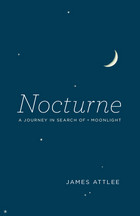 Nocturne: A Journey in Search of Moonlight
James Attlee
University of Chicago Press, 2011 “Nobody who has not taken one can imagine the beauty of a walk through Rome by full moon,” wrote Goethe in 1787. Sadly, the imagination is all we have today: in Rome, as in every other modern city, moonlight has been banished, replaced by the twenty-four-hour glow of streetlights in a world that never sleeps. Moonlight, for most of us, is no more.
So James Attlee set out to find it. Nocturne is the record of that journey, a traveler’s tale that takes readers on a dazzling nighttime trek that ranges across continents, from prehistory to the present, and through both the physical world and the realms of art and literature. Attlee attends a Buddhist full-moon ceremony in Japan, meets a moon jellyfish on a beach in Northern France, takes a moonlit hike in the Arizona desert, and experiences a lunar eclipse on New Year’s Eve atop the snowbound Welsh hills. Each locale is illuminated not just by the moonlight he seeks, but by the culture and history that define it. We learn about Mussolini’s pathological fear of moonlight; trace the connections between Caspar David Friedrich, Rudolf Hess, and the Apollo space mission; and meet the inventors of the Moonlight Collector in the American desert, who aim to cure all kinds of ailments with concentrated lunar rays. Svevo and Blake, Whistler and Hokusai, Li Po and Marinetti are all enlisted, as foils, friends, or fellow travelers, on Attlee’s journey.
Pulled by the moon like the tide, Attlee is firmly in a tradition of wandering pilgrims that stretches from Basho to Sebald; like them, he presents our familiar world anew.
Nocturne and Five Tales of Love and Death
Gabrielle D'Aunnunzio
Northwestern University Press, 1988 Nocturne and Five Tales of Love and Death is a book of prose by Gabrielle D’Annunzio translated from Italian to English by Raymond Rosenthal.
Nocturnes of the Brothel of Ruin
Patrick Donnelly
Four Way Books, 2012 Nocturnes of the Brothel of Ruin reflects on the ways love and sex can ruin us—our bodies, our contentment, our sense of self—but can also grant us an almost spiritual knowledge of the human. Structured around the life of a central speaker born into a world where love is a fever, a sickness, Donnelly’s masterful volume moves through deserted New England mill towns, the sexual abandon of the 1980s gay demimonde, and (in several translations) medieval imperial Japan, searching out the spirit that survives ruin.
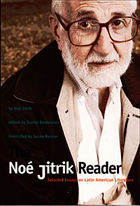 The Noé Jitrik Reader: Selected Essays on Latin American Literature
Noé Jitrik
Duke University Press, 2005 The Argentine scholar Noé Jitrik has long been one of the foremost literary critics in Latin America, noted not only for his groundbreaking scholarship but also for his wit. This volume is the first to make available in English a selection of his most influential writings. These sparkling translations of essays first published between 1969 and the late 1990s reveal the extraordinary scope of Jitrik’s work, his sharp insights into the interrelations between history and literature, and his keen awareness of the specificities of Latin American literature and its relationship to European writing. Together they signal the variety of critical approaches and vocabularies Jitrik has embraced over the course of his long career, including French structuralist thought, psychoanalysis, semiotics, and Marxism. The Noé Jitrik Reader showcases Jitrik’s reflections on marginality and the canon, exile and return, lack and excess, autobiography, Argentine nationalism, the state of literary criticism, the avant-garde, and the so-called Boom in Latin American literature. Among the writers whose work he analyzes in the essays collected here are Jorge Luis Borges, Esteban Echeverría, Domingo Faustino Sarmiento, José Martí, César Vallejo, José Bianco, Juan Carlos Onetti, José María Arguedas, Julio Cortázar, and Augusto Roa Bastos. The Noé Jitrik Reader offers English-language readers a unique opportunity to appreciate the rigor and thoughtfulness of one of Latin America’s most informed and persuasive literary critics.
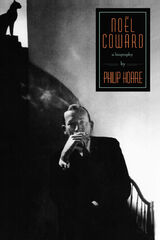 Noel Coward: A Biography
Philip Hoare
University of Chicago Press, 1998 To several generations, actor, playwright, songwriter, and filmmaker, Noël Coward (1899-1973) was the very personification of wit, glamour, and elegance. His biographer, Philip Hoare, given unprecedented access to the private papers and correspondence of Coward family members, compatriots, and numerous lovers, has produced the definitive biography of one of the twentieth century's most celebrated and controversial figures.
"Philip Hoare's careful research and lucid presentation in his Noël Coward: A Biography adds depth to the picture."-New York Times Book Review
"A fascinating, in-depth biography."—Library Journal
"Hoare has profiled vividly and in-depth a complex legend who had a talent for creating and recreating both himself and his works."—Publishers Weekly
"In the thicket of books about the life and work of Coward, Philip Hoare's stands out as the most well-documented and objective."—Los Angeles Times
"[Hoare's] book, like its subject, strives for effortless sophistication, and succeeds."—Newsday
"Hoare's retelling of Coward's story [is] the most vivid, insightful, and fascinating so far."—John Lahr, The New Yorker
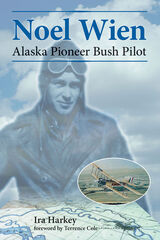 Noel Wien: Alaska Pioneer Bush Pilot
Ira Harkey
University of Alaska Press, 1999 From his days as one of Alaska's earliest bush pilots through the years spent developing Wien Air Alaska with his brothers, Noel Wien built up a long list of firsts: he was first to fly commercially from Fairbanks to Nome and from Fairbanks to Seattle, first to fly from Anchorage to Fairbanks, first to fly and land beyond the Arctic Circle, and first to make a round-trip flight between Alaska and Asia. Wien shared a vision to bring commercial aviation to the Far North, and he acted on it. He had 538 hours of barnstorming and aerial circus stunt flying behind him when he arrived in Alaska in 1924. At that time, Alaska's rugged terrain permitted little more than primitive means of communication and transportation. There were no air charts and no radio communication. Navigation depended solely on a pilot's use of natural features of checkpoints, but the innumerable rivers and mountains too easily could look identical. Safe landing sites were scarce. Wien embraced the challenge presented by these obstacles with courage tempered by his native caution - not to mention exceptional talent and a boundless love of flying. Before long, supplies could be taken to settlements previously serviced only by dog sled and sick persons could be transported quickly to hospitals. In this dramatic account of a flying hero, Pulitzer Prize winning author Ira Harkey describes Wien's experiences in an engaging style, and he establishes Wien's place in Alaska history. In the process, Harkey makes a valuable contribution towards an understanding of the Alaska of the recent past and the people who lived there. This commemorative edition marks the 75th anniversary of Noel Wien's arrival in Alaska as well as his pioneering flight between Anchorage and Fairbanks. It includes additional photographs and an informative new foreword by Cole. Noel Wien pursued his vision through decades of wild experiences in an unyielding land. His aviation milestones brought the people of Alaska closer and helped open Alaska to the outside world.
 Noir Anxiety
Kelly Oliver
University of Minnesota Press, 2002 Investigates the fears and desires about sexuality and racial identity that shape film noir. Among the elements that define the classic film noir-chiaroscuro lighting, voice-over narration, and such archetypal characters as the world-weary private eye and the femme fatale-perhaps no element is more responsible for the genre’s continued popularity among movie buffs, filmmakers, and critics than the palpable sense of anxiety that emanates from the screen. Because the genre emerged in the shadow of the Second World War, this profound psychological and philosophical unease is usually ascribed either to postwar fears about the atomic bomb or to the reactions of returning soldiers to a new social landscape. In Noir Anxiety, however, Kelly Oliver and Benigno Trigo interpret what has been called the "free-floating anxiety" of film noir as concrete apprehensions about race and sexuality. Applying feminist and postcolonial psychoanalytic theory to traditional noir films (Murder, My Sweet; The Lady from Shanghai; Vertigo; and Touch of Evil) and the "neo-noirs" of the 1970s, 1980s, and 1990s (Chinatown, Devil in a Blue Dress, and Bound), the authors uncover a rich array of unconscious worries and desires about ambiguous sexual, racial, and national identities, often displaced onto these films’ narrative and stylistic components. In particular, Oliver and Trigo focus on the looming absence of the mother figure within the genre and fears about maternal sexuality and miscegenation. Drawing on the work of Freud and Julia Kristeva, Noir Anxiety locates film noir’s studied ambivalence toward these critical themes within the genre’s social, historical, and cinematic context.
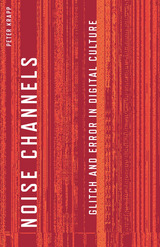 Noise Channels: Glitch and Error in Digital Culture
Peter Krapp
University of Minnesota Press, 2011 To err is human; to err in digital culture is design. In the glitches, inefficiencies, and errors that ergonomics and usability engineering strive to surmount, Peter Krapp identifies creative reservoirs of computer-mediated interaction. Throughout new media cultures, he traces a resistance to the heritage of motion studies, ergonomics, and efficiency; in doing so, he shows how creativity is stirred within the networks of digital culture. Noise Channels offers a fresh look at hypertext and tactical media, tunes into laptop music, and situates the emergent forms of computer gaming and machinima in media history. Krapp analyzes text, image, sound, virtual spaces, and gestures in noisy channels of computer-mediated communication that seek to embrace—rather than overcome—the limitations and misfires of computing. Equally at home with online literature, the visual tactics of hacktivism, the recuperation of glitches in sound art, electronica, and videogames, or machinima as an emerging media practice, he explores distinctions between noise and information, and how games pivot on errors at the human–computer interface. Grounding the digital humanities in the conditions of possibility of computing culture, Krapp puts forth his insight on the critical role of information in the creative process.
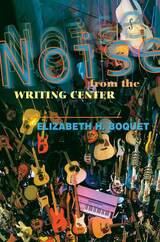 Noise From The Writing Center
Elizabeth H. Boquet
Utah State University Press, 2002 In Noise from the Writing Center, Boquet develops a theory of "noise" and excess as an important element of difference between the pedagogy of writing centers and the academy in general. Addressing administrative issues, Boquet strains against the bean-counting anxiety that seems to drive so much of writing center administration. Pedagogically, she urges a more courageous practice, developed via metaphors of music and improvisation, and argues for "noise," excess, and performance as uniquely appropriate to the education of writers and tutors in the center. Personal, even irreverent in style, Boquet is also theoretically sophisticated, and she draws from an eclectic range of work in academic and popular culture-from Foucault to Attali to Jimi Hendrix. She includes, as well, the voices of writing center tutors with whom she conducted research, and she finds some of her most inspiring moments in the words and work of those tutors.
Noise in the Night
Anne Alexander
Bodleian Library Publishing, 2018 Every night Sherri hears noises that keep her awake. There’s a tap-tap, a tick-tock, a toot-toot, and a mysterious noise that stops as soon as she calls out to the rest of the household. One night she wakes up five times and even her pet dog and cat are tired the next day. What is this worrisome noise that disturbs everyone’s sleep?
Featuring warm and quirky illustrations by Abner Graboff, this is a charming and reassuring tale for any child who is frightened by noises in the night . . . with a delightful twist at the end.
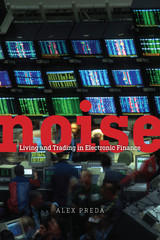 Noise: Living and Trading in Electronic Finance
Alex Preda
University of Chicago Press, 2017 We often think of finance as a glamorous world, a place where investment bankers amass huge profits in gleaming downtown skyscrapers. There’s another side to finance, though—the millions of amateurs who log on to their computers every day to make their own trades. The shocking truth, however, is that less than 2% of these amateur traders make a consistent profit. Why, then, do they do it?
In Noise, Alex Preda explores the world of the people who trade even when by all measures they would be better off not trading. Based on firsthand observations, interviews with traders and brokers, and on international direct trading experience, Preda’s fascinating ethnography investigates how ordinary people take up financial trading, how they form communities of their own behind their computer screens, and how electronic finance encourages them to trade more and more frequently. Along the way, Preda finds the answer to the paradox of amateur trading—the traders aren’t so much seeking monetary rewards in the financial markets, rather the trading itself helps them to fulfill their own personal goals and aspirations.
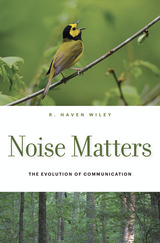 Noise Matters: The Evolution of Communication
R. Haven Wiley
Harvard University Press, 2015 Noise, as we usually think of it, is background sound that interferes with our ability to hear more interesting sounds. In general terms, though, it is anything that interferes with the reception of signals of any sort. It includes extraneous energy in the environment, degradation of signals in transit, and spontaneous random activity in receivers and signalers. Whatever the cause, the consequence of noise is error by receivers, and these errors are the key to understanding how noise shapes the evolution of communication.
Noise Matters breaks new ground in the scientific understanding of how communication evolves in the presence of noise. Combining insights of signal detection theory with evidence from decades of his own original research, Haven Wiley explains the profound effects of noise on the evolution of communication. The coevolution of signalers and receivers does not result in ideal, noise-free communication, Wiley finds. Instead, signalers and receivers evolve to a joint equilibrium in which communication is effective but never error-free. Noise is inescapable in the evolution of communication.
Wiley’s comprehensive approach considers communication on many different levels of biological organization, from cells to individual organisms, including humans. Social interactions, such as honesty, mate choice, and cooperation, are reassessed in the light of noisy communication. The final sections demonstrate that noise even affects how we think about human language, science, subjectivity, and freedom. Noise Matters thus contributes to understanding the behavior of animals, including ourselves.
The Noise of Time: Selected Prose
Osip Mandelstam
Northwestern University Press, 2002 Osip Mandelstam has in recent years come to be seen as a central figure in European modernism. Though known primarily as a poet, Mandelstam worked in many styles: autobiography, short story, travel writing, and polemic. Mandelstam's biographer, Clarence Brown, presents a collection of the poet's prose works that illuminates Mandelstam's far-ranging talent and places him within the canon of European modernism.
This volume includes Mandelstam's "The Noise of Time," a series of autobiographical sketches; "The Egyptian Stamp," a novella; "Fourth Prose;" and the famous travel memoirs "Theodosia" and "Journey to Armenia."
 The Noise Silence Makes: Secularity and Ghana's Drum Wars
Mariam Goshadze
Duke University Press, 2025 For generations, the Ga community in Accra, Ghana, has enforced an annual citywide ban on noisemaking during an important religious festival. In the 1990s and 2000s, this “ban on drumming” became a point of conflict between the Ga people and the newly popular Pentecostal/Charismatic churches, which refused to subdue their loud worship during the ban. Although the Ghanaian state constitutionally and institutionally grants superior status to Christianity and Islam, it ruled in favor of the Ga community, which emphasized its “cultural” rather than religious rights. In The Noise Silence Makes, Mariam Goshadze traces the history of noise regulation in Accra, showing how the Ga people have adopted colonial mechanisms of noise control to counter Pentecostal/Charismatic dominance over Accra’s soundscape. Goshadze shows how the drumming ban represents a reversal of the top-down model of noise regulation and illuminates the reality of Ghanaian secularity, in which the state unofficially collaborates with indigenous religious authorities to control sound. In so doing, Goshadze counters the tendency to push African “traditional religions” to the margins, demonstrating that they are instrumental players in contemporary African urbanity.
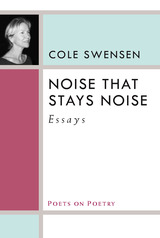 Noise That Stays Noise: Essays
Cole Swensen
University of Michigan Press, 2011 Praise for Cole Swensen: "One of the most assured voices in contemporary poetry."
---Library Journal "Engaging and delightful."
---Publishers Weekly
A volume in the Poets on Poetry series, which collects critical works by contemporary poets, gathering together the articles, interviews, and book reviews by which they have articulated the poetics of a new generation. Ezra Pound famously said that literature is "news that stays news," but recent experiments in poetry and the sciences allow us to enlarge the statement to bring information theory and biology to bear on the issue---in particular, how the information theory–based model of self-organization from noise offers a way to look at language as an art material as well as a mode of communication. This concept directs these essays on poetry by contemporary poet Cole Swensen. Noise That Stays Noise covers a variety of subjects relevant to contemporary poetry and will give the general reader a broad notion of the issues that inform discourse around poetry today. Space---the conceptual geometry of poetry and its concrete mise-en-page---is an underlying theme of this collection, sometimes approached directly through the work of other twentieth-century poets, sometimes more obliquely through considerations of the role of the visual arts in contemporary poetry. This question of space and the shapes it includes and acquires offers a different way to look at some familiar writers, such as Mallarmé and Olson, and a way to introduce several more recent writers who may not yet be known to the general public.
Noise: The Political Economy of Music
Jacques Attali
University of Minnesota Press, 1985 “Noise is a model of cultural historiography. . . . In its general theoretical argument on the relations of culture to economy, but also in its specialized concentration, Noise has much that is of importance to critical theory today.” SubStance“For Attali, music is not simply a reflection of culture, but a harbinger of change, an anticipatory abstraction of the shape of things to come. The book’s title refers specifically to the reception of musics that sonically rival normative social orders. Noise is Attali’s metaphor for a broad, historical vanguardism, for the radical soundscapes of the western continuum that express structurally the course of social development.” EthnomusicologyJacques Attali is the author of numerous books, including Millennium: Winners and Losers in the Coming World Order and Labyrinth in Culture and Society.
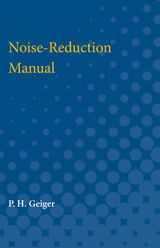 Noise-Reduction Manual
P.H. Geiger
University of Michigan Press, 1955 The Noise-Reduction Manual was prepared under the auspices of the U.S. Office of Naval Research and was originally intended to constitute the introductory sections of a more extensive study of noise-reduction problems encountered aboard ship.There is a sustained emphasis on the practical techniques for the reduction of airborne noise, the treatment of each problem tacitly deprecating the need for, and even the practical value of, mathematical investigation of noise sources and noise fields as compared to the greater importance of careful acoustical measurements designed to direct the proper use of acoustical materials and relatively simple noise-reduction techniques.Careful distinction is made between the various techniques of noise reduction at the source and the various methods of noise and vibration isolation and dissipation, greatest emphasis being devoted to the latter. After basic definitions and analysis of several causes of noise, entire chapters are devoted to absorption of airborne sound, insulation against airborne sound, vibration damping, and vibration isolation. Each chapter contains extensive discussions of the evaluation and application of the various types of acoustical materials, including selection rules, performance data, and instrumentation. The straightforward exposition should make the manual equally valuable to both the novice and expert in the field of noise reduction.
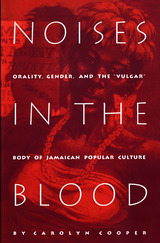 Noises in the Blood: Orality, Gender, and the"Vulgar" Body of Jamaican Popular Culture
Carolyn Cooper
Duke University Press, 1995 The language of Jamaican popular culture—its folklore, idioms, music, poetry, song—even when written is based on a tradition of sound, an orality that has often been denigrated as not worthy of serious study. In Noises in the Blood, Carolyn Cooper critically examines the dismissed discourse of Jamaica’s vibrant popular culture and reclaims these cultural forms, both oral and textual, from an undeserved neglect.
Cooper’s exploration of Jamaican popular culture covers a wide range of topics, including Bob Marley’s lyrics, the performance poetry of Louise Bennett, Mikey Smith, and Jean Binta Breeze, Michael Thelwell’s novelization of The Harder They Come, the Sistren Theater Collective’s Lionheart Gal, and the vitality of the Jamaican DJ culture. Her analysis of this cultural "noise" conveys the powerful and evocative content of these writers and performers and emphasizes their contribution to an undervalued Caribbean identity. Making the connection between this orality, the feminized Jamaican "mother tongue," and the characterization of this culture as low or coarse or vulgar, she incorporates issues of gender into her postcolonial perspective. Cooper powerfully argues that these contemporary vernacular forms must be recognized as genuine expressions of Jamaican culture and as expressions of resistance to marginalization, racism, and sexism.
With its focus on the continuum of oral/textual performance in Jamaican culture, Noises in the Blood, vividly and stylishly written, offers a distinctive approach to Caribbean cultural studies.
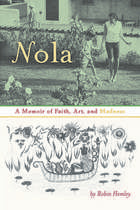 Nola: A Memoir of Faith, Art, and Madness
Robin Hemley
University of Iowa Press, 1998 The evidence at hand: an autobiography—complete with their mother’s edits—written by his brilliant and disturbingly religious sister; a story featuring actual childhood events, but published by his mother as fiction; the transcript of a hypnotherapy session from his adolescence; and perjured court documents hidden in a drawer for decades. These are the clues Robin Hemley gathers when he sets out to reconstruct the life of his older sister Nola, who died at the age of twenty-five after several years of treatment for schizophrenia. Armed with these types of clues, Hemley quickly discovers that finding the truth in any life—even one’s own—is a fragmented and complex task.
Nola: A Memoir of Faith, Art, and Madness is much more than a remembrance of a young woman who was consumed her entire life by a passion for finding and understanding God; it is also a quest to understand what people choose to reveal and conceal, and an examination of the enormous toll mental illness takes on a family. Finally, it is a revelation of the alchemy that creates a writer: confidence in the unknowable, distrust of the proven, tortuous devotion to the fine print in life, and sacrifice to writing itself as it plays the roles of confessor, scourge, and creator.
Upon its first release in 1998, Nola won ForeWord’s Book of the Year Award for biography/memoir, the Washington State Book Award for biography/memoir, and the Independent Press Book Award for autobiography/memoir.
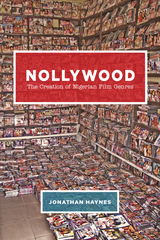 Nollywood: The Creation of Nigerian Film Genres
Jonathan Haynes
University of Chicago Press, 2016 Nigeria’s Nollywood has rapidly grown into one of the world’s largest film industries, radically altering media environments across Africa and in the diaspora; it has also become one of African culture’s most powerful and consequential expressions, powerfully shaping how Africans see themselves and are seen by others. With this book, Jonathan Haynes provides an accessible and authoritative introduction to this vast industry and its film culture.
Haynes describes the major Nigerian film genres and how they relate to Nigerian society—its values, desires, anxieties, and social tensions—as the country and its movies have developed together over the turbulent past two decades. As he shows, Nollywood is a form of popular culture; it produces a flood of stories, repeating the ones that mean the most to its broad audience. He interprets these generic stories and the cast of mythic figures within them: the long-suffering wives, the business tricksters, the Bible-wielding pastors, the kings in their traditional regalia, the glamorous young professionals, the emigrants stranded in New York or London, and all the rest. Based on more than twenty years of research, Haynes’s survey of Nollywood’s history and genres is unprecedented in scope, while his book also vividly describes landmark films, leading directors, and the complex character of this major branch of world cinema.
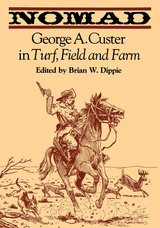 Nomad: George A. Custer in Turf, Field, and Farm
Edited by Brian W. Dippie
University of Texas Press, 1980 Between 1867 and 1875, George Armstrong Custer contributed fifteen letters under the apt pseudonym Nomad to the New York-based sportsman's journal Turf, Field and Farm. Previously available only in a collector's typescript edition, the Nomad letters offer valuable insight into the character of the Boy General as he gives expression to his abiding love for hunting, horses, and hounds. Vivid accounts of days in the field after buffalo and deer alternate with letters that attest to Custer's passion for Kentucky thoroughbreds and trotters and his devotion to his favorite hunting dogs. Moreover, the letters show Custer as a student of literature who constandy alluded to works of fiction and drama and who loved to quote poetry as he self-consciously honed his skills as a writer. The Nomad letters also open the way to controversy since three of the letters written in 1867, as Brian Dippie's careful annotations make clear, offer a strikingly different account of Custer's ill-starred induction into Indian fighting than the accepted version recorded five years later in his memoirs, My Life on the Plains. Composed only a few months after the abortive Hancock Expedition that led to Custer's court-martial and suspension from rank and pay for one year, the Nomad letters are full of a passion and venom absent from My Life on the Plains. They provide an immediate response to the events of 1867 that will interest all students of the Western Indian wars and of Custer's fascinating career.
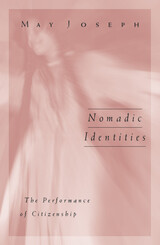 Nomadic Identities: The Performance Of Citizenship
May Joseph
University of Minnesota Press, 1999 A look at citizenship through the lens of performance. In a modern world of vast migrations and relocations, the rights—and rites—of citizenship are increasingly perplexing, and ever more important. This book asks how citizenship is enacted when all the world’s the stage. Kung Fu cinema, soul music, plays, and speeches are some of the media May Joseph considers as expressive negotiations for legal and cultural citizenship. Nomadic Identities combines material culture and historical approaches to forge connections between East Africa, India, Britain, the Caribbean, and the United States in the struggles for democratic citizenship. Exploring the notion of nomadic citizenship as a modern construct, Joseph emphasizes culture as the volatile mise-en-scène through which popular conceptions of local and national citizenship emerge. Joseph, an Asian African from Tanzania, brings a personal insight to the question of how citizenship is expressed—particularly the nomadic, conditional citizenship related to histories of migrancy and the tenuous status of immigrants. Nomadic Identities investigates the metaphoric, literal, and performed possibilities available in different arenas of the everyday through which individuals and communities experience citizenship, successfully or not. A unique inquiry into contemporary experiences of migrancy linking Tanzania, Britain, and the United States, this book blends political theory, performance studies, cultural studies, and historical writing. It offers vignettes that describe the official and informal cultural transactions that designate citizenship under the globalizing forces of decolonization, the cold war, and transnational networks.Crossing the globe, Nomadic Identities provides fresh insights into the contemporary phenomena of territorial displacement and the resulting local and transnational movements of people.
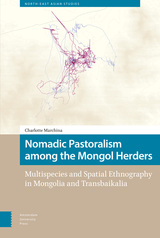 Nomadic Pastoralism among the Mongol Herders: Multispecies and Spatial Ethnography in Mongolia and Transbaikalia
Charlotte Marchina
Amsterdam University Press, 2021 Nomadic Pastoralism among the Mongol Herders: Multispecies and Spatial Ethnography in Mongolia and Transbaikalia is based on anthropological research carried out by the author between 2008 and 2016 and addresses the spatial features of nomadic pastoralism among the Mongol herders of Mongolia and Southern Siberia from a cross-comparative perspective. In addition to classical methods of survey, Charlotte Marchina innovatively used GPS recordings to analyze the ways in which pastoralists envision and concretely occupy the landscape, which they share with their animals and invisible entities. The data, represented in abundant and original cartography, provides a better understanding of the mutual adaptations of both herders and animals in the common use of unfenced pastures, not only between different herders but between different species. The author also highlights the herders' adaptive strategies at a time of rapid sociopolitical and environmental changes in this area of the world.
NOMADIC VOICES: CONRAD AND THE SUBJECT OF NARRATIVE
Bruce Henricksen
University of Illinois Press, 1992 "A highly intelligent and
successful study exploring the uncanny features of Conrad's art that respond,
and lend depth, to the concerns of theorists such as Bakhtin and Lyotard."
-- Suresh Raval, University of Arizona
|
|
